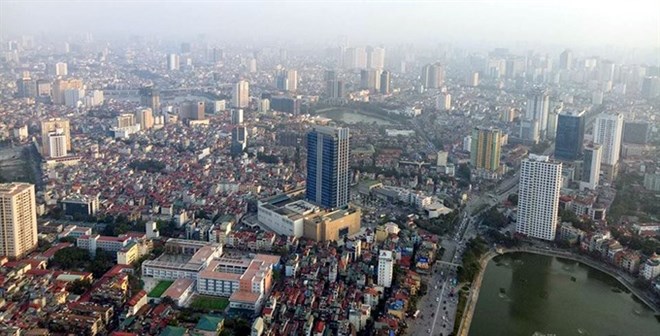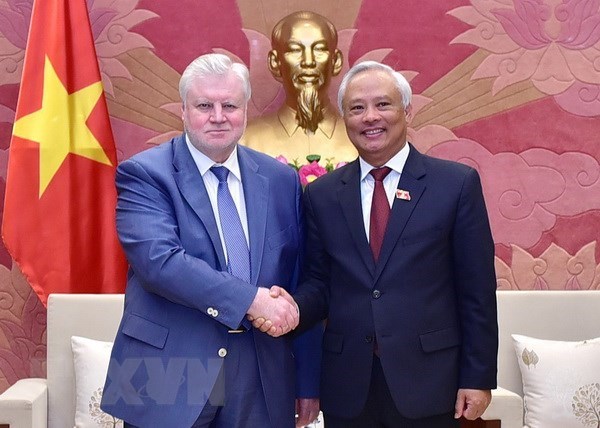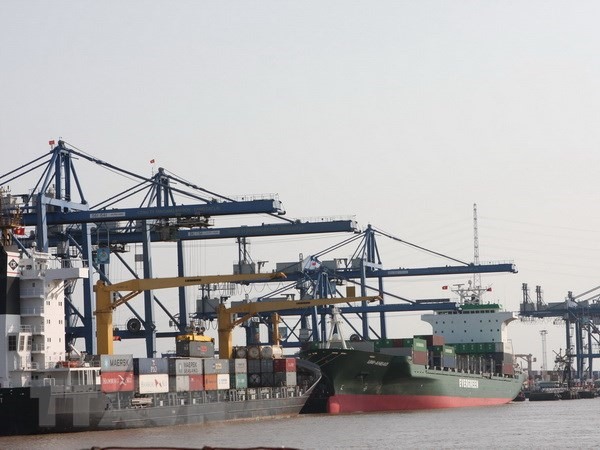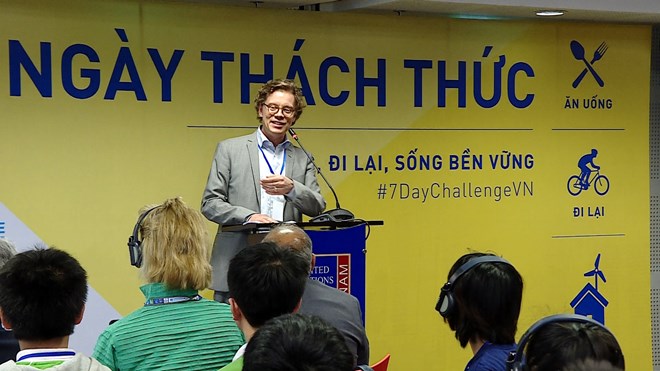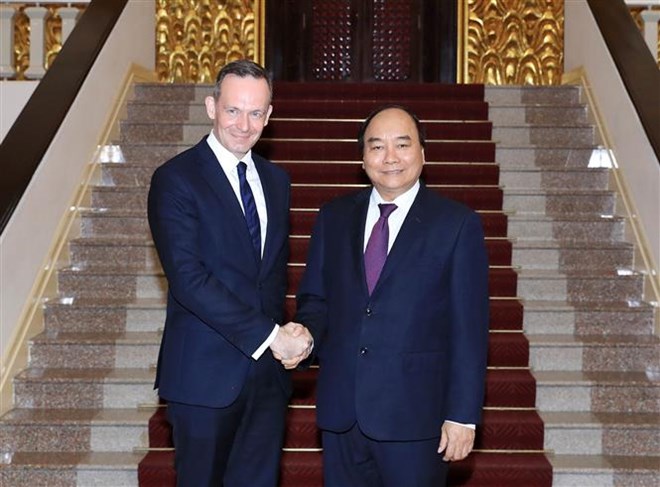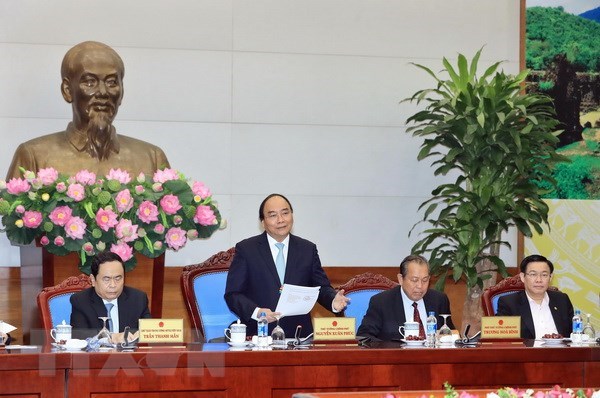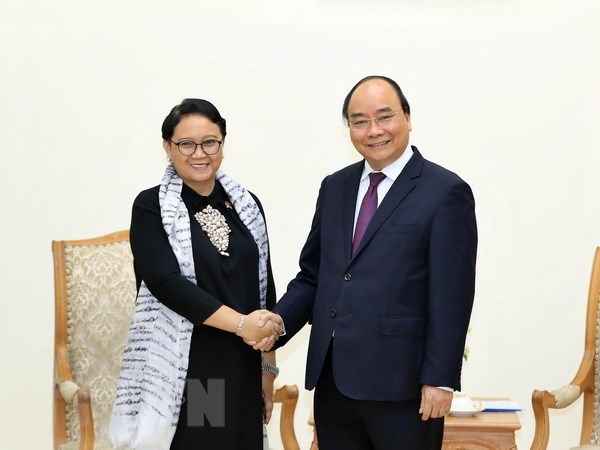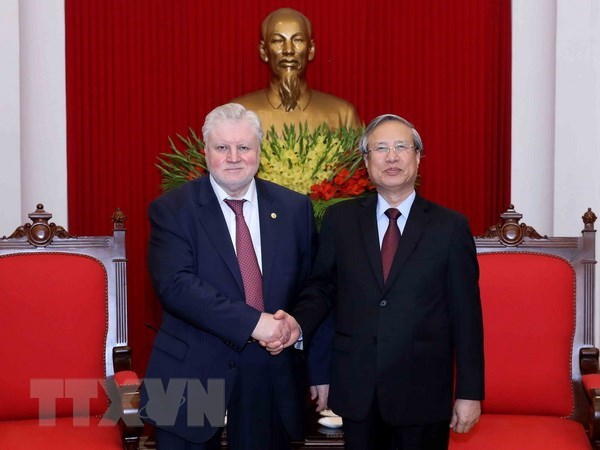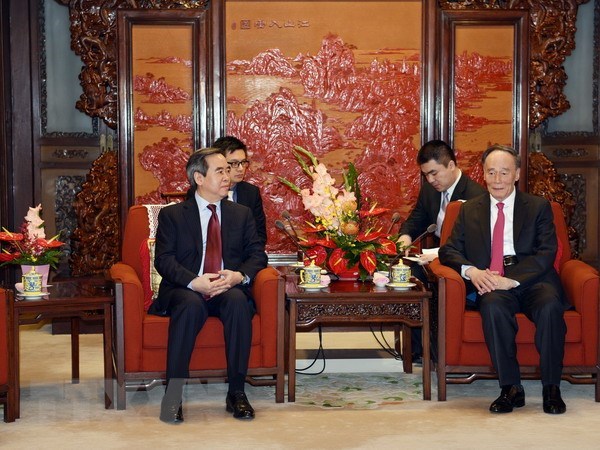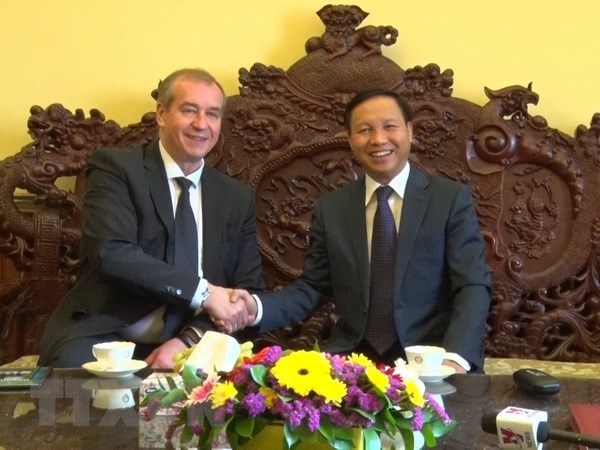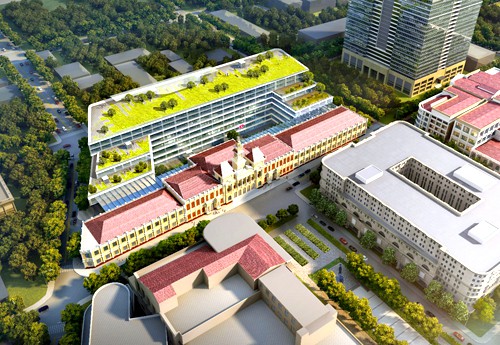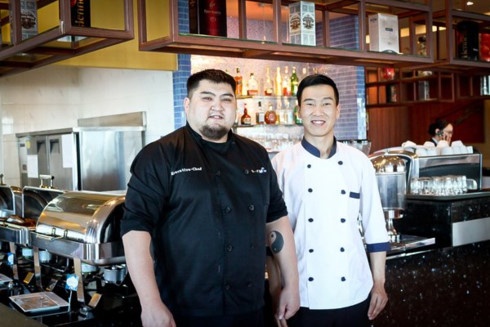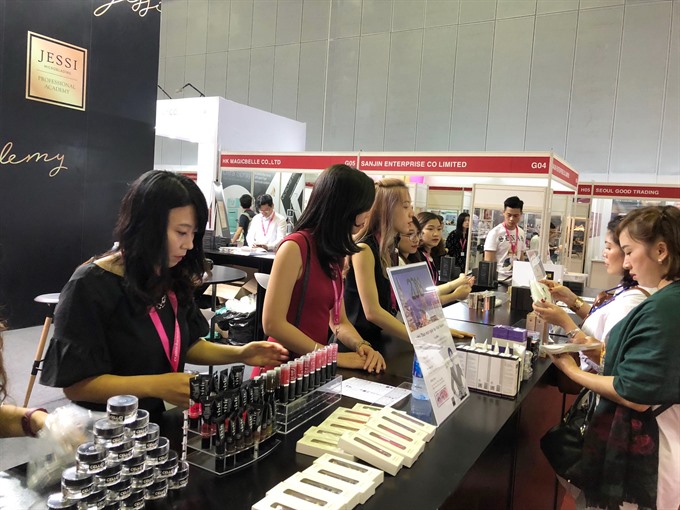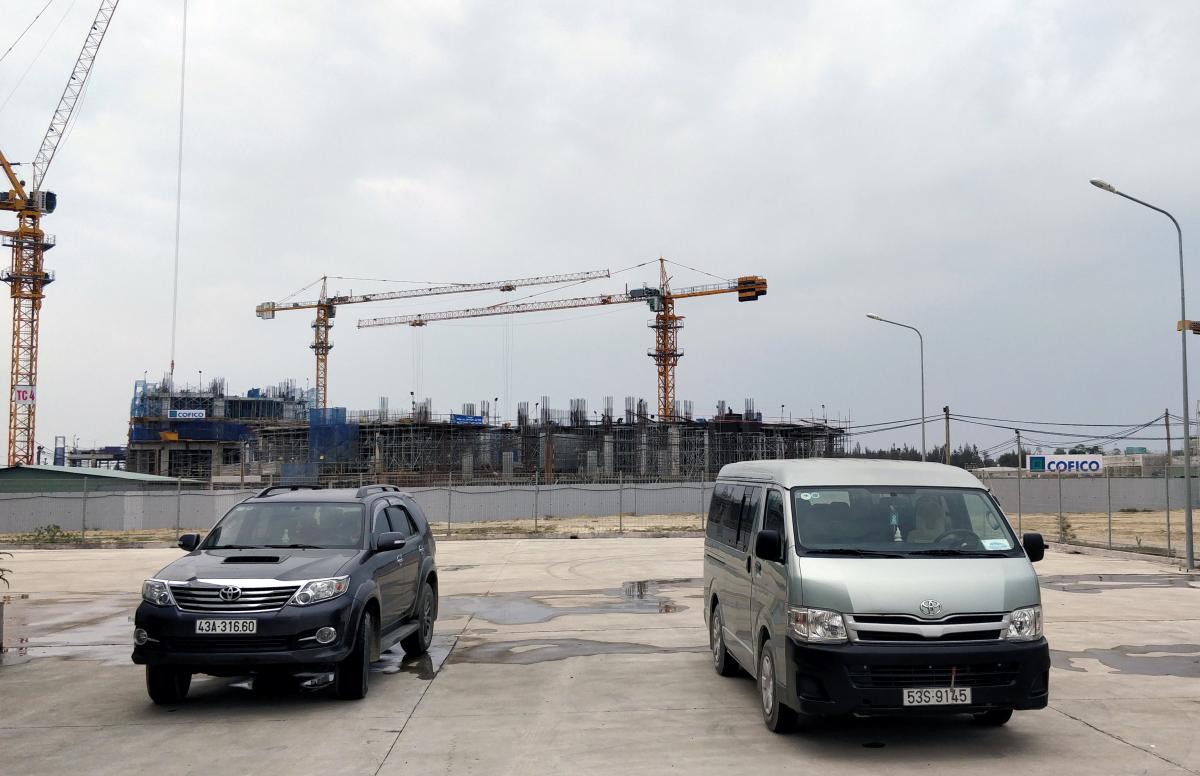Ministry of Finance proposes new housing tax The Ministry of Finance has proposed a tax on houses depending on their construction value as part of a draft law on property tax.
A view of high-rise buildings around Ngoc Khanh area in Hanoi Under the proposed law, there are two options: imposing tax on houses with construction value of either more than 700 million VND (30,800 USD) or 1 billion VND (44,000). The proposed tax rate is 0.3 or 0.4 percent annually, with only the surplus construction value above the proposed threshold to be taxed. For example, if the threshold is set at 700 million VND, the owner of a 1.7 billion VND (74,800 USD) house would have to pay tax on 1 billion VND, equivalent to 3-4 million VND (132-176 USD) per year. The construction value of a house is determined by factors including its type, scale and how many years it has been in use since construction. If the tax on houses worth more than 700 million VND is applied, the finance ministry will be able to collect property tax of about 23.3 trillion VND (1.01 billion USD) to 31 trillion VND (1.4 billion USD) per year. If the second option is approved, the tax collection is estimated to vary from 22.7 trillion VND (987 million USD) to 30.3 trillion VND (1.3 billion USD). The ministry currently favours taxing houses worth more than 700 million VND at a rate of 0.4 percent. According to Pham Dinh Thi, director of Ministry of Finance’s Tax Policy Department, data from other countries show that the lowest property tax rate stands at 0.2 percent. However, countries mostly apply high rates like Indonesia’s 0.5 percent and 1-2 percent in the Philippines. He said taxing houses and trade-service construction work will impact enterprises’ production and business. The draft is scheduled to be submitted to the National Assembly for feedback in 2020. The ministry is also seeking to increase land tax. Under the same draft law, land taxes in some categories might rise by multiple times compared with those currently stated in the Law on Non-Agricultural Land Use Taxes. For example, housing land might get a 0.3 to 0.4 percent tax rate, ten times higher than current minimum rate of 0.03 percent. The draft law on property tax also proposes tax on personal vehicles such as planes, yachts and cars worth more than 1.5 billion VND (65,000 USD). Truong Thanh Duc, chairman of the BASICO Law Firm, said a property tax law is necessary, however, “people’s incomes must be taken into consideration when studying the law enforcement,” he said. Dang Hung Vo, former Deputy Minister of Environment and Natural Resources, agreed with the land tax hike by ten times, saying that housing land tax of 0.4 percent, 0.5 percent-tax on business, trade and service land are reasonable. In the future, it could be increased to 0.7 to 1 percent. If land tax is high, land prices will fall, while if the tax is low, speculative hoarding might happen. If the tax is high, anyone who wants to buy land must consider whether they can afford the tax or not, he said. However, he opposed the housing property tax proposal, adding that developed countries impose housing tax depending on house area (not on value). Nguyen Anh Tu, a State officer living in Hanoi, said that a house in Hanoi and HCM City cannot be bought for less than 700 million VND. “I had to borrow 70 percent of the house value from the bank to afford the payment, not to mention additional fees. Now if I have to pay an annual property tax, I don’t know when I could pay off the debt,” he said. Finance and banking specialist Nguyen Tri Hieu said imposing tax on land and houses is crucial to create equality in owning properties. However, the property tax law should require land tax only. “People already pay personal income tax. There will be overlapping taxes if we require people to pay tax on the money they use to buy a house,” he said. Le Hoang Chau, President of Ho Chi Minh City Real Estate Association, said if the law takes effect, the real estate market will be impacted, slowing business and investment activities. Disagreeing with the proposal, the Ho Chi Minh City Real Estate Association proposed no tax on houses worth less than 1 billion VND to support low-income and low middle-income people. Chau also proposed a 0.4 percent-tax on housing land, apartment building land and houses worth more than 1 billion VND. VNA |
Article 2
↧
↧
Article 1
Vietnam jails former intelligence officer for threatening to leak classified docs to ChinaHe also offered to sell the documents to foreign media A Ho Chi Minh City court has sentenced a former intelligence officer to eight years in prison for crimes he committed in 2016, including threatening to reveal confidential documents to China and foreign media. He had stolen the information with the intention of using it to demand money from Vietnamese police to spend on some high-stake gambling in Cambodia. The People’s Court of Ho Chi Minh City found Nguyen Hoang Duong, 33, guilty of espionage and extortion of property in a ruling on Monday, handing him jail terms of seven years and one year for the respective crimes. He will serve eight years behind bars in total. According to his indictment, Duong was an intelligence officer working at the Professional and Technical Services Department under Vietnam’s Ministry of Public Security. He took a leave between August 29 and September 26, 2016, but was found to have returned to his office in Ho Chi Minh City on September 18, 2016 to steal secret information. Duong used a CD to store classified police documents from a computer and intended to use it to blackmail Vietnamese police. He made his way to Cambodia the next morning, September 19, 2016, and soon lost all his cash to the games of luck there. Duong pulled a few more unsuccessful attempts to find his luck by using ‘emergency’ money sent to him by his younger sister and Duong Danh Kiem, the police chief at his division. Desperate, he took photos of the CD and used them to blackmail Kiem into sending him more money, threatening to sell the classified information to the Chinese Embassy in Cambodia and foreign media if his demand was not met. On September 27, 2016, Duong was captured by Cambodian police and handed over to Vietnamese officers, who allowed him to go home to write a report on his wrongdoings. Released, Duong once again made his way back to Cambodia for gambling, where he continued to lose all his money. Investigators found that Duong had made multiple attempts during this period to contact the Chinese Embassy in Cambodia and the Radio Free Asia broadcasting station with the intention of selling them the classified documents. On October 2, 2016, Duong was captured at an ATM booth in Cambodia as he was trying to withdraw money sent by a colleague. Duong had destroyed the CD before being taken into custody by Vietnamese police. He confessed to all of the charges at Monday’s court in Ho Chi Minh City. |
↧
Article 0
Xam (blind busker’s singing) is on the way to revitalisation in the northern port city of Hai Phong since more and more local people and tourists are coming to admire the traditional musical art.
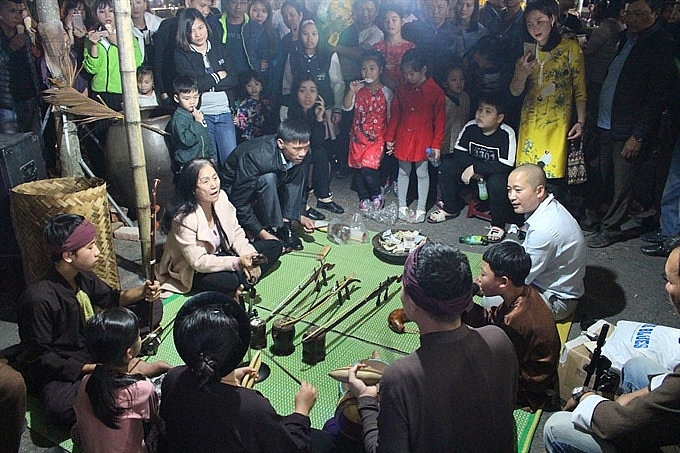 Admiration: Crowds gather to watch a chieu Xam performance at the traditional festival in Le Chan District, Hai Phong City in March Over the past two years, performances of the folk music have appeared in celebrative events and cultural festivals in the city, as well as in surrounding localities. Common venues are pagodas and temples, and even in family parties. Known locally as chieu Xam, it is a group of three or five traditional musicians performing on a mat in the public places including parks and cafes. Ha Quang Huy, 42, a visitor from Hanoi said that he was impressed by a Xam singing festival held last weekend at the Hao Khe cultural communal house in Hai Phong’s Le Chan District. The show was held to pay tribute to Xam ancestors and to commemorate the 6th festival of the traditional musical art in the city. The event gathered many Xam groups from northern regions including Hanoi and the provinces of Quang Ninh, Thai Binh, Bac Ninh and Ninh Binh. Huy said that was the first time he’d watched such a folk performance held outdoors in a public space, and it made him very excited. “I had watched it on the television from time to time and seen it on social networks, or listened to it on the radio, but watching it directly was amazing,” said Huy. The tourist said he and all of his accompanying friends who watched the show found the singing to be unique and special, and very different from the modern music that is popular today. He hopes to have more chances to admire it whenever visiting the coastal city. Nguyen Van Son, 70, a citizen from Hai Phong’s Ngo Quyen District who was one of the many frequent viewers of the folk singing, said he’d been fond of the singing since he was a child, but hadn’t had the chance to watch it for a very long time. This all changed in 2015. He said that in modern life, with the boom of globalisation, some traditional musical performances had been ignored. The Xam singing has made a stand to reemerge in the last two years. “It’s really good news for the many traditional music lovers like me,” said Son. The reappearance of chiếu Xam and many other styles of folk music interested him so much that whenever there was a show, he would be sure to come along to admire, said Son. The faithful fan of the folk singing said the music and words in each of its artistic episodes was full of ethical and traditional messages. “All of them can touch deeply inside our souls,” said Son. The increasing number of active fans of Xam singing in Hai Phong has stirred a wave among folk musicians looking to recover and preserve it. Among them is Dao Bach Linh, 37, a young Xam singer and head of the Hai Thanh Xam Club in Hai Phong. Linh said an increasing support and passion from the people in the city had encouraged him to try to perform the musical art. “Whether they are held indoors or outdoors, in public places or cafes, all of the chieu Xam performances attract a large crowd,” he told Viet Nam News. The performer said that sometimes he would keep playing until midnight, repeating his set again and again, and the audience didn’t get bored of watching. Spectators of the performances tend to include people of all classes, ages, genders and occupations, he said. Often they join in and sing along with him. The Hai Thanh Xam Club, founded in 2013, is the first club to support old style Xam singing in Hai Phong. With more than 20 members, the club regularly performs at festivals and celebrations in the city. “To have the club operating professionally and regularly like it does now meant overcoming many challenges in the first days of its establishment,” said Linh. Linh’s friends and audiences refer to him as Linh Xam, in honour of his contribution to the preservation of the traditional music. Linh said he’d known about the traditional folk songs since he was at university, where he first heard it listening to the radio station, Voice of Vietnam. From then on he was inspired to learn the art of folk music and he enrolled in classes at the Vietnam Musical Development Centre. He went as far as to visit the home of Ha Thi Cau - the well-known late folk singer from the northern province of Ninh Bình, to ask for her help to study Xam. Linh said it took several years for him to follow in the steps of Cau and many others old Xam singers from different areas across northern Vietnam. Along with the operations of the Hai Thanh Xam Club, Linh worked as volunteer teacher for a Xẩm singing class in the city’s school of disabled students. The art of Xam folk music in Hai Phong has been popular since the early 20th century, according to Linh. It began as a way for the city’s many poor residents to make a living. The music was close to being lost from memory, until around 2005, when the State and city cultural authorities promoted a campaign to restore and preserve it. |
↧
Article 2
Vietnamese start-ups have invested US$129 million in fintech and the industry is forecast to continuously attract heightened investor interest next time, according to the Ernst & Young (EY) ASEAN FinTech Census 2018. According to Varun Mittal, EY ASEAN fintech leader, with a population of young smart phone users, high consumer growth and low unemployment, Vietnam is becoming a promising market for fintech developers.
 Vietnam’s fintech attracted hundreds of millions of dollars from investment funds “Foreign investors are also more interested in buying some fintech companies due to the huge market potential," said Mittal. The number of incubators and accelerators and innovation labs in Vietnam is estimated at 24, the second most among ASEAN region, following Singapore. However, another EY report showed that up to 90 percent of payments in the country were made in cash. Therefore, Vietnamese fintech companies are focusing on the field of payment with 47 percent of Vietnamese companies working on payment services, the highest rate in the region. According to Nguyen Thuy Duong, EY Vietnam deputy director and vice chairwoman of the club, Vietnam Financial Technology Club, said that fintech companies are currently small scale and policies for these companies are lacking. Apart from financial issues, shortages in staffs and governmental regulations are two major challenges that Vietnamese and regional fintech companies face. EY experts said that policy support from authorities will form the foundation for a fintech ecosystem that encourages creativity and healthy competition. Though fintech is still in the early stage of development in Vietnam, it has attracted hundreds of millions of dollars from investment funds. Vietnam currently has 78 fintech companies, many of which have received investments from foreign and domestic investors. By the end of this year, the amount of fintech companies in Vietnam receiving investments is likely to increase five times. Typically, UTC Investment from South Korea last year spent VND542 billion to acquire a 65 percent stake of VNPT Epay, while SEA has a 45 percent stake in VNPAY. A series of investment deals were made in 2016, including $28 million by SCPE and Goldman Sachs in Momo e-wallet, and Credit China Fintech’s acquisition of a 51 percent stake of Amigo Technologies. Foreign investors have poured money into Vietnam fintech firms as they can see the great potential in the market, analysts said. The 4.0 industry revolution with e-payment solutions is irreversible and Vietnam will have to follow the trend. Vietnam has 45 million internet users, ranking sixth in Asia, while its internet penetration- population ratio was 48 percent in 2015, higher than the Asian average level of 38 percent and the world level of 45 percent. According to VIRAC, a market analysis firm, by June 2017, the number of bank cards issued had reached 121.5 million. There are 76 institutions which provide payment services via internet and 39 institutions which provide mobile payment services. However, despite the good payment infrastructure, most of the card transactions are made to withdraw cash, accounting for 87 percent. This is both a challenge and opportunity for fintech to develop. The proportion of online shoppers in Vietnam is now at the average level compared with other regional countries. The conversion rate from the number of visits to websites into orders remains very low compared with traditional retailing. Analysts noted that commercial banks were joining forces with fintech firms to develop financial services. The Military Bank (MB) has joined hands with Startup Fintech to develop a technology which allows users to carry out transactions on Facebook’s Messenger app, while VP Bank has been working with Fintech Timo. The 2015-2017 period witnessed a boom of fintech firms with the appearance of MoMo, Payoo, 123pay and Finsom. |
↧
Article 1
Government News 17/4 Russian oblast ready to facilitate Vietnamese firms’ investment
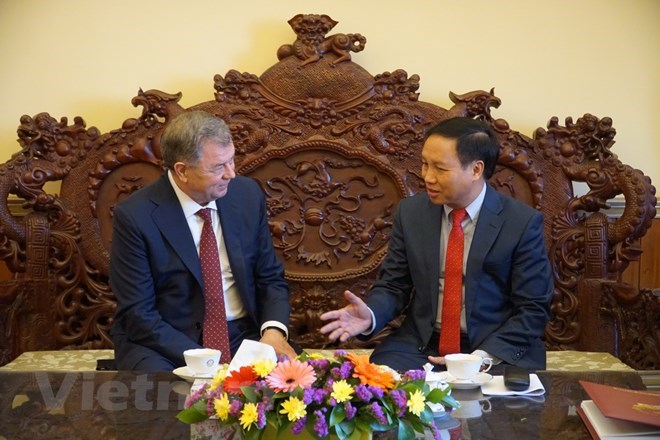 Governor of Kaluga Oblast Artamonov Kaluga Anatoly Artamonov (L) and Vietnamese Ambassador Ngo Duc Manh Russia’s Kaluga Oblast is willing to give incentives and help Vietnamese enterprises invest in the region, a local official has said. Governor of Kaluga Oblast Artamonov Kaluga Anatoly Artamonov made the statement during a working session with representatives from the Vietnamese Embassy in Russia on April 16. Artamonov, head of the Russian region that has the largest cooperation project with Vietnam in a dairy factory invested by TH True Milk, informed Vietnamese Ambassador Ngo Duc Manh about the progress of the project. The two sides exchanged views on the progress of the project and discussed measures to remove difficulties for enterprises. Artamonov said the region has provided favourable conditions for Vietnamese firms, but issues related to procedures for Vietnamese labourers to work in the plant must be solved at the government level. For his part, Ambassador Manh thanked Kaluga’s officials for their aid for Vietnamese enterprises and labourers, affirming that the embassy will help Vietnamese businesses expand in Russian. He proposed and Artamonov welcomed Manh’s idea of establishing a cooperative relationship between Kaluga and a Vietnamese locality. In an interview with Vietnam News Agency’s correspondents in Russia, Artamonov said that through his visits to TH True Milk’s project, he admired technologies that the Vietnamese side has prepared for the project. He expressed his belief that when investing in Russia and in Kaluga in particular, the dairy enterprise is capable of supplying not only to the Russian market but also other markets. Kaluga has preferential policies to make it easy for Vietnamese enterprises to invest in Kaluga, he affirmed. Vietnamese workers can also find job opportunities in garment and agriculture businesses in Kaluga with good wages, he noted. Cooperation between the Vietnamese side and Kaluga is now more convenient as the railway from Kaluga to China has been cleared. Kaluga is currently supplying poultry to Vietnam, and is considering the possibility of cooperating with Vietnam in raising poultry in the country. Shrimp farming is another cooperative direction that Artamonov suggested to Vietnamese enterprises in the context that Vietnamese enterprises are having difficulties in exporting shrimp to Russia. HCM City, Greece’s Edessa city seek stronger cooperation
Le Thanh Liem, Vice Chairman of the HCM City People’s Committee (middle), and the Greek guests. Ho Chi Minh City has suggested Greece’s Edessa city increase activities to connect businesses of the two localities, as well as trade promotion programmes. Le Thanh Liem, Vice Chairman of the HCM City People’s Committee, made the suggestion at a reception for a delegation of three vice mayors of Edessa city on April 16. He emphasised the trading of farm produce between the two sides, focusing on cherry from Edessa and coffee and dragon fruit from HCM City. HCM City always pays attention to reinforcing cooperation with foreign partners, including Greece, the official said, noting that the city is willing to create the best possible conditions for Greek firms, including those from Edessa, to invest in the city. HCM City also stand ready to intensify information sharing, exchange between businesses of the two cities and trade promotion in such areas as tourism and culture, Liem added. Anastasious Diou, head of the delegation, said as the first Greek locality to organise a working trip to Vietnam, Edessa wants to establish the friendship with Vietnamese localities, including HCM City. The Greek side hopes that following the trip, there will be more exchange activities in culture, trade and investment between Edessa and HCM City and other localities of Vietnam, he said. He called on leaders of HCM City to create favourable conditions for cooperation between both sides’ businesses, particularly in potential areas like fruit and tourism. He also committed to facilitating the friendship and cooperation between the two localities in the time ahead. Vietnam treasures ties with Russia: Vice NA Chairman
Vice Chairman of the National Assembly Uong Chu Luu (right) and head of the Just Russia party Sergey Mikhailovich Mironov Vietnam always treasures and wishes to enhance the fruitful relationship with Russia, for pragmatic interests of both sides, said Vice Chairman of the National Assembly Uong Chu Luu. At a reception for head of the Just Russia party Sergey Mikhailovich Mironov in Hanoi on April 16, Luu said leaders and parliamentarians of the two countries have regularly held meetings and supported each other’s viewpoints on issues of shared concern. Applauding contributions made by parliamentarians from the Just Russia party and Mironov to consolidating and promoting the bilateral relations, the Vietnamese official urged them to work harder to foster the ties across fields, especially in economy and trade, in order to soon bring two-way trade to 10 billion USD. He took the occasion to call for support for the Vietnamese community in Russia. In reply, Mironov highlighted the thriving economic links, along with cultural and tourism cooperation between Vietnam and Russia. He congratulated Vietnam on successfully hosting the 26th Annual Meeting of the Asia-Pacific Parliamentary Forum (APPF-26) last January. Stressing similar views shared by Vietnam and Russia on international issues, Mironov noted his hope that his visit will help intensify the friendship between the two countries. Vietnam, Japan audit agencies urged to lift cooperative ties
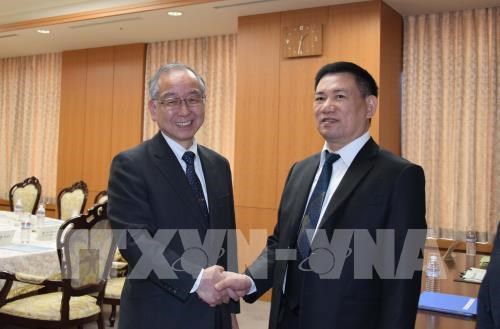 President of the Audit Commission of Japan Teruhiko Kawato (L) and Auditor General of the State Audit Office of Vietnam Ho Duc Phoc in a recent meeting in Japan President of the Audit Commission (AC) of Japan Teruhiko Kawato has suggested Vietnam and Japan elevate bilateral audit cooperative relations to a new height. In a recent interview granted to Japan-based Vietnam News Agency (VNA) correspondents, Kawato highlighted the close cooperation between the AC and the State Audit Office (SAV) of Vietnam and their efforts to urge audit agencies in Asia to enhance international links. According Kawato, the AC and the SAV has built close cooperative ties, and Vietnam’s economy is strongly developing, especially in infrastructure development – a crucial field of the auditing activities. He stressed that the collaboration between the two agencies through capacity development and research activities has proven effective and the partnership should be developed to a new level. Kawato expressed his belief that Vietnam, as the Chair of the Asian Organisation of Supreme Audit Institutions (ASOSAI) for the 2018-2021 tenure, will successfully host the 14th Assembly of ASOSAI in September 2018. Japan, as the Capacity Development Administrator of ASOSAI, will strongly support Vietnam, he affirmed. During the interview, Kawato also emphasised that ASOSAI aims to promote cooperation and mutual understanding among its member supreme audit institutions (SAIs) through sharing experience and knowledge in financial supervision. The organization has also worked to enhance the quality of auditing activities through bettering auditors’ capability and supporting member SAIs, he added. The AC President also highlighted the increasingly important role of audit institutions, saying that ASOSAI wants to make effective contributions by improving its member audit bodies’ capacity after studying their needs. Kawato said that in order to develop the economy smoothly, transparency and accountability of administrative agencies are indispensable, and auditing bodies are responsible for assuming this important role. Can Tho ceremony marks 45 years of Vietnam-France ties
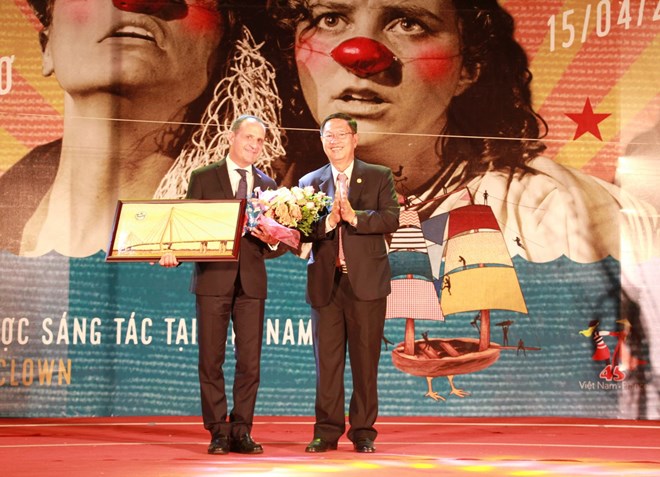 Le Van Tam, Vice Chairman of Can Tho People’s Committee (R) presens a gift to Vincent Floreani, French Consul General in Ho Chi Minh City at the ceremony (Source: baocantho.com.vn) A ceremony was held in the Mekong Delta city of Can Tho on April 15 to mark the 45th anniversary of the Vietnam-France diplomatic relations (April 12). Addressing the event, Le Van Tam, Vice Chairman of the municipal People’s Committee said that during the past 45 years, the friendship and cooperation between Vietnam and France have been expanded in many areas, including economics, culture, education-training, and science-technology. The Vietnamese Government has always paid great attention to developing ties with France, one of its prioritised partners in Europe, he noted. He also underscored that Can Tho has maintained and strengthened the teaching of French in schools, while adding optional subjects related to tourism and trade within relations with France to higher education training programmes. Currently, Can Tho is hosting five French-funded projects worth about 5.3 million USD. Vincent Floreani, French Consul General in Ho Chi Minh City highlighted the significant meaning of the celebration of the 45th anniversary of the Vietnam-France diplomatic relations, which he described as a good opportunity to introduce French culture to Vietnamese friends, thus contributing to strengthening the solidarity, friendship and mutual understanding between people of France and Vietnam as well as Can Tho in particular. The diplomat pledged to encourage more investors, art troupes and tourists of France to visit Can Tho and seek partnership in the locality’s prioritised sectors such as infrastructure construction, transportation, health care, education and tourism. France will also create optimal conditions for closer connection between the two sides in producing and exporting agricultural products to France. Along with French food and publications, participants at the event had a chance to enjoy circus performances from Be Clown art troupe of France. |
↧
↧
Article 0
Vinasun cuts revenue forecast Taxi firm Vietnam Sun Corporation (Vinasun) plans to cut its full-year revenue for the fourth time for 2018 due to rising competition from foreign ride-hailing firms. 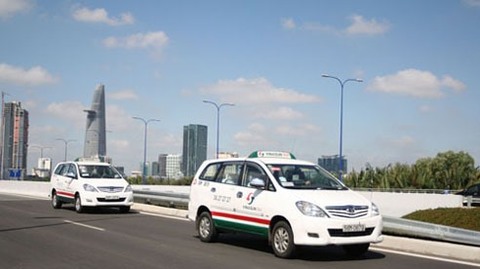 The figure for 2018 could be set at VND2.16 trillion (US$96 million), down VND1.07 trillion year-on-year, of which transportation and merchandise income would account for VND2 trillion and the remainder would come from asset sales. Vinasun also forecasts its post-tax profit for this year would be VND95 billion, half of the figure in 2017. This is the lowest figure for the firm in the past nine years. The earnings forecast would be submitted for approval at the firm’s annual shareholder meeting, which is scheduled for April 27. The company has not yet published its full-year financial report for 2017. In 2018, the taxi company will focus on preserving its market share and keeping its business operating properly in the face of strong competition from rival ride-hailing applications. In order to do that, Vinasun will buy at least 700 high-quality vehicles, develop its non-cash payment methods and diversify its business co-operation models. In addition, Vinasun will propose the transport ministry categorise business activities of ride-hailing applications to assure a fair market for domestic taxi firms. Vinasun has reported slower growth rates in both net revenue and profit since the two ride-hailing applications Uber and Grab entered Viet Nam in mid-2014. From 2010-15, Vinasun’s net revenue increased from over VND1.64 trillion to VND4.25 trillion. The HCM City-based taxi company also recorded that its post-tax profit grew from VND179.4 billion to VND329.3 billion. In 2016, however, the company’s net revenue grew at a slower pace to reach VND4.5 trillion, while its post-tax profit fell to roughly VND312 billion. In the first half of 2017, Vinasun performed even worse as its net revenue dropped 16 per cent year on year to VND1.9 trillion and its post-tax profit declined by a third to VND100 billion. The taxi firm is listing nearly 68 million shares on the HCM Stock Exchange. Its shares have dropped gradually by nearly 60 per cent since September 28, 2016 to close Monday at VND13,400 (60 US cents) per share. Tougher taxi market after merger According to Vinasun’s deputy general director Ta Long Hy, the merger between Uber and Grab in Viet Nam could result in a monopolistic taxi market and local taxi companies could suffer from such a market condition. After Uber and Grab merged, the total number of ride-hailing app vehicles had increased to 78,000 across the country and that number was much bigger than 20,000 traditional taxis in Viet Nam, he said. “The number of high-tech taxis is accounting for 80 per cent of the overall market, which could lead to a market monopoly for the foreign firm. And it is the question on how the Government would solve the problem,” cafef.vn cited Hy as saying. Traditional taxi firms would have to adapt to new market conditions, he said. Vinasun has developed an application to meet rising demand from customers and keep up with market trends. In the near future, both taxi drivers and passengers would know exactly how much a fixed trip would cost based on the expected travel distance in the application, just like other ride-hailing firms, instead of using the meter to calculate the fares for passengers, he said. VNS |
↧
Article 1
BUSINESS IN BRIEF 18/4 Dialogue talks Vietnam – Iran business opportunities A Vietnam – Iran business dialogue took place in Hanoi on April 17 to discuss business opportunities between the two countries. The event was co-organised by the Vietnam Chamber of Commerce and Industry (VCCI), the Vietnam – Iran Business Council and Iranian Embassy in Vietnam on the occasion of the ongoing visit by Speaker of the Parliament of Iran Ali Ardeshir Larijani. Speaking at the dialogue, VCCI Vice President Doan Duy Khuong said bilateral ties have grown towards lifting two-way trade to 2 billion USD, with a focus on oil and gas, telecommunications, agriculture and aquatic products. Two-way trade hit 164.6 million USD last year, a modest figure compared to the two countries’ potential. Vietnam could export rice, tea, coffee, cashew nuts, pepper, rubber, motorbike and bicycle spare parts to Iran while the Western Asian country could ship petrol, asphalt, chemicals and plastics to Vietnam. Apart from trade and investment, tourism remains a promising field, given that Vietnam is home to a number of tourist landmarks and beautiful beaches. Khuong said Vietnam established the Vietnam – Iran Business Council in April 2017 with an aim to serve as a bridge connecting cooperation opportunities between the two countries’ businesses. Larijani, for his part, suggested bilateral cooperation in oil and gas, petrochemicals, especially liquefied gas, seaports, information technology, telecommunications and tourism, adding that Iran needs to import seedlings, plant oil, rice, and wood materials for paper production. He expressed his hope that difficulties in payment method and visa will be removed to contribute to raising two-way trade. A representative from Iran said the country is now home to six free economic zones where enterprises will enjoy tax exemption within 15 years and many other incentives. Hai Phong port welcomes largest ever container ship
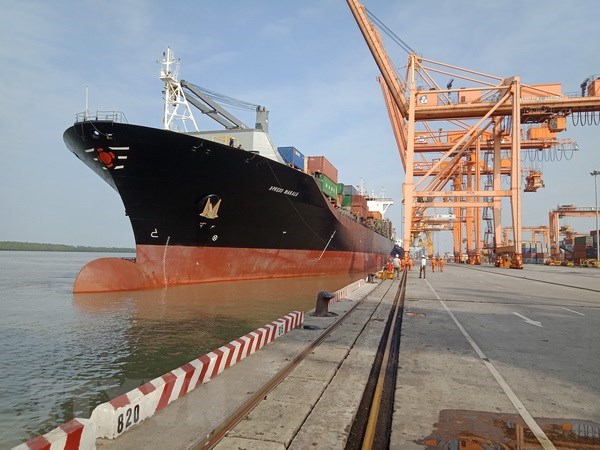 Singaporean-flag X-Pree Feeder container ship has become the largest ship of its kind to dock at Tan Vu port in the northern port city of Hai Phong. The ship, which is 210.96 metres in length and 32.2 metres in width, has a deadweight tonnage of 32,161. The vessel left China’s Hong Kong port for the Port of Hai Phong JSC’s Tan Vu Port to offload cargo on April 16 and will leave the port at 0:30 am on April 17. According to Cao Trung Ngoan, deputy director of the Port of Hai Phong JSC, the arrival of X-Pree Feeder is a landmark for Hai Phong Port as it proves the port’s capacity and affirms the significance of investment to modernise the port. The company has fulfilled its plan to develop Tan Vu Port into the largest and most modern container port in the northern region, he added, expressing his hope that relevant authorities will take more actions to ensure the safe reception of cargo ships as well as comprehensive development of port businesses. Quality labour improvement needed for sustainable development: experts Economic and social experts have stressed the necessity to raise the quality of human resources, thus improving the labour productivity and promoting sustainable development in the country. According to Chairman of the Vietnam Chamber of Commerce and Industry (VCCI) Vu Tien Loc, labour quality is a great pressure for Vietnam as this is one of factors to Vietnam’s sustainable development in the future. Education reform has become an important requirement, he said, noting that education and training in universities has to meet the market’s demand. At workshops on human resources quality improvement, economists said it is necessary to apply a range of feasible and effective solutions to improve the quality of human resources towards the increase of labour productivity, the capacity of business management, thus raising the competitiveness of the economy, especially in the context of intensive and multi-dimensional international economic integration. Associate professor PhD. Pham Van Son, director of the Education Ministry's Support Centre for Manpower Training and Supply, Vietnam's labour force has a great opportunity to participate in the regional and world labour allocation process. He, however, stressed that in order to achieve this goal, it is necessary to raise the quality of human resources in a variety of ways, such as improving educational level and labour skills, encouraging self-study, developing talents and building learning society, and combining the human resources development strategy and the socio-economic development strategy. "In order not to fall far behind, Vietnam needs to innovate human resources training, while devising appropriate mechanisms, policies and solutions to quickly better the quality of current human resources”, he said. This is a long-term and vital strategy to sustainably develop the high-quality labour force, meeting the country’s industrialisation, modernisation and international integration, he affirmed. Experts also underlined the need to improve not only specialised knowledge, but also foreign language and other knowledge, saying that this is important for Vietnam’s international integration target. According to the Association of Southeast Asian Nations (ASEAN), skilled human resources with good education and foreign language ability, particularly English, will be prioritised to freely work in ASEAN member nations. In addition, labourers can find suitable jobs and receive additional skills training. According to the Ministry of Labour, Invalids and Social Affairs (MOLISA), a number of industries bring opportunities for labourers to collaborate with small and medium sized companies in other countries. However, the professional level of the workforce must meet the requirements set by those companies. In a recent report by VCCI, 60 percent of foreign direct investment (FDI) enterprises said they would continue to expand their business in Vietnam. However, the issue of labour quality is their concern. Vietnam is attracting more and more FDI due to the advantages of institutional stability, large-scale market, abundant workforce, cheap labour cost, the report said. HCM City summit talks social enterprises Developing creative business models that help generate profits and at the same time improve the life of the community and well address social issues is the new way of doing business in Vietnam, heard the Impact Enterprise Summit in Ho Chi Minh City. Impact enterprises are defined as financially self-sustainable and scalable ventures that actively manage to produce significant net positive changes in well-being across underserved individuals, their communities, and the broader environment. Hui Woon Tan, founder of Alley 51 Ventures and The Purpose Group, said social impact-driven businesses are not merely built for the selfish capitalist man. "But the man who understands true sustainability and the value of a business must also take into account the real world where we are reliant and dependant on each other to survive,"' she said. Ly Truong Chien, chairman of Tri Tri Group, said about one fourth of the population of Vietnam is in need of support, which can be in education, healthcare, employment or others. If more impact enterprises with innovative and sustainable business initiatives are established the number of people needing support would reduce, he said. Shuyin Tang, partner at Patamar Capital, said: “The current investor narrative around Vietnam often highlights a fast-growing GDP, a young, high-density population, high smartphone penetration, and a deepening talent pool. “However, around 30 per cent of Vietnamese adults are unbanked, representing a huge financial inclusion opportunity. Significant segments of the population lack access to affordable, high-quality education and healthcare services. There’s a huge opportunity to tap into these underserved markets, which in our view will yield attractive financial as well as social returns.” In Vietnam, there are some successful social impact enterprises which provide life-changing opportunities for blind people, people with hearing impairments, street children, help solve social issues such as environmental and food safety concerns, distribute public services (bus and train online tickets), and follow other models to give back to the community. At the summit, sustainable businesses that have made positive social impacts in many spheres such as education, agriculture, technology, and micro-finance shared with more than 300 young participants their stories, including the advantages and challenges they have had. Replying to a question about how young entrepreneurs with limited experience and funding can create the impact they desire, Hui’s advice for young people was “to find the hard problem you want to solve first. Find something that is intimate to you if that’s possible. Immerse thoroughly into it with passion. Get down and dirty, talk to the real people you are impacting. Immerse in their stories. And then think out of the box, apply creativity. “Your biggest asset is that you have naivety and won’t be bogged down by what others tell you won’t work. You will need all this as you develop your solutions that are truly impactful. “After that, build your business like any other good old traditional revenue-generating business. Get your boring fundamentals like basic accounting, treating talent properly, organisation, operations and all that right.” The summit was organised by Seed Planter, the first entrepreneurship institute for impact entrepreneurs in Vietnam, and the Centre for Social Initiatives Promotion. Vietnam firms advised to invest in Indian garment market A representative of the Indian Consulate General in Ho Chi Minh City recommended Vietnamese companies look for investment opportunity in the Indian market of 1.3 billion people, particularly in garment and textiles. Currently Vietnam and India are among the five leading garment exporters in the world. Last year, the value of India apparel exports to Vietnam grew 44 percent to 429 million USD, while Vietnam’s shipment of garment-textile products to India reeled in 178 million USD, an annual increase of 42 percent. The Indian Government is allowing 100 percent foreign direct investment (FDI) in single-brand retail via automatic route, which means foreign investors can pour money into the market without prior permission from the authorities. Vietnamese garment companies can take advantage of the policy by investing in the production of threads, fabrics and ready-made clothes. It was estimated that between April 2017 and January 2018, Vietnam – India trade reached 10.39 billion USD, surpassing the figure of 10.13 billion USD recorded from April 2016 to March 2017. Improving trade transactions and connectivity have been classified as a strategic target by the two countries’ leaders. The two countries aim to bring bilateral trade to 15 billion USD by 2020. Last year, Vietnam exported 31 billion USD worth of textile and garment products, up 10.23 percent from the same period last year while its imports of textile and garment materials, mostly yarns and fabrics, amounted to 19 billion USD. Garment sector needs manpower development strategies: workshop To develop and enter global supply chains, the textile-garment industry needs to have strategies for developing high-quality human resources right from now, insiders said at a recent workshop in Ho Chi Minh City. Pham Xuan Hong, Chairman of the HCM City Association of Garment, Textile, Embroidery and Knitting (AGTEK), said at the event on April 14 that textile-garment is not only a spearhead export industry of Vietnam but also one of the sectors generating the biggest numbers of jobs, about 2.5 million. However, most of employees in the sector are manual workers in charge of simple steps while the steps requiring technical skills like dyeing or designing are facing a shortage of skilled workers. Hong said the shortage of high-quality manpower is also one of the reasons why local production of apparel materials remains undeveloped and Vietnam has to depend on imported materials. Meanwhile, the steps generating high added value like designing products and building brands are still limited. Although Vietnam is one of the five biggest apparel exporters in the world, global consumers haven’t known any Vietnamese fashion brands, he said. Dr Pham Xuan Thu from the HCM City College of Foreign Economic Relations said only about 30 percent of over 6,000 textile-garment businesses in Vietnam operate in textiles, including weaving, dyeing, printing and finishing fabric. Most the remaining firms make products ordered by foreign fashion brands. Only few of them are able to create their own products, from manufacturing fabric, designing to making apparel. Many companies still have to hire foreign experts and technicians at high costs to be responsible for dyeing, completing fabric and designing products, thus augmenting production costs and reducing their products’ competitiveness compared to foreign rivals, he added. Amidst growing integration and competition, to retain development and engage in global textile-garment value chains, the country needs to invest in training and improving manpower quality in an appropriate manner, participants in the workshop said. Dr Thu said the textile-garment sector has expanded to a certain size and now it’s time for it to make changes in quality, which means switching to the stage creating more added value. To do that, the sector has to restructure both production and manpower, he noted, adding that only when labour quality increases can businesses make use of material sources well, raise labour productivity and improve management capacity to boost their competitiveness. He suggested them invest more in manpower training, recruit and give intensive training to committed employees, and offer appropriate salary and bonus to encourage workers to make self-improvement. Another problem facing textile-garment companies is that their employees tend to switch to other firms to look for better opportunities after getting training and experience. Therefore, to keep employees, aside from appropriate salary, businesses should also create conditions for workers to show their capacity, create a friendly work environment and pay attention to workers’ spiritual needs, Thu said. At the workshop, AGTEK Chairman Hong also called for more active participation of State management agencies and training schools to boost training in the textile-garment industry. Pig farms disappearing The ratio of individual animal farmers has significantly declined in the southern province of Dong Nai in the last two years, with foreign-invested companies often replacing them. Dong Nai is a southern animal husbandry centre with 50,000 farming households, but the situation has changed since late 2016 as pork prices plummeted. Since then, pig prices have not recovered while costs have kept increasing, pushing many husbandry households into bankruptcy. To mitigate the situation, the Ministry of Agriculture and Rural Development and other authorities plan to review and amend the development master plan for the industry, and encourage households to have a closed production chain to control input quality and enhance value. However, the relentless decline in pork prices has not allowed these solutions to be implemented and thousands of households have quit for good. According to the local agriculture department, the number of sows in the province reduced by 24,000 in the last few months to 290,000. “However, the number of female pigs is still high,” one official said.“They could deliver 5.8 million piglets each year, one million more than the demand.” But foreign-invested companies have begun to invest in the local husbandry sector. Thailand-based company CP raises 7.25 million meat pigs a year and accounts for all the sows in the province,. The company supplies 40-45 per cent of all the pork sold in the southern region, and each time it changes prices the entire market has to follow suit. “The husbandry market trend is hard to predict, but due to losses in the last two years households have been the first to quit followed by small- and medium-sized farms, even big ones,” Pham Duc Binh, chairman and CEO of the Thanh Binh Ltd Company told Phu Nu (Women) newspaper. Construction firms to focus on partner rating system Partner rating is a necessary and significant step, directly improving the quality of construction, and indirectly helping to improve the capacity, responsibility and professionalism of enterprises. The statement was made by Ngo Huu Tiep, chairman of GIZA Engineering and Construction JSC (Giza E&C) at a conference held in Ha Noi on Monday. Contractors participating in construction are important factors contributing to the success of projects. The ability of partners, especially sub-contractors, as well as the co-ordination between contractors and sub-contractors, has a direct impact on the progress and quality of implementing project, followed by the prestige of the general contractor. Understanding the role of sub-contractors, construction workers and suppliers in the value chain of the construction industry, Giza E&C has researched and issued a partner rating system to help improve the contractor’s awareness of construction management, quality and safety. The ultimate and most important goal of this rating system is to select suitable partners to carry out the project, encourage contractors to improve and enhance their own capacity, thereby improving the quality of the building, Tiep told Viet Nam News. The main topic of discussion at the conference was the promulgation of criteria for evaluating bidders participating in the project in two stages: pre-bidding and post-bidding. The four key stakeholder groups involved are subcontractors, suppliers, construction teams and credit institutions, with different rating scales. The selection of pre-bids to help classify to determine the subcontractor’s construction specialty as well as the size of construction work that the contractor can take. Accordingly, the evaluation criteria will be based on five groups (finance, human resources, technology and techniques, experience), with each criterion group containing different indicators, Tiep said. Giza E&C also pays attention to evaluating, ranking partners during and after construction. The year 2017 has marked the success of Viet Nam’s economy in achieving GDP growth of 6.81 per cent - the highest level in the past six years. The domestic construction sector has witnessed an impressive growth, with many new emerging names which are quickly meeting the quality requirements of international investors, besides the well-known companies in the sector. With the motto of co-development, new contractors are catching the new trend - design and construction (D&B) in order to provide full package services for investors from design to construction, equipment installation and maintenance. Room to foster VN-Taiwan ties There remains massive untapped potential for bilateral co-operation between Vietnamese and Taiwanese firms in the sectors of automotive parts, green energy and e-commerce, said Chening Fan, director of the Taiwan External Trade Development Council (TAITRA) - a Taiwanese nonprofit trade promoting organisation. The director made the remarks to the press on the sideline of a business matching conference held on Monday in Ha Noi. The event witnessed the participation of approximately 138 enterprises, 100 of which were Taiwanese. Viet Nam has experienced high economic growth rates in recent years and is a lucrative market for Taiwanese products, he said. Alongside this, Viet Nam has signed many free trade agreements (FTAs) with various countries and blocs. This has resulted in tax incentives that Viet Nam could benefit from when exporting goods to many large markets. As a result, Taiwanese enterprises hope to foster their co-operation with Vietnamese partners in developing products which could then be shipped to these markets, the director said. Sales Director of Long Tsuen Industrial Co Howard Ko, which manufactures and exports valves and pipe fittings, boiler parts, and water, gas and steam accessories, said his company seeks to expand its partnership to more Vietnamese businesses to increase its distribution to further tap into the market. Long Tsuen Industrial Co exports US$100,000 worth of products to the Vietnamese market annually. This is a modest figure compared to the potential that the market holds, he said, addding that the industry and construction sectors in Viet Nam have grown rapidly over the past few years, resulting in high demand for his company’s products. During the business forum, firms from Viet Nam and Taiwan also discussed co-operation opportunities in many other areas such as home appliance, farm produce, cosmetics and sports equipment. A representative of a Vietnamese company specialising in producing and processing cinnamon-made tea products said during the event that his company hopes to advertise its products and seek new trade partners from Taiwan because of similarities in tea culture between the two economies. Bilateral relations between Viet Nam and Taiwan in trade and investment have been improving over past years. Bilateral trade reached $12 billion in 2016 and over $12.4 billion in the first 11 months of 2017. Viet Nam exported nearly $2.88 billion worth of goods to Taiwan during this period, up 16 per cent year on year while its imports from the market hit close to $9.55 billion, up 9.4 per cent year on year. This means that Viet Nam saw a trade deficit of more than $6.7 billion with Taiwan, 7 per cent more than the same period of 2016. Among Viet Nam’s major exports to Taiwan are live animals and animal products, vegetable, processed food, and beverages, as well as minerals, crude oil, chemicals, rubber goods, and textiles and garments. Its imports from Taiwan consisted mainly of seafood, plastic materials, wooden goods, chemicals, paper and paper pulp, electronics components, machinery and transport vehicles. As of March, Taiwan was Viet Nam’s forth largest source of foreign direct investment with 2,549 projects, capitalised at $30.94 billion. VN firms to exploit Malaysia opportunities Many Vietnamese firms are set to participate in the 2018 Selangor International Business Summit (SIBS) in Malaysia to exchange information and seek business opportunities, a meeting heard in HCM City on April 16. To be held from September 6 to 16 at the Malaysia International Trade and Exhibition Centre in Kuala Lumpur, it will feature three main events – the 2018 Selangor International Expo, the 2018 Selangor-Asean Business Conference, and the 2018 Selangor Smart City and Digital Economy Convention. Dato’ Hasan Azhari Haji Idris, CEO of Invest Selangor Berhad, the event’s organiser, said amid the current global economic situation it was imperative for ASEAN members to operate as a united community and support each other. As the gateway to ASEAN, Selangor would act as a centre point that hosts and connects a rich network of trade industry players globally by leveraging a solid platform like SIBS, he said. Sofian Akmal Abd. Karim, the Malaysian consul general in HCM City, said: “Through its rich network, the summit presents opportunities for local and foreign multi-national corporations to showcase their products and services. Subsequently, it also acts as a strategic avenue for marketing, collaborations and partnerships, and provides exposure as well as information on the latest technological developments.” Faizal Izany, trade counsellor at the Malaysian consulate, said one of the summit’s main events, the food and beverage-focused 2018 Selangor International Expo, would be a good platform for Vietnamese food producers to promote their products in Malaysia as well as ASEAN and global markets. Vietnamese enterprises would also have a chance to learn about halal food and how to get the certification to penetrate the huge global halal market, he said. Idris said the 2018 SIBS was expected to have a total of 1,000 booths and 25,000 visitors, up from 691 and 22,071 last year. At the meeting, the Viet Nam Exporters Association and other business groups based in HCM City said they would send business delegations to the summit. Trade between Viet Nam and Malaysia was worth US$10.06 billion last year after rising by 19 per cent. The two countries are striving to lift their trade to $15 billion by 2020 under their Strategic Partnership framework. Karim said Selangor was the largest of Malaysia’s 13 states in terms of GDP, making up about 22.7 per cent of the country’s economy in 2016. It was also one of the most developed states and most populated, he added. Invest Selangor provides information, facilitation services and start-up and expansion assistance for businesses planning to invest in the state. Lawmakers lament lousy logistics limitations High logistics costs and inefficient logistics networks continue to provide a challenge for policy makers, hamper businesses, and threaten competitiveness. Prime Minister Nguyen Xuan Phuc, during his speech at a national logistics conference on April 16, reaffirmed the importance of capable logistics infrastructure in Viet Nam’s economic growth. The industry is valued at billions of US dollars, and is one of the 12 priority industries supported by the ASEAN community. And yet, this attractive service sector may soon be taken over by foreign firms, seeing as domestic ones have yet to become fully established on the market, said the PM. He quoted Benjamin Franklin, "Beware of little expenses. A small leak will sink a great ship", emphasising the potential harm that high logistics costs and ineffectual transport can cause to the economy. As assessed before by the World Bank, logistics costs in Viet Nam are equivalent to about 20.9 per cent of total GDP, of which transport costs account for 60 per cent. The same number in China is around 19 per cent, while it is 18 per cent in Thailand; 11 per cent in Japan and roughly 10 per cent in European countries. This puts Viet Nam at number 64 out of 160 countries on the World Bank’s Logistics Performance Index. "High logistics costs are among the biggest barriers for Vietnamese enterprises’ competitiveness, mainly due to unreasonable investment and poor connections between different modes of transport," said the PM. Therefore, the Government must actively promote reducing the cost of logistics for businesses via concrete deeds, such as the recently approved Action Plan to improve Viet Nam’s competitiveness and develop logistics services by 2025. There should be strong State support mechanisms and policy planning in the sector, since its functions are not just limited to freight forwarding, but also include other activities such as warehousing, packaging and cargo handling. "If the logistics sector is well and good, it will save transportation and product costs, and increase firms’ competitiveness and profit", added PM Phuc. Speaking at the conference, Deputy Prime Minister Trinh Dinh Dung addressed four current issues facing the logistics sector, as well as possible solutions to be enforced. The first and foremost problem involves institutions and policy, as current legal regulations on logistics may need to be amended to keep up with present day industry demand. There is also indication that some localities with domestic ports have yet to properly locate warehouses and shipyards to store goods, thus pushing transport costs up. The second issue that the Deputy PM mentioned was related to infrastructure development, chiefly with regard to connecting transport routes between logistics centres such as ports, railways, airports, and cargo transshipment ports. Thirdly, he discussed inefficiency in linking different modes of transport, highlighting some difficult to explain issues such as market favourability for high cost transport modes. Sea and railway transport account for 4.7 and 0.39 per cent of total transport respectively, while road transport accounts for nearly 80 per cent, yet road transport is favoured over the cheaper alternatives. Finally, he suggested that logistics firms focus on the operation scale expansion and human resources training. Meanwhile, Deputy Minister of Transport Nguyen Van Cong stated that the domestic aviation sector is accelerating air cargo services development and establishing its own freighter network, encouraging investors to finance regional cargo airports with the appropriate incentive mechanisms. According to the Ministry of Transport (MoT), the estimated cost of transporting a 40 foot long container (about 12 metres) by road from Ha Noi to HCM City (excluding the cost of unloading and loading at both ends) is about VND40 million (US$1,780), practically 10 times more expensive than by sea, and 2.5 times more expensive than by rail. Cong said that the high cost is due to unfair competition, mainly through intermediaries, which has done little to optimise the national transport sector. Notable examples are high petrol prices and Build–Operate–Transfer (BOT) charges. Railway, inland waterways and seaway transportation are lower in cost, but transport time is much longer, with higher loading and unloading fees and outdated carriers. Cong added that in order to reduce logistics costs, the MoT should invest in the formation of a national high-speed road network, dedicated to ensuring efficient connections between industrial parks, key economic centres, and important traffic hubs, as well as between sea ports, railway stations and inland water ports. RoK’s exports to Vietnam drop 3.3 percent in March The Republic of Korea (RoK)’s exports to Vietnam sank 3.3 percent in March 2018, according to the Korea Customs Service (KCS). The KCS said on April 16 that the RoK’s exports rose 6.1 percent in March from a year earlier, largely thanks to strong demand for semiconductors and petrochemical goods. The country's outbound shipments were estimated at 51.6 billion USD in March, compared with 44.6 billion USD a year earlier. Meanwhile, the RoK’s imports rose 5.2 percent in the reviewed period to 44.8 billion USD, resulting in a trade surplus of 6.8 billion, it added. March 2018 marked the 74th month in a row the RoK’s trade balance has stayed in the black, said the KCS. Chip exports surged 43.9 percent in March from a year earlier, leading last month's export expansion. Oil product shipments added 1.1 percent, but those for automobile and ships declined 8.1 percent and 30.9 percent respectively. Export of telecommunication devices, such as smartphone, fell 9.2 percent as local companies increased production in overseas factories. Shipments to China, the RoK's biggest trading partner, increased 16.6 percent, but those to the US, the second largest overseas market for locally made goods, fell 1 percent. German delegation seeks trade cooperation with Viet Nam Viet Nam has changed dramatically in the last three decades, thanks to its dynamic economic growth, and is close to being called an industrialised country. This is a promising start for further expansion of business relations between Germany and Viet Nam. The statement was made by Volker Wissing, Deputy Prime Minister of the State of Rhineland-Palatinate cum Minister of Economic Affairs, Transport, Agriculture and Viniculture of Rhineland-Palatinate, at a conference in Ha Noi on Monday. Despite being one of the 16 smallest States in Germany, Rhineland-Palatinate is a successful and forward-looking business region on the international stage. Besides its traditional strengths in chemical, pharmaceutical, automotive and mechanical engineering industries, the State is well-positioned in the environmental technology, agriculture and healthcare industrial sectors. Last year, Rhineland-Palatinate’s gross domestic product reached 144 billion euros (US$177.56 billion) and created some 20,000 jobs. The State has a clear orientation for export, with 55.9 per cent of economic output for the exporting sector. According to Joe Weingarten, head of Innovation and Technology Department under the Ministry of Economic Affairs, Transport, Agriculture and Viniculture of the State of Rhineland-Palatinate, the State is currently targeting six key sectors: life sciences and health economy; energy and environmental technologies and resource efficiency; automotive and commercial vehicle industry; information and communication software systems; material and surfaces as well as microsystems, sensor technologies and automation. At present, there are some 300 German enterprises doing business in Viet Nam, of which 68 per cent said they were satisfied with the country’s business environment and 75 per cent hoped to further invest in Viet Nam in future. However, one of the main obstacles for German firms is seeking skilled workers in Viet Nam, said Marko Walde, chief representative of German Industry and Commerce Viet Nam. One of the advantages for Vietnamese firms doing business in Germany is the large community of Vietnamese people living there. Some Vietnamese companies, such as FPT Telecom Joint Stock Company and Viet Nam Bank for Industry and Trade, are running successful businesses in Germany. It is hoped that when the European Union-Viet Nam free trade agreement comes into effect, Viet Nam will have a better advantageous position than neighbouring countries such as Thailand, Malaysia or the Philippines, Walde said. “Germany makes it easy for foreign companies to open branches or do business. The legal conditions are minimum. The only thing a firm needs is capital---a minimum of 25,000 euros to open a limited liability company in Germany,” Unal Kaykci, director of legal and consultancy firm Kaymakci & Koil.’s, told Viet Nam News. Regarding difficulties faced by Vietnamese firms in cooperating with German enterprises for importing German products, Vu Bich Ngoc, chairman of Dung Giang Construction and Trading Company Limited, told Viet Nam News that the legal procedures in tax, import and transportation were the main obstacles for domestic firms in importing and distributing products from foreign countries. Indirect investment from RoK to Viet Nam promoted Finance Minister Dinh Tien Dung is chairing a conference in Seoul from 16-19 to promote indirect investments from the Republic of Korea (RoK) to Viet Nam, according to the State Securities Commission (SSC). At the investment promotion conference, Vietnamese officials will publicise the country’s policies on economic restructuring, equitisation of State-owned enterprises (SOEs) and measures to encourage foreign indirect investment into the stock market. The conference also creates a venue for Vietnamese management agencies to meet and encourage RoK financial investors, bankers and insurers to conduct business in Viet Nam, as well as to hear assessments and recommendations from Korean investors regarding Viet Nam’s financial and insurance markets. According to SSC Chairman Tran Van Dung, RoK is currently the largest foreign investor in Viet Nam, and its increasing presence in Viet Nam’s stock market is helping attract indirect Korean investment in the country. He added that, last year, Viet Nam’s stock market continued to be a magnet for foreign indirect investment, which totaled US$32.9 billion, up by 90 percent from the previous year. Foreign indirect investment continued entering the country in the first three months of 2018, rising by 14 percent from the end of 2017 to $37.6 billion in late March. Korean indirect investment is rising sharply, though it has yet to match its potential, Dung said, noting that 4,846 Korean investors are present in Viet Nam’s stock market. There are currently five South Korea-invested securities companies in the Vietnamese stock market, namely Korea Investment & Securities, Mirae Asset Daewoo, Shinhan Investment, KB Securities and Woori, Dung said, adding that these securities firms, together with banks and representative offices of fund investment companies from RoK, are playing an important role in boosting the inflow of Korean indirect investment into Viet Nam. The Northeast Asian nation is also operating projects in securities with Viet Nam, Dung said, adding that the Ha Noi Stock Exchange and the HCM Stock Exchange are working to update their technological systems, with the help of the Korea Stock Exchange. Meanwhile, the SSC and the Korea Financial Investment Association are also discussing their working together on financial technology, he added. According to Dung, to further attract foreign indirect investment from RoK, the SSC will strengthen cooperation with RoK’s managerial agencies to learn about Korean investors’ investment demands, and then both sides will work to remove obstacles to Korean investment in Viet Nam’s stock market. SSC will also strive to attract indirect foreign investment into Viet Nam through building a stable, safe, fair, open and effective stock market, to protect the interests of investors and respect market rules, gradually integrating with other stock markets in the region and throughout the world. In addition, it will further accelerate the listing of large-scale equitised SOEs and reduce State ownership to bolster attractiveness, besides diversifying products on the stock market to ensure that foreign investors have more investment opportunities. According to experts, Viet Nam’s stock markets are attractive to foreign investors, including South Koreans, especially when 64 SOEs will become equitised, while 181 others will be divested between now and 2020. VN e-commerce firm Cat Dong joins Japan’s Scroll Cat Dong Service Trading Joint Stock Company on Monday reported that it had sold a 26.9 per cent stake to Japanese online marketer Scroll Corporation. But it did not disclose the value of the deal. On Monday the two companies signed an agreement to jointly develop e-commerce and tourism and provide e-commerce development solutions. Under the deal, they will maximise their management resources and strengths in various fields ranging from sales to e-commerce solutions and travel operations. Cat Dong will sell Japanese products provided by Scroll on its websites like CungMua.com, NhomMua.com and Shipto.vn. Furthermore, tours to Japan operated by Scroll will be sold on these websites. The two sides will together offer solutions in e-trading, logistics, warehousing and business expansion. Cat Dong, launched in 2010 as a website selling vouchers, owns multiple e-commerce websites, provides e-commerce solutions related to logistics, freight and online marketing. It acquired NhomMua.com in 2014 and last year started partnering all major e-commerce platforms in Viet Nam. Scroll is a Japanese e-commerce company trading fashion goods, cosmetics and dietary supplements. TAC increases dividend by half to 24 per cent Cooking oil producer Tuong An Vegetable Oil Joint Stock Company (TAC) announced an increase in the dividend for last year to 24 per cent from the earlier plan of 16 per cent at its annual shareholders meeting on April 16. It came on the back of outstanding business results, with pre-tax profits growing by over 98 per cent to VND166 billion (US$7.3 million). Revenues only rose by 9 per cent to VND4.3 trillion ($188 million). The company attributed the results to the strong growth in the economy and the cooking oil market. Nguyen Thi Hanh, chairwoman of TAC, said: “The cooking oil industry is expected to grow by 8.7 per cent in 2015-20. Consumption in Viet Nam is still lower than in neighbouring countries.” TAC last year made changes to its product portfolio with a focus on healthy products, she said. Hanh also hailed the merger with food producer KIDO Group. “The merger with KIDO has helped us develop our logistics and distribution systems.” She said the company was now the second biggest cooking oil producer. The meeting also approved a 24 per cent dividend for this fiscal year. In 2018, TAC targets pre-tax profits of VND250 billion on revenues of VND5.1 trillion ($223.6 million). Hanh told the meeting that the targets were challenging but achievable since demand remained huge. TAC plans to enter new segments with a focus on high-end products to meet the relentlessly growing demand for healthy products, she revealed. “We will partner with domestic and foreign investors to enter the canned/packaged products market including sugar, instant noodles, sauces and spices.” The company would continue to expand its distribution system, she said. TAC, established in 1977, has two plants in Nghe An Province’s Vinh City and Ba Ria–Vung Tau Province. National, Asia-Pacific quality awards to run in April A ceremony to honour the 2017 winners of the annual National Quality Awards and International Asia Pacific Quality Award (IAPQA) will take place on April 22. The information was released at a press conference introducing the awards on April 17. The ceremony will be broadcast live on the Vietnam Television’s channel 2 between 9 and 11 pm. Seventy-three enterprises have won the 2017 National Quality Awards. Among them, 15 received National Quality Gold Awards, while 58 took Silver. At the press conference, Deputy Minister of Science and Technology Tran Van Tung said the National Quality Awards is the only one of its kind approved by the Prime Minister and included in the IAPQA system by the Asia-Pacific Quality Organisation. It is an annual award to honour businesses with outstanding operation in boosting the quality and competitiveness of their products and services amid regional and global integration, he added. Tung said to optimise the award’s impact, firms are being encouraged to consider it a performance assessment tool. As of 2017, 1,842 enterprises won National Quality Awards and 44 others obtained the IAPQA. VNN |
↧
Article 0
Social News 18/4 (Hourly Updated) HCM City proposes road, railway to Cat Lai
Cargo vessels anchored at Cát Lái Port in HCM City. HCM City’s Department of Planning and Architecture has proposed to the government to open a road or railway route dedicated to container trucks entering Cát Lái Port. This is to avoid these vehicles from using urban roads for transporting goods and leading to traffic congestion. Previously, the government had approved a plan to establish a rail route to Cát Lái Port to transport goods. But the plan was abolished in 2013. Late last year, HCM City had once again suggested to the Ministry of Transport to re-consider the construction of railway lines into ports in the city, especially into Cát Lái Port, to ease traffic in those areas. Currently, all trucks transporting goods to and from Cát Lái Port run from Mai Chí Thọ Street to Mỹ Thủy intersection and Cát Lái Port. Nguyễn Thanh Toàn, deputy director of the city’s department, said the incidence of trucks and container trucks using urban roads to transport goods in and out of Cát Lái Port was unavoidable. He, however, said that normally, a port must use a railway route or road dedicated to transporting goods. He proposed to re-design the capacity of the port and re-plan the railway route dedicated to transporting cargo to Cát Lái Port. Earlier, Bùi Xuân Cường, director of the city’s Department of Transport, had said the department would accelerate the construction and operation of two new bridges in Cát Lái area in April-May this year. He also confirmed that after repairing the D1 and D2 routes in the third quarter of this year, container trucks would be allowed to operate on those routes to reduce the overloading on Mai Chí Thọ and Đồng Văn Cống streets. Cát Lái Port always witnesses heavy traffic congestion during peak hours, when vehicles can take up to six hours to cross the 8km road. According to the plan of HCM City’s Department of Transport, some 36 million tonnes of cargo are expected to pass through Cát Lái Port every year. But in 2016, the cargo volume exceeded the plan by 53 million tonnes. It reached 27.2 million tonnes in the first seven months of 2017. On an average, some 17,000 trucks move in and out of Cát Lái Port every day. This number can reach between 20,000 and 22,000 per day during peak times. More soft loans needed to support people with disabilities 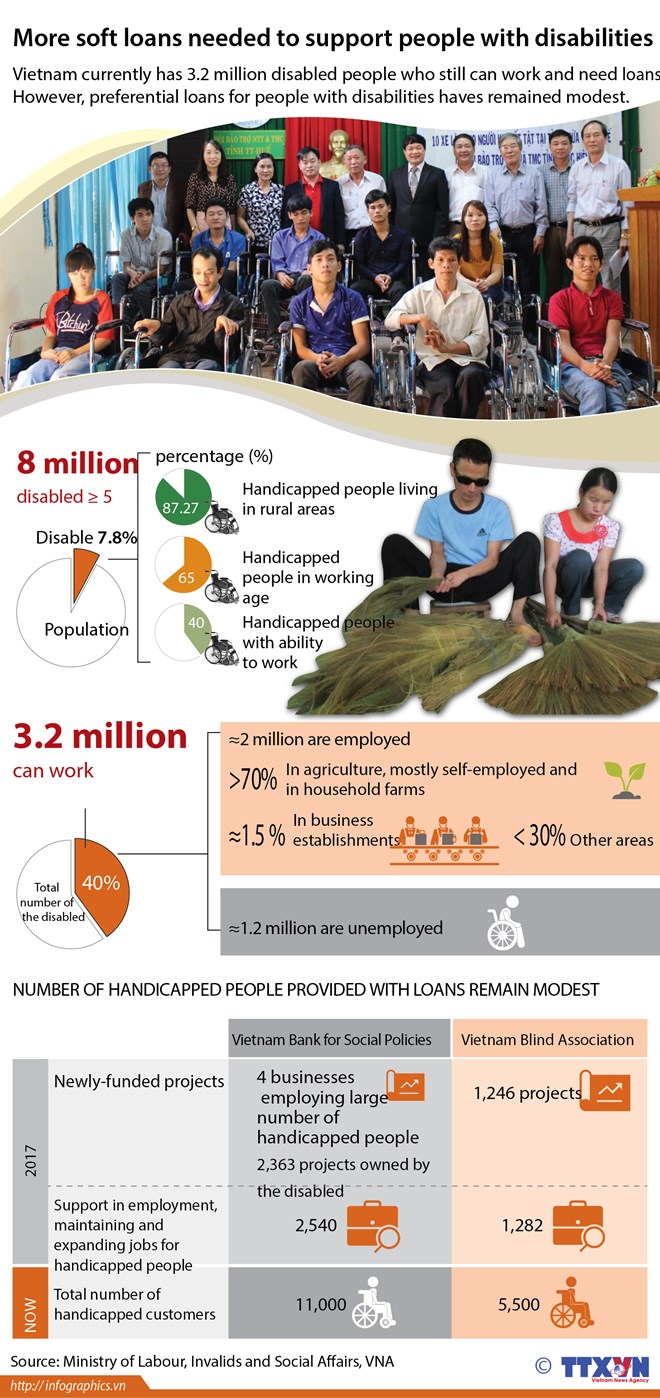
Sketches on central - Central Highlands battlefield exhibited
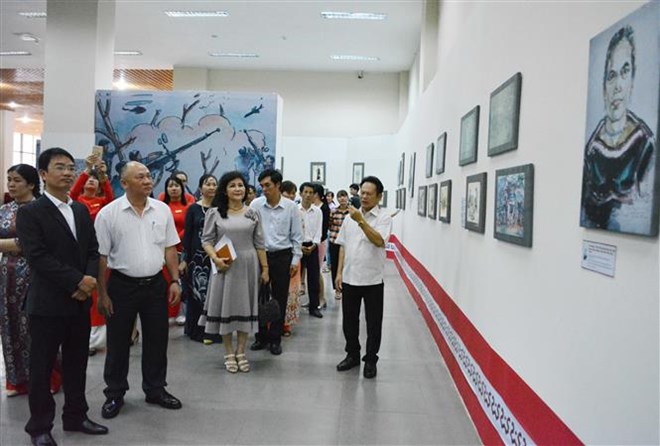 Visitors at the sketch exhibition An exhibition featuring historic sketches opened in Buon Ma Thuot city, the Central Highlands province of Dak Lak, on April 17. On display are 80 historic sketches, including 40 works on the central - Central Highlands battlefield drawn by 16 artists. The exhibits were selected from more than 3,000 drawings sketched during the wartime, which were presented to the Dak Lak Province Museum by the Ho Chi Minh City Fine Arts Museum, according to the organising board, The exhibition gives the public an insight into the life of people and soldiers at that time, thus helping inspire the national patriotism. It also helps visitors better understand the art. The exhibition, jointly organised by the provincial Department of Culture, Sports and Tourism and the Ho Chi Minh City Fine Arts Museum, will remain open to visitors until the end of September. Quang Tri joins national efforts to combat illegal fishing  The central coastal province of Quang Tri has enhanced surveillance of offshore fishing vessels as part of efforts to prevent illegal, unreported and unregulated (IUU) fishing, especially after the European Commission (EC) issued a “yellow card” warning to the country’s fishery sector. According to the provincial department of fisheries, offshore fishing vessels are required to report their exact positions and contact with the station of fishing vessel information management. With boats equipped with fisheries surveillance system called Movimar, they must turn on the machine around the clock so that relevant authorities can keep close track on their positions. Communication campaigns have been step up to raise public awareness of the strict punishment and consequences of IUU fishing, including economic and assess losses and Vietnamese fishermen’s prestige. In the past time, Quang Tri organised four training courses for over 200 fishermen, especially captains and ship owners, in Vinh Linh, Gio Linh and Trieu Phong districts. The measures have brought in positive results as ship owners respect current regulations on fishing certificates, food safety certificates while fishing on the country’s territorial waters. Changing behaviors key to protecting environment sustainably
Swedish Ambassador to Vietnam Pereric Hogberg addressed the “7 Day Challenge” campaign in Hanoi The “7 Day Challenge” campaign, an initiative from Sweden, has arrived in Vietnam. It encourages the participants to eat, move and live without harming the environment. “Since I came some years ago, I met so many young Vietnamese who think very much about security and safety in daily life. It’s about air safety, water safety, food safety - what does it come from? Of course, traffic safety,” Pereric Hogberg, Swedish Ambassador to Vietnam told Vietnam News Agency on the launch of the campaign. The event was organised by the United Nations, the Swedish Embassy in Vietnam and the Live & Learn Environmental Education Centre. It has three periods, starting on April 10, April 17 or April 24 and lasts for a week. It was previously held in Kenya, Brazil, India and Indonesia. The campaign’s hashtag #7_Ngay_Thach_Thuc or #7DayChallengeVN has drawn much interest of people who want to challenge themselves to achieve a smarter life. Nguyen Viet Lan shared on the hashtag that her new way of travelling to work is bus rapid transit. “I choose this because air pollution continues to cause severe health problems for people in Hanoi. I believe move smart can help reduce this phenomenon.” The Green Innovation and Development Centre (GreenID) and the Vietnam Live and Learn Centre for Environment and Community reported earlier this year that alarming pollution readings were recorded in Hanoi in 2017. In 2017, Hanoi had 257 days when the Air Quality Index exceeded the safe limit set by the WHO while statistics from the US Embassy in Hanoi revealed that the atmospheric quality in the city was much lower than India’s New Delhi and Mumbai. The country was reported to spend about 780 million USD annually on public health costs caused by air pollution. Lan also shared she changed her habit of using single-use bags. “This morning I brought some reusable bags with me and tried to refuse plastic bags when buying food, except for fish, as it cannot be put together with other food, Lan said. “[I] will remember to bring a reusable box for fish next time.” Using reusable bags is one way to reduce plastic pollution (Source: Nguyen Viet Lan, a participator of the campaign) The use of plastic bags remains a problem in Vietnam as there is a lack of information about the importance of environmentally-friendly bags. An Ocean Conservancy report in 2015 found that Vietnam together with China, Indonesia, the Philippines amd Thailand are responsible for up to 60 percent of the plastic trash flowing into the seas. Linh Hai Nguyen, another responding to hashtag #7_Ngay_Thach_Thuc or #7DayChallengeVN, said she will not use plastic straws and single-use items, but re-usable shopping bags and eco-friendly products. “Such small things are things that the Earth is requiring,” Linh shared with the online community. Behavior changes coming from small things by individuals can create huge benefits, said Hogberg. “We have ideas, we have different initiatives. But most of all, it has to come from Vietnam, it comes from someone else. It comes from how we constantly innovate, renovate ourselves, in a way of finding ways of changing to adjust to become a more sustainable society,” said the Ambassador. The seven-day Challenge – Eat, Move, and Live Sustainably also aimed to respond to the Earth Day 2018 (April 22) themed “End Plastic Pollution”. During the challenge, participants could eat vegan or choose locally-grown produce, travel by bicycles or go walking instead of riding vehicles with fossil fuel, or seek ways to save energy and reduce waste at home. Tree planting model benefits local people in Tuyen Quang Planting trees can both combat global warming and increase incomes of citizens. The northern mountainous province of Tuyen Quang has initiated a cooperative tree planting model, where paper companies work with local people to benefit both parties. During the 2017 forestation season, Vu Van Xuan, from Tan Bien 2 village, Tien Bo commune, Yen Son district, TuyenQuang province has received more than 20,000 acacia trees from An Hoa Paper Corporation, enough to cover nine hectares. After a year of applying scientific methods, his acacia trees are now growing stronger than ever. Vu Van Xuan, a resident in Tien Bo commune, Yen Son district, Tuyen Quang province told reporters: "Technical officers from An Hoa Paper Corporation have helped us tremendously in tree planting methods and provided seedling without any strings attached. We are thrilled to not have to pay huge sums of money for the seedlings, and the administrative procedures are quick thanks to the help of competent agencies." After two years of implementation, the number of households enrolled in the program has reached 1,300 with forestation area up to 3,250 hectares. Other than providing seedlings, the company also helps out with expenses, and sends technical officers to moblise people planting trees for paper production. Vu Thi Nhung, Director of An Hoa Paper Corporation said: "We also encourage local people to plant more trees and sell the wood pulp to the company". Besides providing seedlings, the wood pulp is also paid in cash so that local farmers have incentive to plant more trees, she added. AnHoa Paper Corporation is one of five firms following the cooperatives forestation model with local farmers to support them in tree planting. From providing seedlings to purchasing the end products, this model has proven to be very effective in improving the livelihoods of local people. According to Trieu Dang Khoa, Deputy Head of Tuyen Quang Forest Protection Department, connecting local people with paper companies has brought tremendous benefits to both parties. The whole point of this model is to raise the forestation area and increase the finances and the livelihoods of local people, said Khoa. This is a sustainable way to promote the cooperative forestation model. It has created incentives for both locals and the companies which participate in the programme. Paper companies can purchase high quality wood pulps and local farmers can improve their income, and this acts as a way to protect the environment. Programme honours outstanding people with disabilities
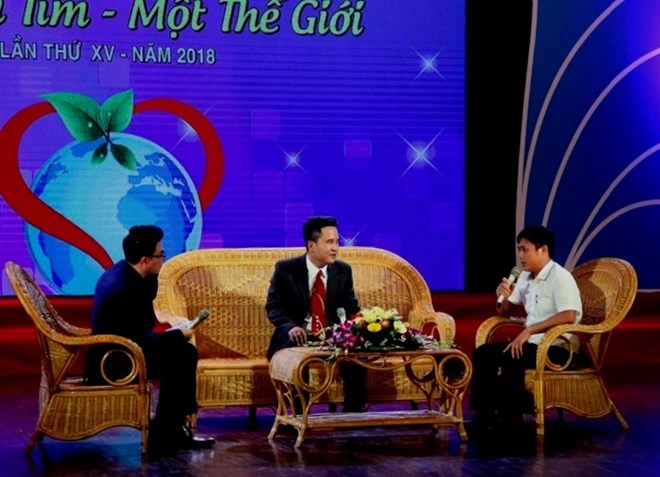 Exchange with guests of the programme (Photo:http: petrotimes.vn) An art and exchange programme was held in Hanoi on April 16 to honour people with disabilities who manage to overcome their difficulties and become successful. The event, themed “One heart – One world,” was also a chance to show gratitude to those who have worked with the Association in Support of Vietnamese Handicapped and Orphans in assisting the disabled and orphans. Participants at the event had opportunities to exchange with outstanding people with disabilities who own firms that create jobs for many others. Among them was Vo Van Son, born in 1984 and from Bo Trach district of the central province of Quang Binh. He is director of Duc Son company specialising in fishery logistics services with annual revenue of up to 20 billion VND and a profit of about 500 million VND. His firm employs 10 people whose income is 7 million VND per month each. Visitors also learnt about Tran Kim Viet, born in 1990 in the central province of Ha Tinh. He set up Viet incubation company in 2014. After four years, his firm received investment of 1 billion VND, becoming the largest incubator of aquilaria tree in Ha Tinh, providing 10,000 trees to customers in and outside the country. After 15 editions, the “One heart – One world” programme has become one of major activities of the Association in Support of Vietnamese Handicapped and Orphans to strengthen solidarity and call for support for people with disabilities and orphans across the country. During the programme, the organising board raised 20 billion VND for people with disabilities and orphans to help them improve their living quality and integrate into society. The event was part of activities to mark the Vietnam Day for People with Disabilities (April 18). That’s not my number(s)
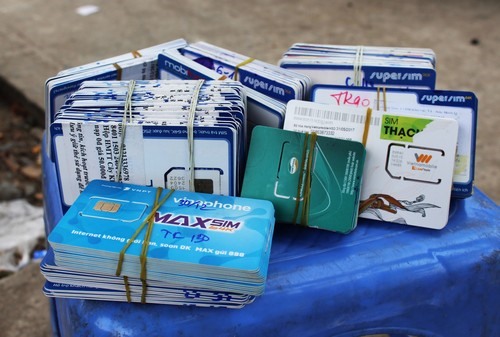 Many "trash" SIM cards were used to send spam texts and fraud messages before being discarded with virtually no way to track the perpetrators. A recent Government decision that requires mobile phone users to supply service providers with personal information has led to some grumbling over the hassle, but also given some people a nasty surprise as they learn that their ID cards were used to register several numbers with different service providers. “I’m not ok with that at all. Not only it’s a serious breach of my privacy when my information was stolen and used without my consent, it’s also a security risk. What if someone used those numbers, which were under my name, to blackmail people or make death threats or to swindle? Would I be in trouble with the law, then?” said a very unhappy customer after he learned that his ID was used to register three different mobile phone numbers. His worries are far from groundless. There are an absurd number of “trash” SIM cards in the country. An inspection carried out by service providers earlier this year revealed some 23 million, many of which were used to send spam texts and fraud messages before being discarded with virtually no way to track the perpetrators. Further inspection of service providers’ customer database also led to less than reassuring revelations about how easy it is to activate a number. For instance, one single ID was found to have been used to activate more than 18,000 numbers. It is hard to believe that it was done without the provider’s knowledge for such an action would raise a red flag in any database management system. Mobile phone users in Việt Nam will have some time to submit their personal information again if they wish to keep their numbers. Among the many rules, they will be asked to send in a portrait photo. Hopefully this will come as a silver lining amid the bureaucratic burden for the many selfie-lovers out there. Finally, an actual use for years of selfies. Rent-an-AC business in bloom 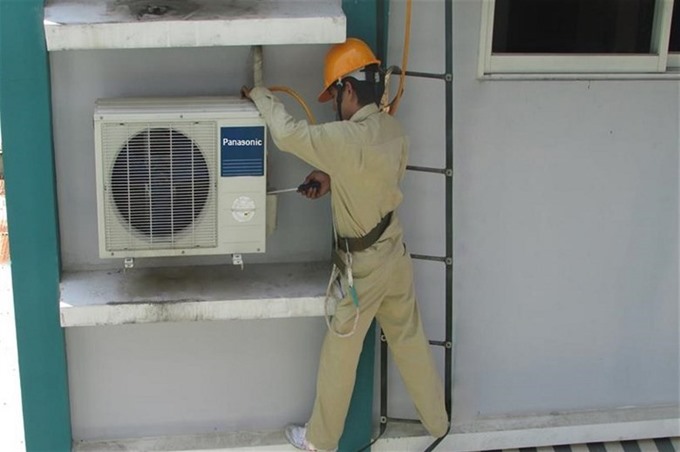 There are many rent-an-AC businesses in town. Most will charge around $25 per month while some may charge well over $40 for newer models and on-site services and repairs. Summer is fast-approaching and before long the tropical heat will be in full swing. It is a busy time for stores that sell air conditioners as people are gearing up for another hot summer. They are, however, quite pricey as even a basic model can set you back at least US$300. Thinking about getting an air conditioner but worried about the high cost? Luckily, you can now rent an AC instead of buying one. “It just makes sense. I don’t want to pay in full for something I will probably use for only two, three months a year. After the hottest months, we will just switch back to using fans to save on electricity,” said Trần Quốc Huy, a HCM City resident who just signed a contract on a two month rent of 2 AC units for his house. There are many rent-an-AC businesses in the city. Most will charge about $25 per month while some may charge more than $40 for newer models and on-site services and repairs. Installation is free but renters are often asked to put down a deposit, which will be returned at the end of the rental period. “We have a little boy over three years-old. He sleeps much better through the night with the AC on. We used rent-an-AC last year for three months. It costs us a bit more than $90, a fraction of the price for a new unit,” said Trần Kim Nguyên, a mother from District 4 in HCM City, “We decided we would go with it this year, too.” Should you find it’s time to replace that old and noisy AC unit on the wall, maybe take a moment to think whether it is better to rent one or to buy one. You won’t have to clean them often, either. That must count as a plus for the rent-an-AC businesses, right? VNN |
↧
Article 4
Government News 18/4 PM urges German state’s further investment in Vietnam
Prime Minister Nguyen Xuan Phuc (R) and Rheinland-Pflaz Deputy Minister-President Volker Wissing Prime Minister Nguyen Xuan Phuc has urged Germany, especially Rheinland-Pflaz state, to further boost trade and investment with Vietnam to further lift two-way trade. During a reception in Hanoi on April 17 for Rheinland-Pflaz Deputy Minister-President and Minister for Economic Affairs, Transportation, Agriculture and Viniculture Volker Wissing, the PM assured the guest that the Vietnamese government always offers all possible support to German localities and firms to do business in the country. He affirmed that the Vietnamese government supports strengthening ties between Vietnamese and Rheinland-Pflaz corporations and asked for reinforcing people-to-people exchange and tourism cooperation on the back of existing potential and advantages. The host believed that Rheinland-Pflaz state will play an important role in reinforcing the multifaceted cooperation between the two countries in the time ahead. Wissing, for his part, said the delegation is accompanied by local corporate representatives to seek cooperation opportunities in economy, culture and education in Vietnam. The state wants to promote joint work with Vietnamese localities and businesses, including the exchange of traditional goods, he said. He suggested further stepping up cultural and educational ties with Vietnam and expressed his belief that both sides will reap more successes in the near future. Government, Fatherland Front boost ties to enhance national unity
Prime Minister Nguyen Xuan Phuc speaks at the meeting on April 17 to review the coordination between the Government and the presidium of the Vietnam Fatherland Front The Government and the presidium of the Vietnam Fatherland Front (VFF) Central Committee reviewed their coordination in 2017 at a meeting in Hanoi on April 17, agreeing to bolster ties to enhance the great national unity bloc. According to a report delivered at the meeting, the coordination between the two sides continued to be strengthened last year. They worked together to effectively implement joint works, especially communication activities among ethnic minority and religious people, organisation of the great national unity festivals, promotion of new-style rural area building and poverty reduction, and raising support for disaster victims. Supervision and social criticism activities have been carried out in a more effective manner. Meanwhile, coordination in building the Party and administration and fighting corruption became more substantive. Speaking at the meeting, President of the VFF Central Committee Tran Thanh Man appreciated Prime Minister Nguyen Xuan Phuc and the Government’s strong support, which he said has created favourable conditions for activities of the VFF and its member organisations from central to grassroots levels. He expected that the Government and the presidium of the VFF Central Committee will work together more strongly to listen to the voice of people from all social strata, ensure the timely settlement of problems, and attract resources to the care for people. He also asked for stronger ties to further disseminate law to people, perfect mechanisms and policies to step up patriotic emulation movements, and call on the intelligentsia, entrepreneurs, prestigious persons in ethnic groups, religious dignitaries, and overseas Vietnamese to support the country’s development. PM Phuc recognised the fruitful coordination between the Government and the presidium of the VFF Central Committee last year. Notably, they paid special attention to the poor, vulnerable groups and disaster victims, thereby helping to gain people’s trust. He also highly valued efforts by the VFF and member socio-political organisations to join the Government in performing socio-economic development tasks. However, the Cabinet leader also pointed out certain shortcomings in understanding people’s aspirations and settling local problems, noting that the handling of people’s opinions and petitions remains slow and fails to meet people’s expectations. To fix these shortcomings, he said in 2018, the two sides’ collaboration should focus on intensifying the great national unity bloc and social consensus. They also need to continue communication activities to encourage people to adhere to the Party’s guidelines and the State’s policies and law, while stepping up patriotic emulation movements to help foster economic growth and ensure social welfares. The PM told both sides to promote democracy, people’s supervisory role, and social feedback, and collaborate to make people-oriented policies and law. Meanwhile, administrations at all levels also have to work more substantively with the VFF and its member organisations. PM pins hope on stronger trade ties with Indonesia
Prime Minister Nguyen Xuan Phuc (right) and Indonesian Foreign Minister Retno Marsudi Prime Minister Nguyen Xuan Phuc has expressed his belief that trade between Vietnam and Indonesia will strongly grow in the time ahead, soon reaching 10 billion USD. At a reception for Indonesian Foreign Minister Retno Marsudi in Hanoi on April 17, the leader stressed that Vietnam and Indonesia are major trade partners of each other. He noted with pleasure the positive growth of the two-way trade over the past time, at 6.5 percent during 2012-2016 and 16 percent in 2017 to hit 6.5 billion USD. Highlighting rosy signs of the bilateral investment ties, PM Phuc said Vietnam wants to cooperate with Indonesia in various realms. He told his guest that Vietnam is pushing the improvement of the domestic business environment, urging Indonesian investors to expand their operation in the country. For her part, Minister Retno Marsudi briefed her host on outcomes of the third meeting of the Vietnam-Indonesia Bilateral Cooperation Committee, which took place in Hanoi the same day. She called on the two countries’ leaders to maintain the exchange of visits in order to step up bilateral cooperation across fields, and the Governments to create the best possible conditions for businesses of both sides to cooperate with each other. Host and guest shared the view that the fruitful collaboration between Vietnam and Indonesia will contribute to consolidating and promoting cooperation and solidarity within the Association of Southeast Asian Nations (ASEAN) to which both countries are members. Vietnamese, Russian parties forge ties
Tran Quoc Vuong, a Politburo member and head of the Communist Party of Vietnam (CPV) Central Committee’s Inspection Commission (right), and Sergey Mikhailovich Mironov, Chairman of A Just Russia. The Party, State and people of Vietnam always prioritise consolidating the traditional friendship and comprehensive strategic partnership with Russia, and attach importance to friendship and cooperation with Russian political parties, including A Just Russia. The statement was made by Tran Quoc Vuong, a Politburo member and head of the Communist Party of Vietnam (CPV) Central Committee’s Inspection Commission, at a reception for Sergey Mikhailovich Mironov, Chairman of A Just Russia, in Hanoi on April 17. Vuong applauded the trip to Vietnam by the Russian party’s delegation and the signing of a memorandum of understanding (MoU) on cooperation between the CPV and A Just Russia, which, he said, has opened up a new period of cooperation between the two parties pragmatically and effectively. Mironov said the Russian party always places importance to enhancing relations with the CPV and wishes to constructively contribute to developing the Vietnam-Russia comprehensive strategic partnership. On April 16, Mironov held talks with Hoang Binh Quan, head of the CPV Central Committee’s Commission for External Relations, during which they noted the active development of the relations between the two parties through meetings and information sharing, and signed a MoU on cooperation between the two parties. The same day, Vice Chairman of the National Assembly Uong Chu Luu hosted a reception for the Russian delegation. The Russian guests also visited a number of socio-economic establishments in Hanoi and the northern province of Quang Ninh. HCM City Party Committee reviews socio-economic development
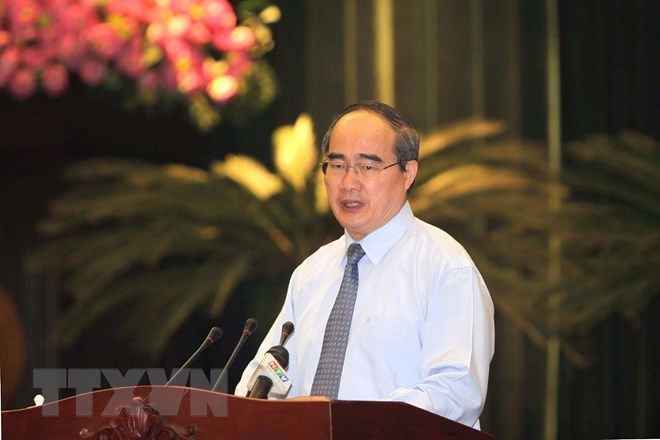 Secretary of the HCM City Party Committee Nguyen Thien Nhan The Ho Chi Minh City Party Committee, tenth tenure, convened its 16th meeting on April 17 to discuss the local socio-economic development in the first quarter of 2018 and a mid-term review plan. Nguyen Thien Nhan, Secretary of the HCM City Party Committee, chaired the meeting. During the event, delegates focused their discussion on the implementation of the National Assembly’s Resolution No.54 to pilot special mechanisms and policies for the city’s development, how the city handled complaints over actions of local governmental officials in breach of the Party’s regulations and the State’s law in the first three months, and the five-year implementation of the city’s action plan on climate change response and enhancement of natural resources management and environmental protection. They also evaluated their mid-term performance over the last two and a half years. In his remarks, Secretary of the municipal Party Committee Nguyen Thien Nhan said the mid-term review will give a comprehensive assessment of the leadership and management in enforcing the resolution of the municipal Party’s Committee’s Congress for the 2015-2020 tenure. It aims to evaluate what have been achieved since 2015 and outlined shortcomings and lessons learned from that. Solutions for the shortcomings will also be proposed, he added. Vice Chairman of the municipal People’s Committee Le Thanh Liem delivered a report on the city’s first-quarter socio-economic and cultural development, saying the local economy continued to expand against the same period last year with positive signals in the fields of industry, agriculture and services, business climate improvement and better support for enterprises. The city’s GRDP hit over 260.3 trillion VND (11.45 billion USD), up 7.64 percent year-on-year, while the total social investment amounted to 65.3 trillion VND (2.87 billion USD), up 8.5 percent. More than 8,000 new businesses were registered with the total capital exceeding 100 trillion VND (4.4 billion USD) and the foreign direct investment was estimated at 1.28 billion USD, he added. The municipal People’s Committee set ten key tasks for the second quarter, including continued enforcement of Resolution No.54, improving the local economy’s competitiveness and business climate, developing mechanism for capital mobilisation for development, accelerating trade and investment promotion overseas to seek new markets, and ensure social welfare. Top Iranian legislator hails friendship association’s contributions
Speaker of the Parliament of Iran Ali Ardeshir Larijani (R) meets VIFA President Dang Nhu Loi Speaker of the Parliament of Iran Ali Ardeshir Larijani appreciated contributions made by the Vietnam-Iran Friendship Association (VIFA) to boosting people-to-people diplomacy between the two nations at his meeting with VIFA President Dang Nhu Loi in Hanoi on April 17. The Speaker told Loi that during his meetings with senior Vietnamese leaders, they put forth important proposals, including opening Persian language classes for Vietnamese students, creating favourable conditions for Vietnamese students to learn in Iran, opening a direct air route between Vietnam and Iran, and developing more tours between the two countries. He expressed his hope that the VIFA will maintain its active participation in friendship, exchange and cooperation activities, thereby helping to further develop the bilateral friendship and cooperation between Iran and Vietnam. Loi briefed the Iranian leader on the VIFA’s activities since its establishment nine years ago, with its target of tightening solidarity between the two countries and fostering bilateral economic ties – an important foundation of Vietnam-Iran relations. He hoped that in the time ahead, the Parliament of Iran will adopt more legal documents to develop bilateral trade cooperation, friendship and people-to-people diplomacy, including activities of the VIFA and the Iran-Vietnam Friendship Association. Speaker of the Parliament of Iran Ali Ardeshir Larijani has been on an official visit to Vietnam from April 15-18 at the invitation of Chairwoman of the Vietnamese National Assembly Nguyen Thi Kim Ngan. Communist Party of Vietnam official pays working visit to China
Nguyen Van Binh, Politburo member of the Communist Party of Vietnam (L) meets Chinese Vice President Wang Qishan in Beijing on April 17. The Vietnamese Party, State and people always attach much importance to and want to join hands with their Chinese counterparts to consolidate the traditional friendship and comprehensive strategic cooperative partnership with China, said Nguyen Van Binh, Politburo member of the Communist Party of Vietnam (CPV). Binh, who is also Secretary of the CPV Central Committee and Head of the CPV Central Committee’s Commission for Economic Affairs, made the statement while meeting with Chinese Vice President Wang Qishan in Beijing, China, on April 17. He suggested both sides continue carrying out the common important perceptions of senior leaders of the two Parties and nations as well as already-signed documents, maintain and increase high-level meetings, and improve efficiency of practical cooperation in various fields. On this occasion, Binh congratulated China on successfully organising the first session of the 13th National People’s Congress and the 13th National Committee of the Chinese People’s Political Consultative Conference. He expressed his hope that under the leadership of the Communist Party of China (CPC), the Chinese people will realise the targets set by the 19th National Congress of the CPC. The Vietnamese Party official also congratulated Wang on his election as Vice President of China. For his part, Wang affirmed that the Party, Government and people of China always treasure ties with Vietnam and stands ready to join hands with the Party, State and people of Vietnam to develop the bilateral relations. He wished that the two sides will continue to exchange high-level delegations, consolidate political trust, promote strategic connections and well control differences in an effort to develop relations between the two Parties and nations in a stable and healthy manner in the coming time. During his stay in Beijing, Binh had meetings with officials of the Central Policy Research Office, Development Research Centre of the State Council and State-owned Assets Supervision and Administration Commission. At these meetings, the two sides shared measures to boost reform, innovation, global integration and socio-economic development in each country. Binh is leading a CPV delegation on a working visit to China from April 15-19 at the invitation of the CPC’s Central Committee. Apart from Beijing, the delegation will also visit Shanghai. Russia’s Irkutsk welcomes Vietnamese firms
Governor of Russia’s Irkutsk province Sergey Levchenko and Vietnamese Ambassador to Russia Ngo Duc Manh (right) Governor of Russia’s Irkutsk province Sergey Levchenko suggested to Vietnamese Ambassador to Russia Ngo Duc Manh at a meeting in Moscow on April 17 that Vietnam and Russia should increase business exchange. The governor said in doing so, difficulties in bilateral trade will be promptly addressed, thus promoting Vietnamese products and attracting Vietnamese investors to Irkutsk. He informed the Ambassador that Irkutsk and Vietnam’s northern province of Quang Ninh are due to sign cooperation agreements in various fields. The Governor expressed his hope for stronger cooperation between Irkutsk and Vietnam as well as Quang Ninh province in particular in the near future. Noting with pleasure the increasing number of Vietnamese students in Irkutsk, Levchenko committed to creating the best possible conditions for the students in the time ahead. For his part, Ambassador Manh applauded efforts made by Irkutsk and Quang Ninh to reach cooperation agreements, saying that it is in line with the Embassy’s plan to promote bilateral cooperation at local levels. Manh pledged to do his utmost to connect Vietnamese and Russian businesses in their search for investment and cooperation opportunities. Levchenko told the Vietnamese News Agency that Irkutsk boasts substantial potential for investment and economic development, naming the province’s advantages such as the largest area of forest in Russia, the largest freshwater lake by volume in the world – the Baikal, and rich mineral reserves. Besides, science-technology, aviation, hydroelectricity and food production are also strengths of the province. Irkutsk is one of leading localities in investment attraction in Russia, he said, noting that in 2017 alone, the province lured over 9 billion USD. The Governor appreciated the contribution of the Vietnamese community to Irkutsk’s development, and the relations between Vietnam and Russia. Highlighting great cooperation potential between the two sides, Levchenko said Irkutsk always welcomes Vietnamese friends. HCM City pledges to support Iranian businesses
Secretary of the HCM City Party Committee Nguyen Thien Nhan (right) and Speaker of the Parliament of Iran Ali Ardeshir Larijani. Ho Chi Minh City commits to creating favourable conditions for Iranian enterprises to cooperate with partners in the city, and run long-term business in the Vietnamese southern metropolis, Secretary of the municipal Party Committee Nguyen Thien Nhan told visiting Speaker of the Parliament of Iran Ali Ardeshir Larijani on April 17. Nhan stressed that HCM City treasures Iranian people’s sentiments towards Vietnam and the city, and stands ready to work together with Iran to further the bilateral friendship and cooperation across fields, thus bringing pragmatic interests to both sides. He said the visit to Vietnam by the Iranian top legislator, which takes place on the occasion of the 45th anniversary of the bilateral diplomatic ties, has contributed to increasing mutual understanding and enhancing relations between Iran and Vietnam, including HCM City. For his part, Larijani said Iranian people were impressed by Vietnam’s struggle for national liberation and reunification. The Speaker, however, pointed out that economic ties between Vietnam and Iran have yet to match potential and aspirations of the two countries. Vietnam and Iran share a lot of similarities, with substantial potential for cooperation, especially in maritime transport, seaport construction, oil and gas, liquefied gas, woodwork and agriculture, he said. Lauding strong development and potential of HCM City, the guest urged the city and Iran to step up information sharing and collaboration, particularly in economy. VNN |
↧
↧
Article 3
Vietnam still struggling to develop supporting industries Vietnam has been trying to develop support industries for 30 years, but is still finding it difficult to squeeze into the global supply chain.
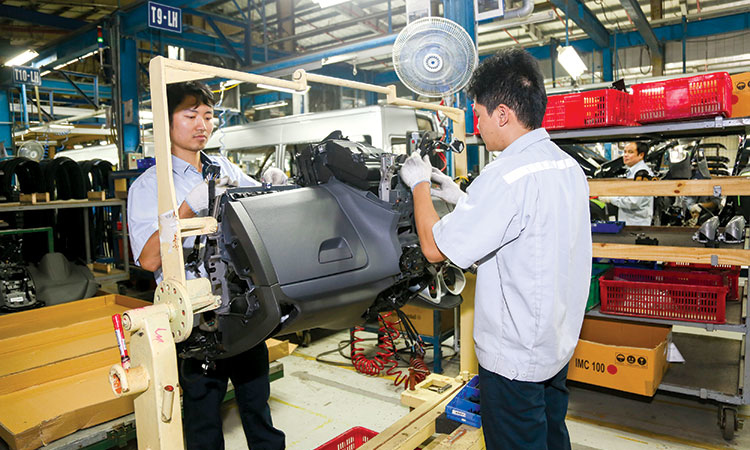 Vietnam vows to develop supporting industries The government has decided that products of supporting industries will have to satisfy 45 percent of essential needs for domestic production and consumption by 2020, and by 70 percent by 2030. However, analysts are pessimistic about the development of Vietnam’s supporting industries and the feasibility of the plan. Amid foreign direct investment (FDI) in the last 30 years, Vietnam has missed opportunities to develop supporting industries. The domestic supporting industry remains underdeveloped and few enterprises have joined the industrial production supply chain. According to the Institute for Industry & Trade Policy Research (ITPR), Vietnam had 1,383 enterprises in supporting industries, mostly operating in three fields – mechanical engineering, electronics and plastics – rubber. The figure accounts for only 0.3 percent of the total number of 500,000 enterprises.
The enterprises can only make simple products and components, such as packages and plastic prototypes, while complex components such as electronic accessories needed for assembling are from foreign-invested enterprises or imports. Kitagawa Hironobu from JETRO (Japan External Trade Organization) said at the 2017 supporting industry forum that 570 Japanese-invested projects were implemented in Vietnam in 2016, but the localization ratio was only 34 percent. Many Japanese enterprises had to import input materials and components from Thailand and China. Nguyen Thi Xuan Thuy from ITPR said that the market capacity in Vietnam is very large. Automobile production and electrical and electronic engineering are fields which need supporting industry products in large quantities. These are the two most developed industries. The domestic automobile market sells 300,000 cars each year and has a growth rate of 24 percent. After 20 years of development, Vietnam has 20 auto assembling enterprises, but has only 84 first-tier vendors and 145 second- and third-tier vendors, small figures compared with demand and with other regional countries. Thailand has 16 automobile enterprises, but has a large network of satellite enterprises with 700 first-tier and 1,700 second- and third-tier vendors. As for the electrical and electronic engineering industry, there are 1,000 enterprises providing components, but Vietnamese enterprises do mostly assembling and trading only. According to Truong Chi Binh from VASI (Vietnam Association for Supporting Industries), 90 percent of components needed in rubber and plastics manufacturing must be imported, while the proportion is 94 percent in electrical and electronic engineering. M. Ha, VNN |
↧
Article 2
HCM City new administrative centre displayed HCM City’s Department of Planning and Architecture is holding an exhibition to show off its proposed new administrative centre.
HCM City's new administrative centre According to the design, the city’s new municipal headquarters will include six floors and four basements, with two subterranean levels lit by natural light. The exhibition, which was started on April 16, is scheduled to last until May 1 at the city’s exhibition centre at 92 Le Thanh Ton Street in District 1. It is aimed to seek the public’s opinion for the design conducted by a firm headquartered in the US. The 18,000 square-metre administrative centre will include offices for eight departments and agencies, an 800-seat meeting hall and libraries. The HCM City Department of Planning and Architecture said that the VIP area of the city’s current administrative centre will be maintained to welcome guests. Meanwhile, the remaining areas will showcase the city’s development to the public. The new and old administrative centres will be connected by a 4,000 square metre garden. Dtinews |
↧
Article 1
Vietnamese men design smart call center out of burning startup dreamTwo enterprising Vietnamese men under thirty years old have established a company offering convenient smart call centers to firms after determined efforts of becoming successful based on business ideas. Pham Tan Phuc and Nguyen Xuan Bang were able to roll out Gcalls, a product which they described as constantly at the forefront of their mind. A visitor to a company’s website incorporated with Gcalls can click on the Gcalls icon and call a customer care employee free of charge. Gcalls also allows calls between smartphone apps, or from an app to a website, and is equipped with various features like forwarding a call and synchronizing the telephone number list. The question “Do you want to make money with a multimillion-dollar idea?” has bound them together since their student time at the Ho Chi Minh City University of Technology, a prestigious higher education institution in Vietnam, where Phuc followed an applied science program and Bang an industrial management one. As students they used their tuition money to embark on the first monkey-making project combining games and online advertising, but they failed. Undeterred, they pursued many other projects and met with failure again. Phuc continued to invest a great deal of his time and effort in the self-employment direction, so much so that his father forced him to leave the house since he was loath to find a job. He lodged with Bang and the two men faced repeated unsuccessful startup attempts. Bang arrived in Germany to study and had a stable part-time job for half a year but decided to return to Vietnam to join Phuc in a new startup venture with Gcalls. In 2015 they founded the Singapore-based Gcalls Joint Stock Company, which initially received an investment of US$31,000 from an Australian telecommunications corporation, $8,000 from BFBZ Investments Pte. Ltd., and $19,000 from another organization. The investments tided them over in early stages since the inception when their product, the call center, was bought by only two corporate customers. The enterprise now has 28 users, with 67 potential customers awaiting the perfection of Gcalls features. The largest investment Bang and Phuc have obtained, $1 billion, came last year from VinaCapital – a major investment and real estate development company in Vietnam. The founders are prepared to expand their business by forming another branch in their homeland, targeting small and medium-sized firms in the first steps. “Phuc and Bang possess an inquiring mind and enthusiasm, and are particularly persevering. They’ve exhibited a sense of responsibility, the bravery to challenge themselves and willingness to make changes and take action,” said Pham Duy Hieu, director of the Startup Vietnam Foundation. |
↧
Article 0
T&T Group violation may fetch $44,052 fineT&T Group may be fined for up to VND1 billion ($44,052) for constructing three additional floors to its high-end trade and service building in the central province's Nghe An's Vinh city. A deliberate violationT&T Group’s high-end trade and service building located in Vinh city received the building permit in early 2017 from the Nghe An Department of Construction with the approved detailed construction plan of 86.75 metre overall height, including 25 apartment floors and one technical floor.
When the construction was at the 17th floor, T&T Group sent a document to the Nghe An People’s Committee to adjust the building height’s from 25 to 28 floors. Accordingly, in May last year, the Nghe An Department of Construction issued Document No.1069/SXD–QLHDXD providing instruction on procedures for adjusting the building’s height. However, despite the local Department of Construction’s guidelines, T&T Group simply went ahead adding the floors without finishing the necessary procedures. On June 12, 2017, the Nghe An Department of Construction inspected the project, then discovered that the 26th floor was being constructed. Shortly afterwards, the department ordered T&T Group to stop construction and only continue after receiving authorization from relevant authorities. Vinh city’s urban management authorities on June 27, 2017 discovered that T&T Group has been ignoring the department’s orders and was constructing the 28th floor already. VND1 billion ($44,052) potential fineAccording to Phan Thanh Son, leader of Vinh city’s Urban Inspection Team, after the Vinh City People’s Committee issued Decision No.4078/QD-UBND to issue administrative sanctions against T&T Group for intentionally violating its building permit licensed by the Nghe An Department of Construction on January 6, 2017, T&T Group only paid a fine of VND40 million ($1,762). However, to date, there are no plans to resolve this case satisfactorily. Meanwhile, an inspector of the Nghe An Department of Construction said that if the province initiated proceedings on this violation on construction regulations, T&T Group may be fined up to VND1 billion. |
↧
↧
Article 3
Social News 19/4 New Zealand Education Fair 2018 charmed parents and students The New Zealand Education Fair 2018 held in Ho Chi Minh City (April 7) and Hanoi (April 8) attracted more than 1,000 participants and offered a holistic experience of being a student in New Zealand. With more than 60 top institutions from New Zealand, this fair brought useful information and attractive activities such as simulated classrooms guided by Kiwi teachers as well as informative consultancy with New Zealand education experts and alumni. The New Zealand Education Fair is an annual event organised by Education New Zealand with the support of the New Zealand Embassy (Hanoi) and the New Zealand Consulate (Ho Chi Minh City). This is one of the largest in-market educational promotional events in the calendar year in Vietnam. New Zealand Ambassador to Vietnam Wendy Matthews said in her opening remarks: “As you all may know, we saw a 60 per cent increase in the number of first-time Vietnamese student visas to New Zealand in 2017 and those numbers have continued to grow through the first quarter of 2018. This New Zealand Education Fair is one of our commitments to strengthening education relationships as well as increasing the number of Vietnamese students studying in New Zealand.” This year marked the largest amount of registrations from New Zealand institutions. More than 60 institutions, including universities, ITPs, PTEs, and high schools sent representatives. “We are thrilled to have such a wide selection of New Zealand education institutions attending our upcoming Fairs in Vietnam. Prospective students and parents will not have a better opportunity to speak directly with the institution representatives and learn why New Zealand’s education system is ranked at the very top for preparing students for the future,” said Ben Burrowes, Education New Zealand’s regional manager, Southeast Asia. Noticeably, the Fairs successfully organised simulated New Zealand classrooms for both high school and tertiary institutions hosted by Kiwi teachers and demonstrated New Zealand’s unique and world-leading learning environments. The 30-minute classes provided snapshots of the education system recognised as the world’s best by The Economist Intelligence Unit’s 2017 Educating for the Future Index. The lessons did not only focus on theory, but also helped students develop personal skills such as teamwork and problem-solving. Instead of learning by subjects, students acquired new knowledge through project-based methods. Nana, a grade 10 student from Minh Khai High School, said: “I used to study in a primary school in New Zealand and I will be back to New Zealand for high school. This simulated classroom is really similar to what I experienced in primary school. The interaction of teachers and student is very comfortable, like we exchange knowledge—it is very unlike the relationship between trainers and trainees.” Nguyen Hung (one of the parent-visitors) said: “I am impressed by the classroom’s decoration as well as arrangement of round tables and how students are divided into small groups. This helps students easily interact with each other when studying. Every member can easily see and talk to each other, and so can the teacher.” Julie Saikkone, representative of Westlake Girl’s High School, shared her thoughts: “We do not only focus on developing study skills, but we also concentrate on outdoor activities, especially arts and sports. We strongly invest in infrastructure such as installing manmade-grass for hockey, football, tennis, and cricket. And we are one of the top 5 national team in rowing. Air New Zealand continues to be the sponsor of New Zealand Education Fair. This year the company offered two return flights and promotion packages to New Zealand to two lucky draw winners. VOV to introduce Vietnamese and Egyptian culture and music
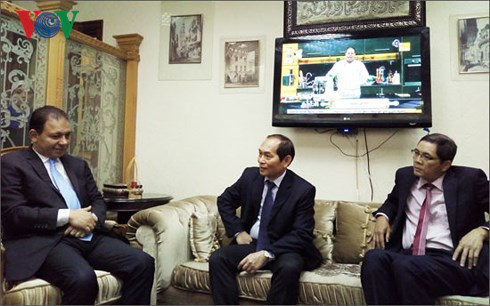 Radio and television programs will help Vietnamese and Egyptian peoples gain more insights into culture, music and life of each nation, said Vice President of the Voice of Vietnam (VOV) Nguyen Xuan Huy at the working session in Cairo with leaders of Egypt National Radio on April 17. He said that both sides commit to making concerted effort to promote practical and effective cooperation in the time ahead VOV Vice President Nguyen Xuan Huy and the VOV delegation have met with Head of the International Relations in the Egyptian Radio & TV Union (ERTU) Basma Habib, Chairwoman of the Egypt National Radio Nadia Mabrouk and Head of the television sector at the Egyptian Radio and Television Union Magdi Lashin. At the working session, Mr Huy affirmed that VOV is willing to cooperate with Egyptian media agencies in sharing information and realizing the Memorandum of Understanding signed between VOV and Egypt National Radio in 2017. Both sides committed to exchanging radio and television programs on culture, music and tourism in the coming time to deepen mutual understanding between the two peoples. vov to introduce vietnamese and egyptian culture and music hinh 1 Chairwoman of the Egypt National Radio Nadia Mabrouk reaffirmed her commitments to enhancement of cooperation between the two radio agencies, especially in association with political and cultural events and celebration of the 55th anniversary of the establishment of diplomatic ties between the two countries. Both sides will also cooperate in strengthening the exchange of reporters, sharing experience in the application of science and digital technologies for the development of the two countries’ national radio agencies . vov to introduce vietnamese and egyptian culture and music hinh 2 VOV Vice President Nguyen Xuan Huy said as a multimedia communication agency, VOV will fully utilise the resources provided by Egyptian radio and television stations. On the occasion, VOV delegation also visited the Egyptian department for the application of science and technology in broadcasting and television. Taste of Mongolia at Windsor Plaza Hotel
Chef Dagvadorj Lkhagva and Chef Usbold Tumurbaatar will introduce Mongolian traditional dishes at Café Central An Dong from April 20 to 29 From the vast and open sweep of the Mongolian steppe, hardy nomadic people have developed a cuisine unique in the world, and this will form the center-piece of Windsor Plaza Hotel’s Mongolian Culinary Fair. At Café Central An Dong at Level 4, Windsor Plaza Hotel in HCM City’s District 5, from April 20 to 29, guests will be treated to two different buffets of traditional Mongolian fare presented by two visiting guest chefs from the country’s capital, Ulaanbaatar. Chef Dagvadorj Lkhagva is the Executive Chef at the Blue Sky Hotel & Tower, where Chef Usbold Tumurbaatar is also the Chef De Partie. Both men have a deep knowledge and understanding of the culinary traditions of their homeland, while also benefiting from extensive training and experience in Europe. Some of the traditional dishes for guests to enjoy include smoky ox tongue, char grilled BBQ lamb skewers, spinach dumpling soup or baked meatballs with egg and bone marrow. Desserts are also a highlight, with offerings including iced honey and yoghurt, barley flour truffles with chocolate or dried milk curds. This unique gastronomic adventure is available Monday to Friday from VND468,000 per person at lunch and from VND698,000 per person at dinner. Both include a free flow of German beer and house red and white wine. On the weekend, diners can enjoy lunch from VND518,000 per person and dinner from VND798,000 per person, including a free flow of sparkling wine, house red and white wine and German beer. 4 crewmembers rescued in Đà Nẵng
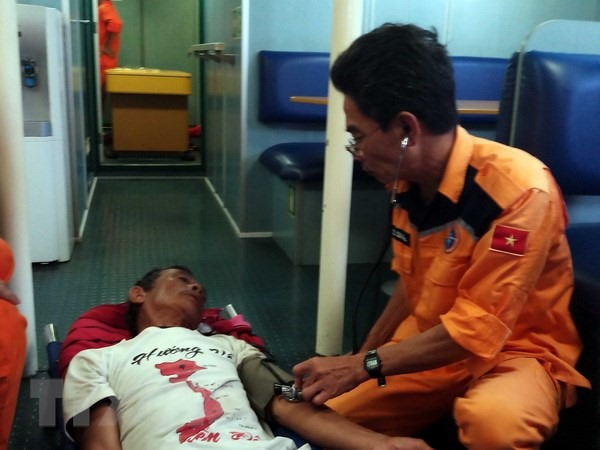 One of the four crewmembers gets treated after the rescue. Four crewmembers of a boat that sank in the sea off central Đà Nẵng City were rescued on Tuesday, according to Regional Maritime Search and Rescue Coordination Centre No II. The boat, coded ĐNa 90765 TS, sank at some 8pm on Monday while going offshore for fishing. The four boatmen clinked to a coracle to survive, but their health began to deteriorate after spending several hours in the sea without food and water. However, another boat, coded ĐNa 90279 TS, found the victims and rescued them offshore. The Việt Nam Maritime Search and Rescue Coordination Centre rescued the crewmembers onshore on Tuesday evening. They are undergoing treatment. Tien Giang to apply Zalo in building smart urban model
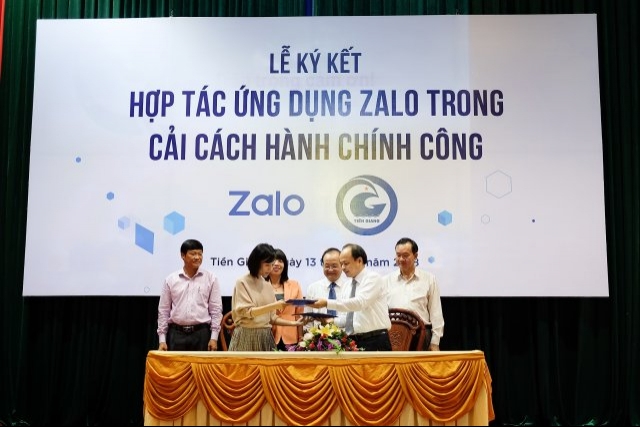 A signing ceremony for an agreement between the Tien Giang Provincial People’s Committee in the Mekong Delta and Zalo, regarding the deployment of public administration and e-administrative services, took place within the framework of a conference held on April 13 at the Tien Giang Provincial Conference Center on implementing the “Building My Tho into a Smart Urban Area in 2017-2020” project. In attendance was Mr. Tran Thanh Duc, Vice Chairman of the People’s Committee, Ms. Le Thi Kim Xuyen, Director of Zalo’s 4.0 Project, and many officials of all levels. Developing e-government is one of the matters Tien Giang province is focusing on in building an intelligent urban model, along with surveillance cameras, smart traffic networks, smart education, and smart tourism. Local people can access zalo.me/hcctiengiang or search for “Tien Giang Province Public Administration Portal”. Existing services include document search by receipt code or QR code and latest news on the socioeconomic situation, administrative reform, and new policies in the province. Other services in smart urban planning, such as smart travel, smart camera, smart traffic, smart education, and bus maps will be integrated into Zalo in the future. Building a smart city poses the challenge of local people being able to keep pace with technological development. Mr. Tran Van Dung, Director of the province’s Department of Information and Communications, said Vietnam’s IT system is developing very well, especially its broadband infrastructure and the greater use of smartphones. Interaction with the government and utilizing information systems that benefit the people is becoming increasingly straightforward. “The Smart Urban Model is designed to help citizens interact with authorities and access accurate information, and is geared towards every individual and household,” said Mr. Dung. Measures discussed to promote occupational safety for young workers 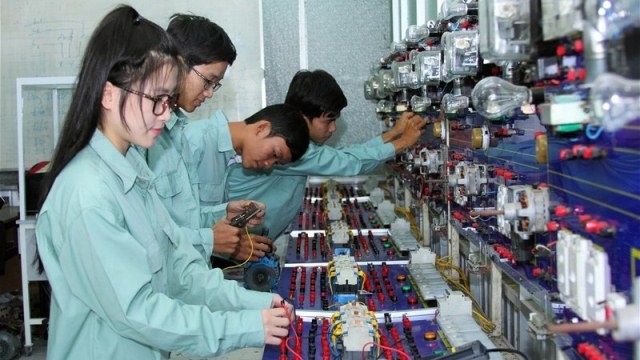
Secondary level students will be soon offered a safe work skills course as part of their education. Experts gathered at an international forum held in Hanoi on April 16 to discuss measures to promote occupational safety and health (OSH) for young workers in Vietnam. The event was co-organised by the Department of Work Safety (DWS) under the Ministry of Labour, Invalids and Social Affairs and the International Labor Organisation (ILO) under the theme of “A generation of safe and healthy workers”. According to ILO statistics released at the event, about 350,000 people die each year from occupational accidents and about 2 million die from work related illnesses. In addition, more than 313 million workers have suffered severe injuries and lost their ability to work due to occupational accidents. Currently, the world has 541 million young workers (aged 15-24), including 37 million child labourers. Child labour represents more than 15% of the workforce around the world and young labourers face a higher risk of occupational injuries and work related illnesses than those over 25 years of age. In Vietnam last year, 9,143 victims suffered from 8,856 occupational accidents nationwide. As a country with a large number of young labourers, Vietnam has issued a range of policies and regulations aimed at ensuring OSH for young workers, but there are still many difficulties and limitations in preventing and reducing occupational accidents, said Head of the DWS, Ha Tat Thang. He identified factors that could make young Vietnamese workers vulnerable. For example, young workers are in their physical and psychological development stage, with a lack of work experience and training, as well as with limited awareness of work-related hazards and negotiation skills. However, young employees still accept dangerous tasks or unsafe working conditions to earn their living. Thang said that there is currently a need to raise awareness among young workers, especially those working in the agricultural sector, to help them better understand the basic concepts of OSH, in addition to the use of safety equipment. He added that when providing training and information for young workers there should be a focus on the negative consequences of occupational incidents as well as on the requirements for better OSH. Valentine Offenloch, Programme Officer from the ILO’s Safe Youth Work Project, proposed that Government and State management agencies integrate OSH into educational programmes at all levels to promote the rights and obligations of workers and employers. She also suggested promoting skills development for identifying, removing, and controlling hazards and risks for young workers in Vietnam. Deputy Head of the DWS, Nguyen Anh Tho, said that for many years, the Government has allocated a budget to develop training programmes on OSH for students at vocational training centres and colleges. The programmes will be soon offered at secondary and lower education levels to equip learners with safe work skills, she added. Experts at the forum exchanged lessons aimed at promoting a campaign for tackling challenges, raising awareness, and improving working conditions to ensure OSH for Vietnamese young workers. Bidding document of My Thuan – Can Tho Highway project sold The Transport Ministry's Thang Long project management board has sold bidding document to select investors for the My Thuan – Can Tho Highway project from April 15 to May 15. Transport Minister Nguyen Van The said that the highway building can last longer than planned because it takes time to treat weak ground. He asked related agencies to quickly start the construction; first of all, they should put the work out to tender in the second quarter this year to select investor. In the next time, the Thang Long management board will send its document to the Transport Ministry and the Prime Minister about mechanism relating to fee collection of Ho Chi Minh City – Trung Luong highway to support the new project. The 23.6 meter long My Thuan – Can Tho highway will start at the National Road No. 80 intersection and end at Cha Va – National Road No.1 intersection in the Mekong delta province of Vinh Long. In the first stage, the highway will be built with four lanes and designed vehicle speed of 100km per hour. The construction of the My Thuan- Can Tho Expressway on a build-operate-transfer basis costs over VND5.4 trillion (US$211.7 million). Scandal of cryptocurrency transactions by Ifan group worsens
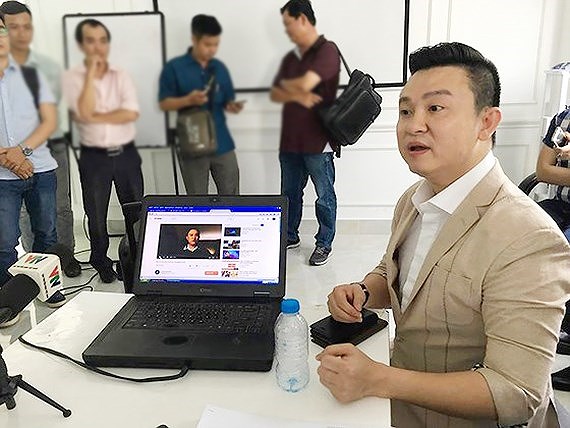 Diep Khac Cuong denies the rumor that he was co-founder of Modern Tech Company On April 12, the fraud of ifan group accused of tripping 15 trillion dong is worsening when several investors strongly protested to Diep Khac Cuong's comments that he was not the co-founder of Modern Tech Company and not involved in the Ifan group project. Diep Khac Cuong on April 9 was blamed for involving in the scandal of cryptocurrency transactions by Ifan group that led to the loss of VND15 trillion. He then denied the rumor that he was co-founder of Modern Tech Company ( Bitcoin and other cryptocurrencies trading company). Ms. NC, a large investor in the Ifan project, said through a friend's recommendation (who was close to the founders of Modern Tech), she believed in the promise of buying virtual currency IFan and Pincoin with the interest rate of 48 percent per month. Thus, she invested in Ifan project. Ms. NC confirmed that she then attended the workshops in which and Diep Khac Cuong and other organizers of the Ifan project reported a "dream vision" of trading cryptocurrencies. "In those workshops calling for investment with the participation of several hundred people, Mr. Cuong introduced himself as the Chairman of the Ifan Project, guaranteeing that this project would be highly profitable," said Ms NC. She also affirmed that Cuong could not be unrelated and innocent as he explained. Similarly, another investor named NV also confirmed that Diep Khac Cuong, singer Dam Vinh Hung and many other celebrities attended the event. When interviewed by TV and press reporters, these two people also talked about the Ifan project. In particular, Cuong lectured that those who would make investment on the projects would get high profits. Believe in these words, Mr. NV borrowed money from friends and relatives to buy virtual currency but so far they have not received any profits, facing the risk of losing several billion dongs. "Mr. Cuong’s statement that he was unrelated in the scandal is unreasonable”, said he. “It is known that Mr Cuong is still holding money from investors, " said NV. He added that, just because they believed in Mr Cuong, hundreds of people decided to invest in the project. So far, they have defaulted. Basing on the above arguments and evidences, Ms. NC and many other investors are consolidating legal documents and evidences and making denunciations to the police. In Hanoi, there are people who were cheated by Ifan group. The victims said that the people directly calling for investment in the ifan virtual currency project are Diep Khac Cuong and Le Ngoc Tuan (Tuan-Euro – based in 24 Thai Thinh, Nga Tu So district, Dong Da district, Hanoi). Modern technology has been pushing investors, buy virtual currency ifan as a valuable stock, but instead of issuing stock, Modern Tech spent this money to raise capital. The company strives to invest in virtual currency, with Ifan achieving the lowest return of 48% per month with a payback period of up to 4 months. If an investor invites other people to participate, they also receive a commission of 8%. In another development, on April 12, Director of the Information and Communication Department of HCM City, Duong Anh Duc, informed the reporters of SGGP newspaper, the Department would review and resolutely sanction all the propaganda, advertising of virtual currencies trading. The propaganda, advertising as well as the purchase, sale of digital currencies, virtual currencies on the Internet are considered illegal and will be punished according to regulations. On the same day, Department of Information and Communication also announced some information related to the management of cryptocurrencies. Accordingly, today's most popular virtual currencies can be classified into digital money (money generated from algorithms) and virtual currencies. At present, more than 1,000 types of digital money, virtual currencies have been created and are circulated, some popular digital money are Bitcoin, Ethereum, Litecoin. These currencies are not geographically limited. National laws are different from country to country in relation to the recognizing and legalizing of such virtual currencies. However, according to Vietnamese law, organizations and individuals are not allowed to use, trade in digital money or other similar cryptocurrencies to pay for goods or services. The use of virtual currency is a violation of law that may be prosecuted for criminal liability. Although there have been many warnings, many people in Vietnam still make investment and transaction of cryptocurrencies. Therefore, there has been many deceptive cases relating to multi-level business, purchase of virtual items online. Many cases that have been handled by the authorities shocked public opinions... The common pattern in these scandals is that people believe in the promise of high profit and they then suffered financial losses themselves. Once more, the Department of Information and Communication recommends organizations and individuals not to conduct propaganda, advertising as well as participate in the purchase and sale of digital money, cryptocurrencies on the Internet. People should be alert, raise vigilance and awareness that the investment, this kind of business is not recognized by law, the Department concluded. Photo exhibition on Vietnamese-French leaders meetings opened in HCMC
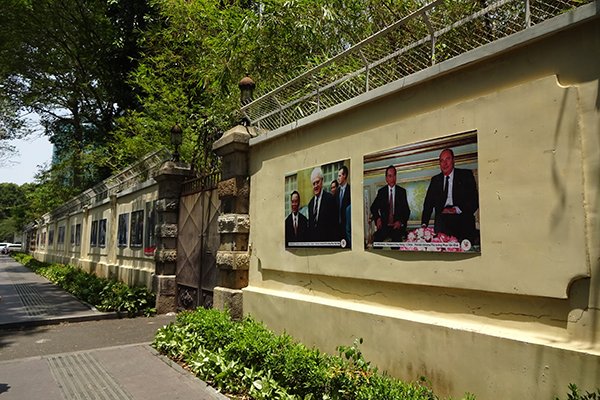 The exhibition is opened to every one, with large-size photos hung on the surrounding walls of the French Consulate General in HCMC The French Consulate General in HCMC is hosting a photo exhibition on meetings between Vietnamese and French leaders to mark the 45th anniversary of Vietnam-France diplomatic ties and five years since the two countries set up strategic partnership. The large-size photos are attached on the surrounding walls of the French Consul General’s residence on Le Duan Street in HCMC’s District 1 for public viewing. All of them have the official logo of the 45th anniversary of Vietnam-France diplomatic relations. Featuring meetings between Vietnamese and French leaders over the past 45 years, the exhibition mirrors the steadfast friendship between the two countries. Speaking to the Daily, French Consul General in HCMC Vincent Floreani said all of the meetings have played important roles in maintaining and promoting the relations between Vietnam and France. However, he was impressed the most by the meeting between former Vietnamese President Le Duc Anh and former French President François Mitterrand in Hanoi in February 1993 because this was the first visit to Vietnam by a leader of a Western country after 1975. The diplomat also highlighted the meeting between General Secretary of the Communist Party of Vietnam Nguyen Phu Trong and French President Emmanuel Macron in March 2018, which summarized the Vietnam-France relations in nearly half a decade and marked five years since the two countries became strategic partners. “The greatest achievement of Vietnam and France over the years is that our relationships have always been going up, covering all levels, from the governments to localities and citizens, and all sectors, from economic development to politics, science-technology, healthcare and education,” he said. According to the French Consul General, in addition to this photo exhibition, there will be a lot of other activities to mark the 45th anniversary of Vietnam-France diplomatic relations in the coming time. He hoped there will be more meetings between leaders of the two countries in the future, contributing to deepening their friendship. Code literacy training project launched in Mekong Delta
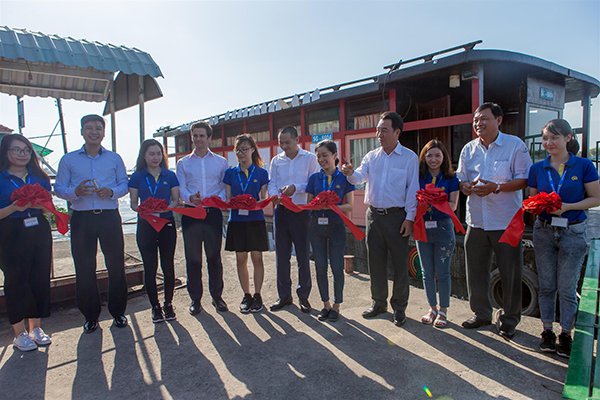 Owner Larter (4th L), senior manager of government affairs at Microsoft Corporation, and TDF general manager Nguyen Van Hanh (6th L) cut the ribbon to launch the Enabling Boat project Microsoft Vietnam and The Dariu Foundation (TDF) launched the “Enabling Boat” project last week, aiming to support disadvantaged youth in the Mekong Delta to get access to computer science and code literacy. Enabling Boat will be carried out in three Mekong Delta provinces of Vinh Long, Tien Giang and Hau Giang as part of the annual project “Youth Spark Digital Inclusion”. Microsoft Vietnam and TDF will provide computer skills and code literacy training courses for 35,000 students, of which 10,000 students will be trained with Scratch and Kodu. Besides, more than 200 local teachers from the three provinces will be engaged in Training of Trainers (ToT) and participate in training workshops that aim to share experience in teaching methods of computer programming. The project is also expected to create an environment for rural students to develop critical thinking, logic skills, creativity, and problem solving skills, and motivate them to build their future with technology. “Thanks to Enabling Boat project, I had a chance to participate in the Hour of Code program. It was very exciting to learn coding with Minecraft Education. I hope this project can help me achieve my dream job as a programmer in the future,” said Nguyen Thi Tieu Yen, student of Luu Van Mot High School. According to the Digital Transformation Study in Asia Pacific 2018 conducted by Microsoft and IDC, one of the biggest barriers to digital transformation is the lack of skills and resources. “What we should care is to ensure every individual, especially the young generation, is prepared with the right skills for the future. Technology is the key to economic transformation and Microsoft is here to help,” said Pham The Truong, general director of Microsoft Vietnam. Sharing about the cooperation with Microsoft, TDF general manager Nguyen Van Hanh wished to continue to receive support from Microsoft to accompany the rural students and teachers in the programming language training, thus improving educational level in the Mekong Delta. Danang resort and hotel launch promotions to celebrate fireworks festival
 The Novotel Danang and the Premier Village Danang Resort are offering a number of promotional programs for the upcoming DIFF 2018 To mark 10 years since the first Danang International Fireworks Festival (DIFF) and the creation of the brand name, the Premier Village Danang Resort is offering the promotional rates starting from VND12.5 million, including daily buffet breakfast and complimentary DIFF 2018 tickets. The promotion is applicable for bookings from now and staying period during DIFF event days. The Novotel Danang Premier Han River also runs some fantastic promotions to celebrate the milestone. Starting from April 30 to the end of June 2018, the Novotel Danang will select six prime locations in the hotel for the best viewing of the fireworks. Located on the fourth floor and 29th floor, the Splash pool, the Square restaurant and Premier Lounge will be converted into exclusive venues to watch the fireworks. These three locations will be opened to public. Additionally, private viewing rooms will be available in the hotel’s Oasis Spa room, selected meeting rooms and Corner suite room. Over the past eight events, DIFF has constantly reinvented itself and has now developed into a world-class cultural and tourist event that is hosted annually from April to June. DIFF 2018 themed The Legend of Bridges will take place from April 30 to June 30 and comprise spectacular fireworks nights and a series of side events. Danang launches electric vehicles to serve tourists 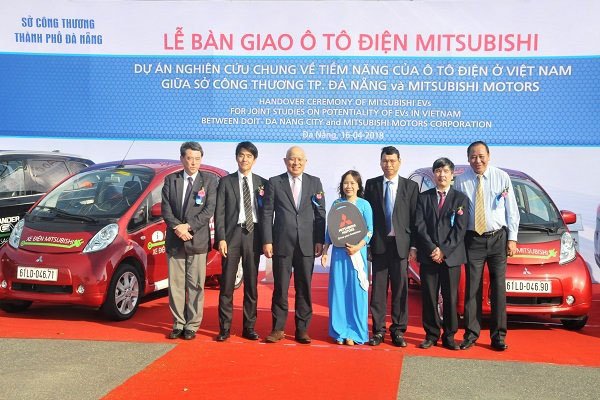
Leaders of Mitsubishi Motors Corporation and Danang City at the electric vehicle handover ceremony Danang City will put electric vehicles into use to take tourists to places of interest within the city and World Heritage sites in neighboring Hue and Hoi An, said a leader of the central coastal city. Ho Ky Minh, vice chairman of the city government, announced the news on April 16 at a handover ceremony for four Mitsubishi electric automobiles along with two electric adaptors and accessories valued at US$400,000. This handover is the next step under a cooperative program between Mitsubishi Motors Corporation (MMC) and the Ministry of Industry and Trade to foster the use of electric vehicles in the country, Minh added. Speaking at the event, Kunihide Kume, deputy general director of Misubishi Motors Vietnam, explained why Danang City was chosen to be the first pilot place. Danang and surrounding areas are home to a lot of renowned tourist attractions, and the city has sufficient infrastructure suitable for driving tourists to faraway places, not only being limited in the city. In the years to come, leaders of MMC and the Danang Department of Industry and Trade will work together to launch more electric vehicles for tourism as well as social life in Danang, which will contribute to lowering carbon dioxide emissions, said Kume. At the event, MMC handed over two i-MiEV electric vehicles, two Outlander PHEV hybrid vehicles, and two rapid adaptors to Danang. While the i-MiEV can travel 60-70 kilometers for a single charge, the Outlander using hybrid technology will recharge itself while in use, so the latter can be used for a long-way drive. Sustainable agro-project benefits 27,650 farmers in Can Tho
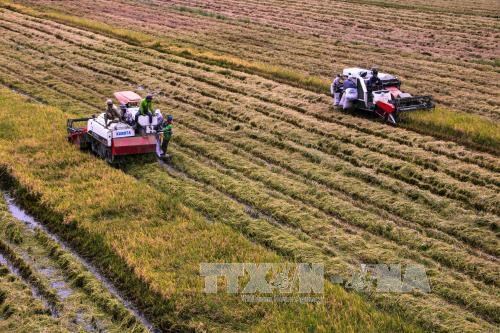 Some 27,650 farmers in the Mekong Delta city of Can Tho benefited from VnSAT Some 27,650 farmers in the Mekong Delta city of Can Tho benefited from the Vietnam Sustainable Agriculture Transformation project (VnSAT) over the last two years, heard a meeting in the locality on April 17. Addressing the event, Vice Chairman of the municipal People’s Committee Dao Anh Dung highlighted the significance of the project, noting that the the largest official development assistance agricultural project in the locality must be implemented in to bring maximum benefit to local farmers. According to Dung, Can Tho was allocated about 210 billion VND (more than 9.2 million USD) for the project, which is mainly used to invest in infrastructure development for farmers’ organisations and cooperatives. Nguyen Thi Minh Hieu from the municipal Department of Agriculture and Rural Development, said as of April 2018, the VnSAT’s management board in Can Tho organised 550 training courses for 24,300 farmers. Nearly 33,000 ha of cultivation land in the locality is using sustainable rice cultivation solutions. The model helps reduce production cost by 4 million VND per hectare and increase profit by 6 million VND a hectare compared to other cultivation methods. As many as 16 cooperatives in Vinh Thanh, Thoi Lai and Co Do districts of Can Tho have joined the project. They have been provided aid worth in excess of 70 billion VND (over 3 million USD) to build infrastructure and purchase equipment for post-harvest processes. In 2018, VnSAT hopes to aid nearly 14,000 more local farmers, helping increase profit by 20 percent for each hectare of cultivation area. An additional 311 training courses on farming techniques will be also held in the year. After two years of implementation of the project in the Mekong Delta, the total area of rice in the model purchased by enterprises was 23,000ha out of 50,000ha of the project's target and profit increased by 14 percent. Specifically, average profit of areas of rice involved in the project in the region averagely increased by 14 percent, from 33.1 million VND (1,454 USD) per hectare to 37.1 million VND (1,630 USD) a hectare. VnSAT, part of the World Bank’s national cooperation strategy, is implemented in five Central Highlands provinces and eight Mekong Delta localities from 2015 to 2020 with a total capital of more than 300 million USD, of which 230 million USD comes from the bank’s preferential loans. Its objectives are to help promote agricultural restructuring through increasing the sector’s institutional capacity, renewing sustainable cultivation methods and raising the value chain for rice production in the Mekong Delta and coffee crops in the Central Highlands. Fifth Vietnam Book Day opens in Hanoi
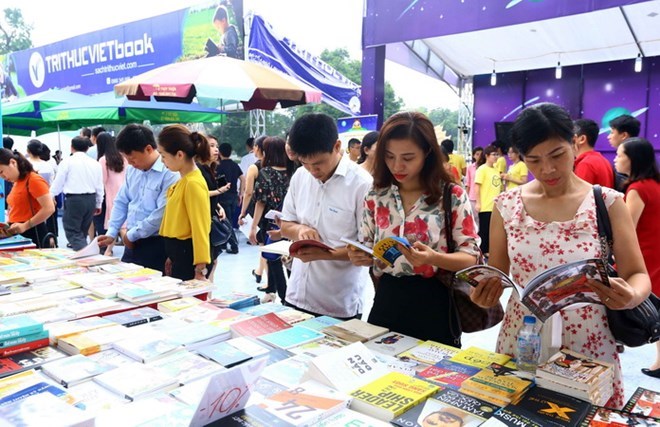 Visitors at the event The fifth Vietnam Book Day kicked off in Hanoi on April 18, in the presence of Vo Van Thuong, head of the Communist Party of Vietnam (CPV) Central Committee’s Commission for Information and Education. Minister of Information and Communications Truong Minh Tuan said through four years of organisation, the Vietnam Book Day has become a cultural event to promote reading culture in the community. It also contributes to supporting books for localities in the remote and ethnic minority areas which are thirsty for information and knowledge, he added. According to the minister, this year’s event is held at a larger scale than previous years, with nearly 20 events, including the introduction of the book “Industry 4.0, revolution of convergence and saving”, talks on “Books – culture, development and integration” and “picture book markets in Vietnam and the Republic of Korea”, and other activities such as games, painting contests, and lucky draw. As an important activity of the Book Day, a book festival themed “Book and Family” will run until April 24 to foster connectivity between authors and readers as well as encourage and develop reading culture among the community to build a learning society. It features over 100 pavilions of nearly 80 publishers nationwide, showcasing 50,000 book titles of various genres. Exchanges between authors and readers and an introduction of popular books are among the highlights of the festival. In 2014, the Prime Minister decided to take April 21 as Vietnam Book Day in connection with the debut of the Book “Duong Kach Menh” (The Revolutionary Path) by President Ho Chi Minh, the first work written in Vietnamese and printed by Vietnamese workers (April 21, 1927). The fifth Vietnam Book Day will last until April 22 at the Thong Nhat park. Students off due to scrap dump fire
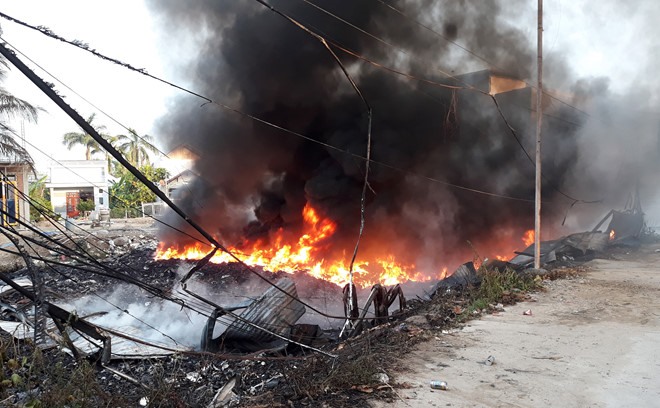 Fire engulfs a scrap dump in Nha Trang City. - Photo news.zing.vn Over 500 students of Vĩnh Ngọc primary school in Nha Trang City of central Khánh Hòa Province were ordered to stay home on Wednesday morning. The move was intended to prevent the children from inhaling toxic smoke from a nearby scrap dump fire. Flames had engulfed a 500sq.m scrap dump in a residential area some 100m from the school in Xuân Lạc 1 Hamlet of Vĩnh Ngọc Commune early Wednesday morning. Witnesses said the fire started in the dump and spread quickly. Dark smoke was reported. There were no injuries so far. Firefighters faced difficulty in extinguishing the flames because of the flammables such as plastic bottles and styrofoam boxes spreading across the site. As of 4am, the fire had reignited and covered almost the entire dump. Lê Văn Mỹ, chairman of Vĩnh Ngọc Commune’s People’s Committee, told Thanh Niên (Young People) newspaper that the fire was under control by 7am. The case is under investigation. 1 killed, 3 injured in steel factory collapse
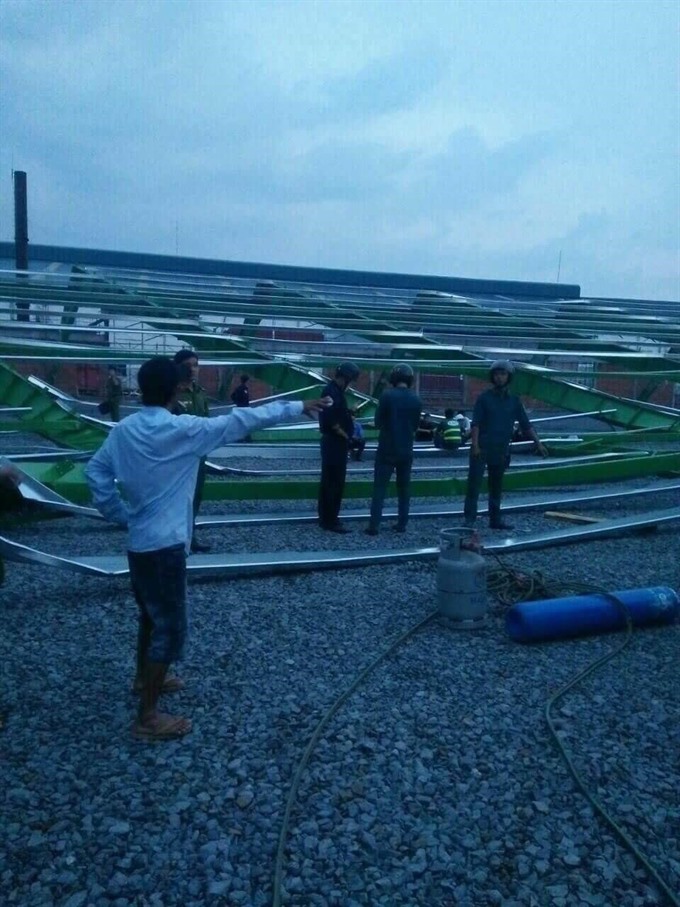 An under-construction steel factory collapsed due to strong wind in BìnhDương Province, killing one and injuring three others. One person was killed, and three others were seriously injured when an under-construction factory in Bến Cát Town in southern Bình Dương Province collapsed on April 17 afternoon due to strong wind. The injured are undergoing treatment at the provincial hospital. The factory, belonging to an individual company, was located in Mỹ Phước 3 Industrial Park, according to police in Bến Cát Town. “The workers were working on the construction of the steel factory. It was raining, and the wind was strong, which knocked down the factory,” a police source said. “One of the workers could not run fast, and an iron bar fell on him, resulting in his death,” he added. Police in Bến Cát Town and Bình Dương Province reached the spot to inspect and investigate the matter. At 7pm on April 17, police gathered information from witnesses for the investigation. Quang Ngai prevents illegal fishing in foreign waters 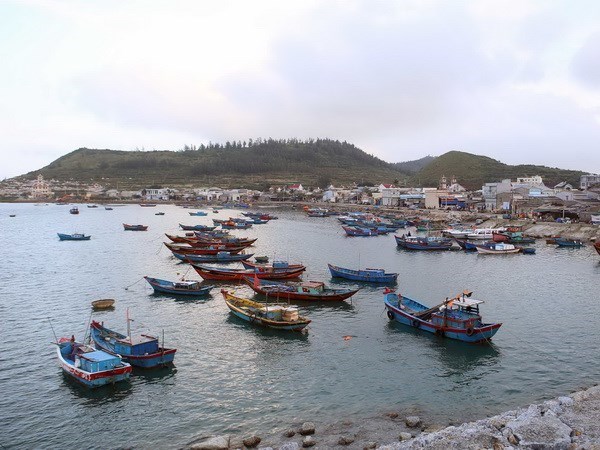
The docking area for fishing boats in An Hai commune of Ly Son district, Quang Ngai province The central coastal province of Quang Ngai has deployed tough measures to stop illegal, unreported and unregulated (IUU) fishing in foreign waters, especially after the European Commission (EC) issued a “yellow card” warning to the country’s fishery sector. Besides increasing communication campaigns for fishermen in coastal districts and communes, the province has enhanced surveillance of offshore fishing boats and will revoke operation licences of violating fishermen and vessels. Criminal punishment will be applied if ship owners deliberately repeat violations. Le Bang, a fisherman from Tinh Khe commune, Quang Ngai city, said fishermen should catch fish in Vietnamese waters, adding that they will lose all their property if arrested in foreign waters. Nguyen Quoc Chinh, Chairman of An Hai fishery trade union in Ly Son island district, said his union has raised fishermen’s awareness about the serious consequences of fishing illegally in foreign waters, including inspections on all of their aquatic products and even bans from exporting. Meanwhile, deputy head of the local seafood department Phung Dinh Toan said the department has promulgated regulations of the Law on Fisheries 2017 for fishermen. The EC issued a "yellow card" warning to Vietnam in September 2017 after the country failed to demonstrate sufficient progress in the fight against IUU fishing. On December 13, 2017, Prime Minister Nguyen Xuan Phuc issued a directive on some urgent tasks following the EC’s warning. The whole political system, from the central to local level, and fishermen of Vietnam have taken actions to fight IUU fishing. There have been an array of measures, including supplementing anti-IUU fishing regulations, enforcing issued regulations, disseminating solutions to fishermen and relevant parties and enhancing cooperation with coastal and island countries to prevent IUU fishing. Solutions sought to drought, saline intrusion in Mekong Delta
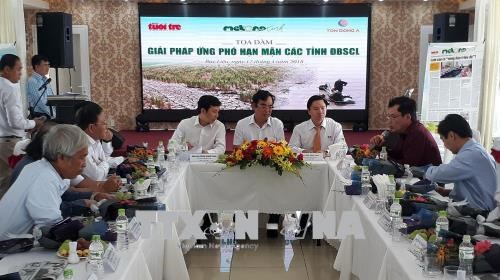 At the workshop Measures to deal with drought and saline intrusion in the Mekong Delta region were discussed during a workshop in Bac Lieu province on April 14. Orgnaised by Tuoi Tre (Youth) newspaper, the event drew experts, scientists and managers from research institutes and universities, and representatives from regional localities such as Bac Lieu, Soc Trang, Hau Giang, Ben Tre, Tra Vinh and Kien Giang. Experts assessed solutions to adapt to drought and saltwater intrusion in this year’s dry season, while discussing the efficiency of transformative economic models that have been implemented to address the problem. Coastal provinces in the Mekong Delta are mostly affected by salinity intrusion and climate change. Scientists said the best solution is to plant crops able to adapt to climate change. Associate Professor, PhD. Vo Cong Thanh from Can Tho University stressed the need to pay more attention to building infrastructure. Climate change response infrastructure projects must be effective, he said, adding that they should also not affect the environment. Duong Thanh Trung, Chairman of the People’s Committee of Bac Lieu province, said the locality will restructure many production areas. The province is concentrating on transforming ineffective rice production areas into the rice/shrimp rotation model, he noted, adding that nearly 40,000 ha is applying the model. The locality will replicate this model, while stepping up the transfer of science and technology and apply effective rice growing models, he said. The Mekong Delta, the country’s largest rice granary, comprises 12 provinces and one centrally-run city with a total area of 40,000 square kilometres and a combined population of 18 million. It has been tasked with ensuring the country’s food security. However, it is also one of the most affected by climate change, rising-sea level and saltwater intrusion. By mid-2016, the Mekong Delta faced serious drought and saline intrusion. This year’s dry season, drought, saltwater intrusion and riverbank and coastline erosion, is also extreme. At present, saline intrusion is infiltrating regional localities, affecting a large area of rice and vegetables. Singapore’s KinderWorld opens int’l school in Can Tho
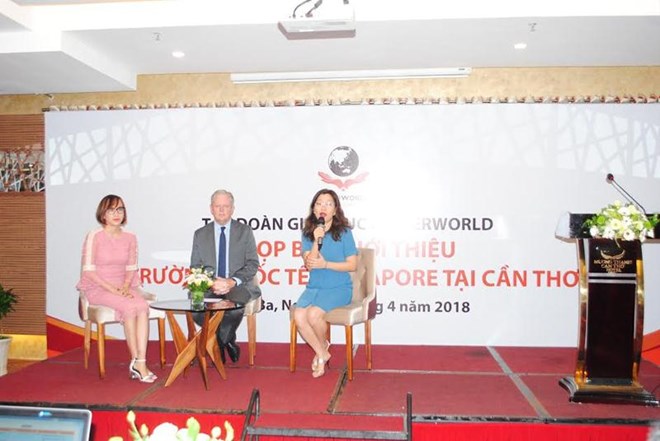 At the press conference Singapore’s KinderWorld Education Group and agencies of the Mekong Delta city of Can Tho held a meeting on April 17 to discuss activities of the Singapore International School based in the city for 2018-2019. It is the first KinderWorld international school in the Mekong Delta. The school sprawls across 2.6ha in An Binh ward, Ninh Kieu district and is capable of hosting nearly 1,300 pupils from preschool to pre-university levels at a total cost of nearly 200 billion VND (8.88 million USD). The first stage of construction is underway on a site of about 1.4ha with 19 classrooms, a multi-functional hall and a playground and greenery that could serve about 450 pupils. The school will enroll students in bilingual courses for pre-school, elementary and secondary levels for 2018-2019. In the future, pre-university and international courses will be launched. Speaking at the event, Vice Chairman of the municipal People’s Committee Truong Quang Hoai Nam said cooperation between Can Tho and KinderWorld will contribute to improve education quality in the Mekong Delta and Can Tho. Gifts presented to children with cleft lip, palate
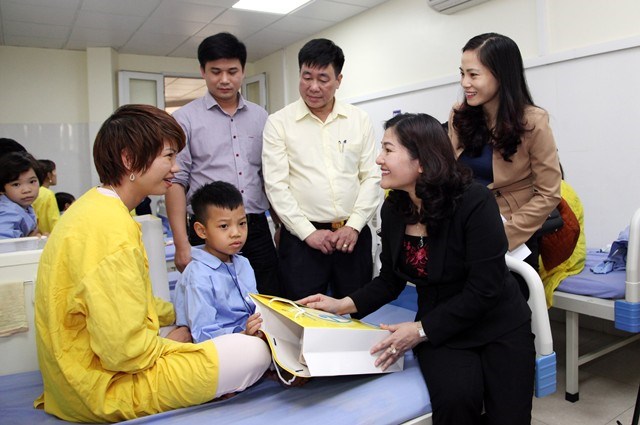 Deputy Minister of Labour, Invalids and Social Affairs Nguyen Thi Ha visits and presents gift to a patient (Source: laodongxahoi.net) Deputy Minister of Labour, Invalids and Social Affairs Nguyen Thi Ha visited and presented gifts to children who are receiving treatment for cleft lip, cleft palate and odontogenic cysts at the National Hospital of Odonto – Stomatology in Hanoi on April 17. Gifts worth 500,000 VND (22 USD) each were granted to 58 children from Hanoi and the northern provinces of Phu Tho, Bac Kan, Lao Cai and Dien Bien, who received surgeries funded by Operation Smile Vietnam – a nonprofit medical service organisation. Some 2,000 babies are born with cleft lip and cleft palate every year in Vietnam. Since 1994, the National Fund for Vietnamese Children (NFVC) has run Operation Smile to provide cleft lip and cleft palate surgeries for children. To date, nearly 30,000 children have benefited from the programme. The NFVC has also mobilised resources to provide post-surgery assistance for children, thus helping them practice pronunciation and integrate into the community. Sales at HCM City tourism festival exceed VND83 billion
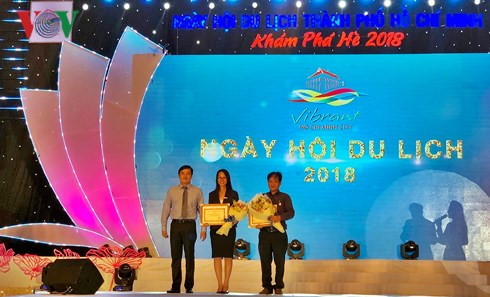 Businesses participating in the Ho Chi Minh City tourism festival carried out sales in excess of VND83 billion, a year-on-year rise of 38%, according to preliminary reports from travel businesses. The four-day festival wrapped up on April 15, drawing 320,000 visitors, more than 9,000 of whom booked tours with participating businesses. In addition to special tourism promotion programs and a ceremony recognising the top tourism brands of 2017, the festival included art performances, a singing festival, a forum on online tourism trends, a ceremony to announce a tourism innovation startup contest for 2018, and a conference reviewing the ‘HCM City-Binh Thuan-Lan Dong” tourism development triangle program. At the closing ceremony, Bui Ta Hoang Vu, director of the HCM City Department of Tourism, said the large-scale professional pavilions at the festival demonstrate the impressive growth of municipal tourism businesses and the close cooperation on tourism between HCM City and other localities. The festival provided an excellent opportunity for provinces and cities, as well as businesses, to show off their latest products, said Mr Vu. VNN |
↧
Article 2
Mobile payment market heats up with foreign players Two of China’s biggest e-wallets have joined the mobile payment market in Vietnam.
 There are 20 e-wallet service providers There are now about 20 e-wallet service providers in Vietnam, including well-known names such as Momo, Ngan Luong, VTC Pay and Payoo However, there is no official report from the State Bank about the number of Vietnamese e-wallet users. The agency said 3 million wallets had been issued in Vietnam by the end of September 2016. Service providers estimate that 10 million wallets are in use in Vietnam. Analysts say this is a modest figure compared with the great potential of the market. But they say the market will heat up soon as the two Chinese players have arrived. After the visit of Alibaba’s owner Jack Ma to Vietnam in late 2017, the Chinese group signed a strategic cooperation contract with Vietnam’s NAPAS to bring Alipay e-wallet to Vietnam. With cooperation among NAPAS, banks and Alipy, sellers in Vietnam will accept payment in Alipay wallet made by Chinese visitors for goods and services in Vietnam.
Sources said that the service will be launched this year. WeChat Pay has announced a plan with Vietnam’s VIMO e-wallet which will accept payment of Chinese travelers. VIMO.vn will be the first payment intermediary allowing Chinese travelers to use WeChat Pay in Vietnam dong at shops accepting VIMO in Vietnam. The cooperation does not include WeChat Pay's use of VIMO's banking connections to process payment transactions between Vietnamese consumers and businesses. Thirty percent of total foreign visitors in Vietnam in 2017 were Chinese. Current laws do not allow foreign e-wallets to operate in Vietnam independently. They can only be resent in the market through cooperation with Vietnamese companies. An analyst said that Alipay doesn’t compete directly with Vietnamese e-wallets, but it could be a potential threat. He went on to say that in the future the licensing policy may change and Vietnam will open its doors widely to foreign e-wallets that will provide services to Vietnamese customers as well. Banking experts said there are favorable for mobile payments to develop: the retail market and e-commerce are thriving, while bank cards and smartphones are more popular. According to the State Bank of Vietnam, the number of cash payment transactions decreased from 14.02 percent in 2010 to 11.45 percent in August 2017. The presence of fintech firms has also helped the mobile payment market. More than 30 fintech firms were established in Vietnam as of 2016, two-thirds of which provide mobile payment services. Kim Chi, VNN |
↧
Article 1
Government News 19/4 Adjustments to Thanh Thuy International Border Gate approved
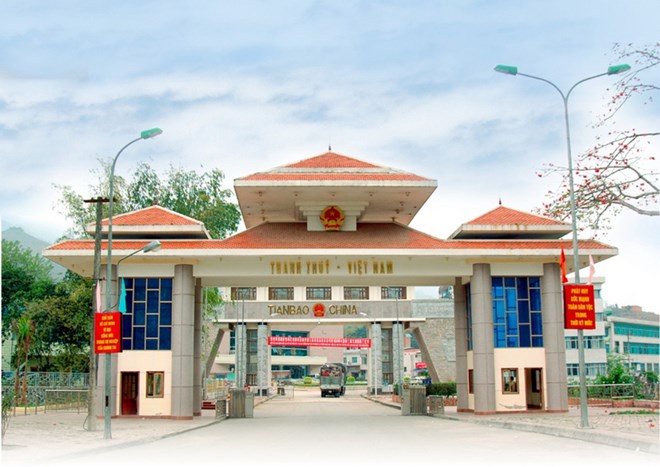 Thanh Thuy International Border Gate The PM has approved the adjustments to Thanh Thuy International Border Gate overall plan in the northern province of Ha Giang till 2030. According to the plan, the border gate will be formed into an integrated and multi-disciplinary economic zone in fields of trade, services, tourism, industry, agriculture and forestry to attract more investment and enhance international integration. The border gate aims to boost trade activities, exports and imports between Yunnan Province (China) and provinces in the North of Viet Nam and between ASEAN nations and countries in the Northeast Asia. The border gate will be developed sustainably, attached socio-economic development with ensuring security and defense for sustainable ecological environment. The total import-export revenue through the Thanh Thuy International Border Gate reached a record high of US$3.66 billion in 2017, soaring 200% from the previous year. Working group on implementation of Law on Planning set up
 The PM has decided to establish a working group on the implementation of the Law on Planning. Accordingly, Minister of Planning and Investment Nguyen Chi Dung heads the working group and Deputy Minister of Planning and Investment Le Quang Manh is his deputy. The working group is tasked to consult the PM to direct the realization of the Law on Planning and measures at Resolution No. 11/NQ-CP on the implementation of the Law on Planning. It also urges, coordinates and directs ministries, ministerial agencies and the People’s Committees of cities and provinces to launch the Law on Planning and tackle obstacles and difficulties during the process of realizing the Law. VN, Myanmar step up comprehensive cooperative partnership Myanmar State Counsellor Aung San Suu Kyi’s upcoming visit to Viet Nam from April 19-20 is expected to strengthen bilateral ties and tighten the two nations’ comprehensive cooperative partnership. The first official visit to Viet Nam by Myanmar’s Minister of Foreign Affairs and Minister of the President’s Office Aung San Suu Kyi is made at the invitation of Vietnamese PM Nguyen Xuan Phuc. Viet Nam and Myanmar set up diplomatic relations in 1975. The two nations elevated their ties to a comprehensive cooperative partnership during a State visit to Myanmar by Party General Secretary Nguyen Phu Trong in August 2017. The two sides have supported each other at sub-regional, regional and international forums such as the United Nations, ASEAN, Cambodia-Laos-Myanmar-Viet Nam cooperation, Ayeyawady-Chao Phraya-Mekong Economic Cooperation Strategy (ACMECS) and the Greater Mekong Sub-region. Economic, trade and investment ties have been maintained 12 prioritized areas, including agriculture, fisheries, finance-banking, aviation, telecommunications, oil and gas exploration and exploitation, mining, power device production and automobile manufacturing and assembly, construction, investment and trade. The two-way trade value hit US$828.3 million in 2017, up 51% from 2016. Viet Nam is the 7th biggest foreign investor in Myanmar with 70 projects worth nearly US$2 billion. Viet Nam had nearly 170 trade representatives in Myanmar in forms of representative offices, company’s branches, joint-stock companies and companies with 100% capital invested by Viet Nam. The two countries have regularly held meetings of the joint committee on bilateral cooperation and the joint sub-committee on trade. Trade fairs have also been held in each country to introduce products and attract investors. Based on a defense cooperation agreement signed in 2011, the two armies have sped up all-level delegation exchanges and boosted cooperation in border management, and illegal migration and smuggling prevention. Support industry needs push: Deputy PM The Ministry of Industry and Trade and Samsung Electronics Việt Nam jointly organised a programme to train 200 Vietnamese experts to meet the demand of firms in the country’s support industry. Developing the support industry has been one of the most important tasks to restructure the economy in depth, thus improving Việt Nam’s competitiveness and integration ability. Deputy Prime Minister Trịnh Đình Dũng told this at the launch ceremony of a programme to train 200 Vietnamese experts, held in Hà Nội on Tuesday. The training of these experts is to meet the demand of firms in the country’s support industry. The programme is jointly organised by the Vietnamese Ministry of Industry and Trade and Samsung Electronics Việt Nam. Addressing the ceremony, Dũng affirmed that South Korea had been one of the top economic partners of Việt Nam, while the latter has also been one of the major partners of South Korean firms. More and more South Korean businesses are operating in Việt Nam, making important contributions to the country’s economic development, he said. He added that currently, some 150,000 Vietnamese people are living in South Korea, a strong force that helps foster the Việt Nam-South Korea partnership. Việt Nam is on its way to industrialisation and modernisation, Dũng said, adding that the country is focusing on three strategic breakthroughs: completing the socialist-oriented market economy institution, developing a synchronous infrastructure system and transforming the growth model to improve the economy’s competitiveness. Việt Nam needs to boost the growth of the support industry, especially in electronics, mechanical manufacturing, automobile, footwear and garments. Therefore, the country has always created optimal conditions in policy as well as a favourable legal corridor for this industry’s expansion, Dũng said. He, however, pointed out the poor capacity of Vietnamese firms and their weak connectivity while stressing the vitality of investing more on human resources. He hoped that the training programme would contribute greatly to the expansion of Việt Nam’s support industry. Dũng asked the ministry to support Samsung in dealing with any problem that arises for the highest efficiency of the programme. Meanwhile, Shim Won Hwan, general director of Samsung Việt Nam, said human resources training for enterprises was the shortest way for Việt Nam to improve competitiveness in future. This year, Samsung plans to give consultations to 12 Vietnamese firms attending the programme, he said, adding that sending Samsung experts to Vietnamese firms will be a good way to boost the support industry’s growth. He said the launch of the programme marked a new milestone between the Vietnamese Government and the company. After graduating, the 200 experts trained under the programme will be sent to work for Vietnamese firms across the country. Minister of Industry and Trade Trần Tuấn Anh hailed the significance of the programme and said its success would help enhance the capacity of Vietnamese firms, strengthening their competitiveness and opening up new opportunities for them to engage in supply chains of multinational groups, including Samsung. VNN |
↧
Article 0
BUSINESS IN BRIEF 19/4 Mining Vietnam 2018 kicks off in Hanoi The fourth International Mining and Minerals Recovery Exhibition for Vietnam (Mining Vietnam 2018) kicked off in Hanoi on April 18. Co-organised by the UBM Asia company and the Vietnam Chamber of Commerce and Industry’s Vietnam Exhibition Services Company Ltd, the biennial event took place for the first time in 2012 and has become a bridge connecting domestic and foreign firms and diversifying advanced technologies and equipment. The three-day exhibition attracts more than 137 enterprises from 18 countries and territories, including the UK, Czech Republic, Germany, Singapore, China and Australia. They displayed equipment, machinery and technologies used for mining on a site of 4,000 sq.m. Apart from well-known names such as Volvo, PET, Tamiha, Tsurumi, Vinza, YHI, Weir Minerals, the Vietnam National Coal and Mining Industries Corporation (Vinacomin) also joins the event. Tran Tu Ba, Director of the Vinacomin Institute of Science and Technology, said Vinacomin is willing to work with partners to bring technological advances used in mining to Vietnam. During the event, three seminars will gather prestigious speakers to discuss breakthroughs and sustainability of mining, progresses in mining and underground works, and use of modern technology in mining and management. They will also talk about restoration of mineral resources and environment protection. Asia Miner, one of Australia’s well-known magazines specialising in mining and exploitation of mineral resources, will be also present. It will continue partnering with Vietnam in the Regional Technical Conference Vietnam 2018 with speakers from major foreign firms taking part. Participants will also discuss measures to improve mining output and safety standards in the field. Ho Chi Minh City bolsters tourism ties with Binh Thuan, Lam Dong Around 50 percent of tourism projects in the south central province of Binh Thuan and the Central Highlands province of Lam Dong are invested by businesses from Ho Chi Minh City. At a conference reviewing the four-year partnership between HCM City, Binh Thuan and Lam Dong on April 15, the Department of Culture, Sport and Tourism of Binh Thuan reported that 239 tourism projects in the province (62 percent) are run by investors from HCM City. The figure reported by Lam Dong was 100 (44 percent). Under their partnership, the three localities have regularly exchange experience in State management of tourism and jointly hold events annually for their travel agencies. Director of HCM City Department of Tourism Bui Ta Hoang Vu said the outcomes of the partnership proved that connectivity help the partners better tap their own potential and advantages. From a business perspective, Nguyen Van My of Lua Viet company said the tourism brand of the three localities is weak, adding that for the connectivity to produce desired result, each locality should develop its own strength, which are then combined to create unique products able to compete with other regions. Deputy Director of Lam Dong province’s Department of Culture, Sport and Tourism Nguyen Thi Bich Ngoc proposed building a joint tourism development plan with specific mechanisms designed to support local tourism firms, thus making the partnership more strong and effective. The tourism sectors of the three localities pledged to push forward with the trilateral cooperation. They will take measures to improve joint promotion activities and build a joint brand along with a tourism app for the three localities as a whole.- 54 excellent estate businesses, projects honoured A total of 54 businesses and projects were honoured with the Vietnam Property Awards 2018 in Hanoi on April 14 in recognition of their significant contributions to the development of the real estate market in Vietnam. The awards were launched by the Vietnam Real Estate Association (VNREA), the Management Agency for Housing and Real Estate Market under the Ministry of Construction and the VTV24 news centre. Speaking at the award ceremony, Deputy Prime Minister Trinh Dinh Dung said after a period of decline, the real estate market has recovered and developed strongly with high liquidity and reasonable structure, helping modernise urban areas. Particularly, the increasing areas of social housing projects have created accommodations for nearly 500,000 low-income people and workers at industrial parks, he said. The awards encouraged domestic businesses to enhance corporate social responsibility, competitiveness and develop trademark to meet international standards, he added. To ensure sustainable and healthy development, it is necessary to improve relevant institutions, revise and supplement terms of the laws on construction, housing, and real estate business, and build a law on urban management and development to create a legal corridor and favourable environment for property investment and development, Dung said. Planning schemes on urban development should be revised to avoid spontaneous investment, he said, adding that the development of social housing projects is needed to ensure all people could afford safe and quality accommodation. According to VNREA President Nguyen Tran Nam, after four months of launching, hundreds of businesses registered to join the competition - which was divided into eight categories, including prestigious real estate developer (11 awards), best urban area (6 awards), best resort development (5 awards), best office building for rent and shopping mall (3 awards), best residential area (10 awards), best green building (6 awards), best real estate transaction floor (7 awards) and best social housing project (6 awards). Vingroup, Sun Group, and FLC Group were among the winners of the prestigious real estate developer awards, while the best urban projects were Ecopark, Phu My Hung (Ho Chi Minh City), Phu Long – Dragon City (HCM City), Ciputra – Udic (Hanoi), Lakeview City (HCM City), and Vinhomes Riverside (Hanoi). The best resort development awards went to FLC Quy Nhon Beach & Golf Resort (Binh Dinh province), Premier Village Da Nang Resort, Novotel Phu Quoc Resort-Novotel Villas (Kien Giang province), Silk Path Sa Pa Resort & Spa (Lao Cai province), and Flamingo Dai Lai Resort (Vinh Phuc province). The Eurowindow Office Building and Vincom Centre in Hanoi and HCM City-based Cantavil Premier won the best office building for rent and shopping mall awards. In 2017, the real estate market in Vietnam saw positive changes in all segments. In the capital city of Hanoi and the southern economic hub of Ho Chi Minh City alone, there were 64,263 successful deals. A range of new products such as condotel, officetel and hometel were developed, making the real estate market in the Southeast Asian country more attractive. Labour productivity enhancement – key to economic growth
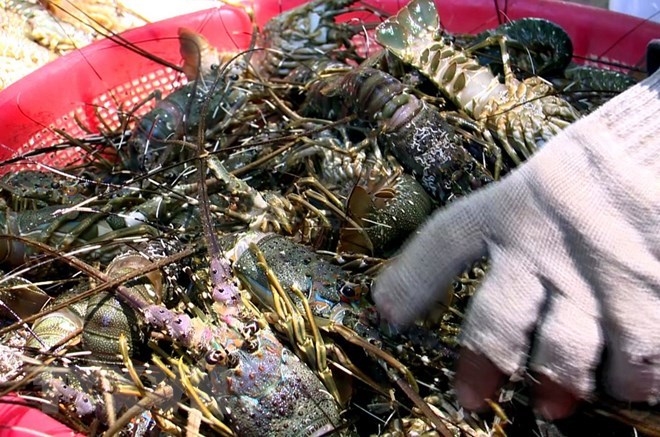 Vietnam’s labour productivity is very low compared with growth need, thus raising productivity is the key to economic growth, experts said at a conference on April 13. According to Ngo Van Tuan, deputy director of the Party Central Committee’s Economic Commission, the country’s productivity increased by an average 4.7 percent a year during 2011-2017, while the GDP growth was about 6.21 percent and real wage rose by an average 12.59 percent. “This means production costs in Vietnam is becoming more expensive, which directly affects the country’s competitiveness,” Tuan told the CEO forum 2018 held by the Vietnam Economic Times. The General Statistics Office (GSO) reported that local productivity has been increasing throughout recent year, but remains lower than regional levels. By purchasing power parity in 2012, Vietnam’s productivity in 2016 reached 9,894 USD in 2016, equal to only 7 percent of Singapore’s, 17.6 percent of Malaysia’s and 36.5 percent of Thailand’s. The gap is still expanding, GSO Director General Nguyen Bich Lam said, attributing it to the slow restructuring process of the economy, with the high proportion of the workforce working in the agricultural sector where the labour productivity is low. The prevalence of outdated machinery, equipment and technology in the economy is another cause, he said, noting that most domestic firms, particularly private ones, use technology that are two or three generations backward compared to the world’s average. Furthermore, the capacity of resource management and use is low, as is business administration capacity, according to Lam. He urged the Government and sectors to make raising labour productivity a leading task to improve the national economy’s competitiveness and sustainable growth. The Government should set up a national labour productivity committee to coordinate efforts to enhance productivity, and develop a national strategy to help the country catch up with regional countries in terms of productivity. Deputy director of the Party Central Committee’s Economic Commission Tran Van Tuan was of the opinion that the most effective solution to enhance productivity is to attract FDI into industrial production and services of higher value. He said the country needs a new strategy and new directions in attracting FDI, in order to allow the FDI sector to play a greater role in technology transfer. A representative from Deloitte Vietnam Ha Thu Thanh said as the human factor is the first to affect labour productivity, the country needs a human-based approach to productivity enhancement. URC sales plunged after notorious lead scandal Filipino firm Universal Robina Corporation experienced weak sales in Vietnam in 2017, following a major food safety scandal resulting in recalls, which forced the company to change its product’s look in March. According to the latest Universal Robina Corporation (URC) report, it incurred a 21.1 per cent drop in net income in 2017. “Profitability remained weak as the company faced a decline in volumes and a change in its product mix, particularly relating to the coffee category in the Philippines, as well as a slower-than-expected recovery in Vietnam,” URC said. URC, the food and beverages unit of the Gokongwei group of companies, is focusing on strengthening its business and hopes to recover its share of Vietnam’s beverage market by 2020. URC consists of three main divisions, namely snack foods, beverages, and grocery products. The group manufactures and distributes a diverse mix of salty snacks, chocolate, candy, biscuits, baked goods, beverages, noodles, and tomato-based products in the Philippines and throughout Asia. Its green tea beverage C2 and ready-to-drink energy drink Rong Do are popular in Vietnam. The company faced a price war in the Philippines involving its coffee and salty snack businesses, while its two flagship beverage brands, C2 and Rong Do, were recalled in Vietnam for exceeding the limit for lead content in 2016. The Vietnamese Ministry of Health announced the imposition of a fine of more than VND5.8 billion ($260,000) for producing and selling lead-contaminated products. According to the ministry, a batch of C2 manufactured on February 4, 2016 and a batch of Rong Do made on November 10, 2015 were found to contain high levels of lead. Test results showed these batches had a lead content of 0.053 to 0.085 milligrams (mg) per litre, definitively above the acceptable limit of 0.05 mg per litre. The lead contamination scandal has damaged the reputation of the company and consumers remain wary of its products. In order to recover its sales, URC launched a new look for C2 in mid-March stating in a document that the beverage “still keeps to its unique brewing process where it’s brewed and bottled on the same day, ensuring a fresh and authentic drinking experience”, while also focusing on the product’s base of green tea leaves. Asked about the company’s future strategies for Vietnam’s market, no URC representative was available for comment. According to Euromonitor International, a leading provider of strategic market research, in 2016, the ready-to-drink tea market recorded declines in both on-trade and off-trade volume and value terms, as both of its leading players, Tan Hiep Phat Group and URC Vietnam, were involved in scandals which affected their reputations and sales. In 2017, as the scandals died down, the segment rebounded, although growth was not as strong as it had been prior to the scandals. In recent years, Vietnamese customers have become increasingly aware of health and wellness products due to higher rates of diabetes, high blood pressure, and cancer. For this reason, there has been a perceptible shift in preference towards more nutritious drinks with less sugar and caffeine. With higher disposable incomes, many consumers have become more willing to pay extra for healthier products. VSC-Posco turns to government in land use quagmire One of the leading foreign steel makers in Vietnam, VSC-Posco Steel Corporation, recently filed a complaint with the government concerning the irrational issuance of a land use right certificate by municipal authorities relating to its steel rolling mill project in Haiphong city. VSC-Posco Steel is a joint venture established by four investors including Posco and Posco Processing & Service Co. Ltd. Among the four, Haiphong Steel and Mechanical Building Material JSC (Hascom), under a prime ministerial decision, was allowed to rent 60,094 sq.m to contribute capital to the company. In a document sent to the Government Office and Haiphong’s relevant authorities, Posco Vietnam Holdings claimed that the Haiphong People’s Committee failed to issue the land use right certificate of the land for the joint venture. “Despite our contacting with the relevant competent authorities, we have not been issued the land use right certificate of the land for fully implementing our legitimate rights. The construction works and assets attached to the land were established long time ago, but have not been duly recorded.” VSC-Posco claimed it recently discovered by chance that Hascom had secretly applied for a land use right certificate for the land without consulting the joint venture. Besides, on July 11, 2016, the Haiphong People’s Committee issued a decision allowing Hascom to extend the lease for the land. “Unfortunately the certificate was issued in the name of Hascom, while this land use right has been contributed by Hascom to the joint venture,” VSC-Posco stated in its complaint. “The land lease extension and issuance of land use right certificate to Hascom instead of VSC-Posco Steel Corporation is contrary to directives of the prime minister and the laws of land, enterprises and investment.” According to VIR’s sources, the final government decision could be released this month and published on the government’s website. The VSC-Posco Steel Corporation’s $56 million plant in Haiphong began commercial operation in 2015, with a capacity of 240,000 tonnes per year. Ever since its establishment, the joint venture’s output and revenue have been on a steady trajectory of growth, from 13,000 tonnes and VND47.9 billion ($2.2 million) in 1995, to 3.5 million tonnes and VND2 trillion ($94 million) in 2014, respectively. Moody’s affirms Vinacomin’s B3 rating amid slower coal export Moody’s Investors Service has affirmed the B3 corporate family rating for state-owned Vinacomin Holding Corporation Limited, with its outlook remaining stable, on the back of slower coal exports. “Vinacomin’s B3 rating is primarily driven by its standalone credit quality as captured by its b3 baseline credit assessment, which in turn continues to reflect its strategic importance in managing Vietnam’s coal and mineral reserves, and its demonstrated access to low-cost credit from the local banking sector to support its expansion projects,” said Moody’s lead analyst for Vinacomin, Maisam Hasnain. The company has a long-dated reserve life with substantial reported coal reserves (over two billion tonnes). This translates into a reserve life of over 50 years based on its 2018 expected production of 36 million tonnes. Accounting for about 70 per cent of its revenue, coal sales will remain the primary contributor to Vinacomin’s operations. Vinacomin, however, may have to face a narrow coal export market as Vietnamese coal products do not meet the requirements of importing countries. China has recently requested to reappraise the quality of the coal imported from Vietnam to align with standards on trace elements. Vinacomin ealier on collaborated with its Chinese partners to take and analyse samples of coal to conclude that Vietnamese coal products did not meet the requirements, leaving 2.5 million tonnes of dust coal unmarketable in Vang Danh-Uong Bi. China started to reduce Vietnamese coal imports a while ago now. According to data from Vietnam Customs, coal exports were kept at a reasonably high level in 2010-2014, but sharply declined since 2015. In 2010, China bought 14.644 million out of the 19.827 million tonnes of coal exported by Vietnam. By 2014, coal exports to this market decreased to 4.139 million tonnes. In 2015, Vietnam Customs did not record any coal exported to China. In 2016 and 2017, the agency recorded only several thousand tonnes. China is known to not accept low-quality coal imports anymore. As a result, Vietnam’s coal inventory raised to 8.75 million tonnes in 2015, 9.42 million tonnes in 2016, and over nine million in 2017. The volume of Vietnam's coal export in 2017 only met 50 per cent of the set goal. Last year, the country exported 2.229 million tonnes of coal, way below the target of four million tonnes. Moody’s opinion of Vinacomin’s ablility to meet all of its financial obligations (B3 rating), meanwhile, recognises key challenges including Vinacomin’s large debt-funded capex programme; the standard, quality, and timeliness of its consolidated financial reporting; its dependence on short-term bank funding; and the limited degree of clarity regarding long-term shareholder intentions and strategic direction. “The rating is constrained by Vinacomin’s large capex plans which will keep its adjusted leverage—as measured by adjusted debt to EBITDA—elevated at around 5.5-6.0x, and its high dependence on short-term debt to fund its operations,” noted Hasnain. “However, based on its status as a state-owned enterprise, Vinacomin has built long-standing relationships with banks and financial institutions in Vietnam and has a track record of successfully rolling over its short-term bank loans,” added Hasnain. While Vinacomin is 100 per cent owned by the Vietnamese government (B1 positive), Moody’s believes that the government is unlikely to provide more than selective and partial support in a distress situation, and Vinacomin’s rating therefore does not include any uplift for expected government support. The stable outlook reflects Moody’s expectation that the company’s leverage will remain elevated but within its rating parameters while it works to improve its cost competitiveness amid increasing coal imports in Vietnam. The outlook also takes into account Vinacomin’s proven access to state-owned banks and the domestic bond market as it carries out its capital investment plans. International know-how to help local fruit exports Vietnam has gained a licence to export fresh rambutan to the fastidious market of New Zealand. For more export success, local fresh fruit producers and farmers must leverage international know-how to enhance their produce quality in order to meet global standards. Some ten years ago, a New Zealander living in a provincial town would hardly have known what dragon fruit tasted like, let alone other exotic fruits like rambutan. Yet now, dragon fruit imported from Vietnam has become exceedingly popular at provincial supermarkets in New Zealand, according to Emmet McElhatton, commercial manager of the New Zealand Government-to-Government Partnerships Office (G2G Know-How). McElhatton said that the tropical fruit market in New Zealand is rapidly growing, thanks to the exposure to new flavours that Kiwi travellers have gained after their visits to tropical destinations. “[Our] supermarkets are more willing now to stock different products and consumers are really demanding variety,” McElhatton said. For Vietnamese fruit exporters, the commercial manager stressed that it is important to “get the flavour profile right for all consumers” when looking to export their fresh produce to New Zealand. “It is important to have a product that they can easily consume without too much fuss. Think about a banana. A banana is the ultimate consumer product that comes in its own packaging, with beautiful flavour, in different sizes, and is very easy to consume,” McElhatton told VIR on the sidelines of a New Zealand-Vietnam Rambutan Trade and Opportunities event for bilateral horticulture co-operation, held in Hanoi on April 10. “I think the diverse Asian population in New Zealand—up to 15 per cent of the population, with some parts of Auckland being 20-30 per cent Asian, for example—is driving demand for these products,” he added. To date, three local tropical fruit have been granted market access to New Zealand: mango in 2011, dragon fruit in 2014, and rambutan that was recently permitted to cross New Zealand’s borders. In fact, Vietnam is the very first nation to export fresh rambutan to New Zealand, according to New Zealand’s Ministry of Primary Industries. Being able to export fruit to New Zealand, meanwhile, means much to Vietnam. If it can make it into one of the pickiest markets in the world, it can make it to anywhere else, according to Deputy Minister of Agriculture and Rural Development Le Quoc Doanh. Doanh noted that in 2017, Vietnam exported a record $3.5 billion worth of fresh fruits. In the first quarter of this year, the country reported $934 million in fresh fruit exports, an up of 33 per cent compared to the same quarter in 2017. The shipments of local rambutan are expected to reach New Zealand’s shores in the next few months, upon completion of price negotiations and shipment arrangements between local exporters and their New Zealand partners, according to the Ministry of Agriculture and Rural Development. The fruit will then join its compatriots of dragon fruit and mango on the shelves of Kiwi supermarkets, where demand for tropical produce is on the rise. Apart from the trio, more Vietnamese fruits have high hopes to make their move to satisfy the taste buds of not only New Zealand, but many other nations. This hinges on whether local fruit producers and farmers pay due attention to the flavour profile and, above all, the investment that is needed to help them move on from traditional farming to more advanced varieties, in a bid to meet international standards and demand for fresh produce. Whilst more investment is definitely needed in the agricultural sector to help switch from traditional farming to more modern approaches, it is essential to note that local agricultural businesses or organisations should be prepared to pay premium for global expertise or consultancy services, which can bring benefits for themselves and the sector as a whole. For years, Vietnamese fresh produce has struggled to meet international standards for exports in terms of quality and quarantine treatment. Given the aid of international know-how, high-technology, and innovation, this could change. “What we have noticed is that a lot of Vietnamese investors are quite comfortable buying equipment and technology, but [when it comes to] the human input (knowledge, intellectual property, and expertise), they are less willing to pay premium. I think this really is the key thing that needs to change,” said McElhatton of New Zealand G2G Know-How. “Because once you have partnered up with them and access high-quality international expertise at a proper rate, you benefit from that, everybody benefits from that,” he added. “New Zealand is one of the most efficient agricultural economies in the world, with a reputation for producing cutting-edge research and technology, robust and safe agricultural practices, and delicious and high-quality products.” New Zealand’s world-class agriculture expertise is already making a practical difference in Vietnam by improving farmer income and food safety. Agriculture is one of four priorities for the New Zealand Aid Programme in Vietnam, along with education, disaster risk management, and renewable energy. Vietnam has officially become one of the first nations to export fresh rambutan to New Zealand, with the first shipments of the fruit to be ... Haiphong to step up infrastructure Haiphong is giving priority to mobilising resources to develop modern and synchronous transportation infrastructure, with the aim of promoting its central role as the main sea trade gateway of the economic corridor in the northern region. Infrastructure acts as a key element leveraging traffic connections and comprehensive development co-operation between Haiphong and three other localities of the economic corridor, namely Lang Son, Hanoi, and Quang Ninh. The spotlight of Haiphong’s traffic linkages comes from three completed infrastructure projects that are now in use: Hanoi-Haiphong Expressway, Tan Vu-Lach Huyen Highway, and Dinh Vu-Cat Hai Bridge. These projects facilitate the connection to Hanoi-Lao Cai Expressway, shortening the travel time between the northern province of Lao Cai and Haiphong International Gateway Port (HIGP) to some six hours. Haiphong’s port area is a key driver of the development co-operation of the five localities that make up the Vietnam-China economic corridor: Lao Cai, Hanoi, Haiphong, Quang Ninh, and Yunnan (China). The Haiphong port area works as both the main sea trade gateway of northern localities of Vietnam and the closest sea route to the Chinese province of Yunnan. With its 42 terminals with a combined length of over 10.7km, the HIGP is capable of receiving 100,000 deadweight tonnage (DWT) vessels. Located in Lach Huyen district, HIGP, which is one of the country’s most crucial deep-water ports, is under rapid construction and is expected to be put into service on May 12. Under a master plan for the seaport development of the HIGP, the HIGP plans to have nine terminals of 3,000m by 2025, including six container terminals and three multi-purpose ones. It will be home to 23 terminals of 7,750m by 2030, capable of handling 118 million tonnes of goods per year. Haiphong pledges to mobilise resources to speed up the construction of the HIGP Industrial Zone (also known as Deep C III). Meanwhile, the city continues to invest in upgrading the transport infrastructure connecting Cat Hai island and Road No.356, backbone roads and dykes in the south of Dinh Vu Industrial Zone and Tan Vu-Lach Huyen 2 Bridge, and the projected wharves of HIGP. In addition to its advantage of seaport services, Haiphong is home to Cat Bi International Airport, which has been upgraded and fully qualified to receive aircraft in accordance with International Civil Aviation Organization (ICAO) standards with varied domestic flights and international routes to South Korea, Thailand, and other countries. It can be said that the local business climate has been improved, with FDI inflows of nearly $1 billion in 2017 and the presence of many large local and foreign corporations. They include the Vinfast automobile manufacturing factory project with a total investment value of over $1.5 billion in the Dinh Vu-Cat Hai economic zone, an eco-tourism and recreational resort project on Cat Ba Island valued at $3 billion, and Japan’s AEON Mall with a total investment value of $200 million. More information about these developments in Haiphong is offered at Haiphong Investment Seminar held in HoChi Minh City on April 23-24. For registration and details, please contact the organiser at huy.vu@dinhvu.com Located at the heart of the above-mentioned key projects, the DEEP C Industrial Zones (DEEP C) is taking the opportunity to become a reliable destination for investors. DEEP C is regarded as the first and possibly the only industrial park in the northern region to successfully develop an industrial zone on the sea from millions of cubic meters of sand. DEEP C has so far called for a combined investment of nearly $3 billion and 72 projects from Japan, Germany, the US, Singapore, South Korea, and Vietnam. These projects are invested by big names, including Bridgestone, JX Nippon Oil and Energy, Idemitsu, Shin-etsu, Chevron, IHI, Nippon Express, Yusen, Knauf, C. Steinweg, Flat Group, and PVOil. Investors come from various industries, including supporting industries, automobiles, logistics, light industries, and others. Investors highly value DEEP C as one of the most successful industrial parks in Haiphong and the country in general. The distinguishing feature of the DEEP C comes from a system of multipurpose zone located immediately adjacent to the new infrastructure development and reliable provision of utilities and services where tenants can enjoy the best tax incentives in the country. This makes the target of developing DEEP C into a world-class industrial zone coupled with seaport services feasible. “DEEP C will lead the way in implementing the initiative on building an eco-industrial zone toward sustainable growth. Besides, Deep C III is expected to serve as a reliable partner and destination for investors,” Frank Wouter, general director of Dinh Vu Industrial Zone JSC, said at the ground-breaking ceremony of Deep C III held last October. Vingroup acquires two mammoth projects from Berjaya Leading multi-functional conglomerate Vingroup has recently acquired two projects from Malaysian Berjaya Corporation which have been delayed for a long time. Vinhomes, Vietnam's leading real estate management company and the property management arm of Vingroup, has completed the purchase of 97.7 per cent stake in Berjaya Vietnam International University Township One Member LLC from Malaysia’s Berjaya Corporation. This VND11.75 trillion ($515.6 million) deal aims to acquire the long-delayed Vietnam International University Township (VIUT) project. BerjayaVietnam International University Township One Member LLC is the investor of the long-delayed VIUT project. The project, which received its investment certificate in July 2008, is located at Tan Thoi Nhi commune in Hoc Mon district. It has an area of 925 hectares and investment capital of $3.5 billion. According to its design, Berjaya would have set aside 100 hectares for a university. The township was to have 20 schools offering education from kindergarten to high school. The remaining 15-ha area was going to be a multi-purpose complex with a commercial area, residential area, administrative and cultural area, and a healthcare centre that would have operated in conjunction with the university, as well as a gym and a park. At the point of receiving the investment certificate in 2008, VIUT was the largest foreign direct investment project in Ho Chi Minh City. The city authorities pegged a lot of hope on the project, giving credit to Berjaya’s renown as a big real estate developer. After ten years, however, the project is still a field of grass and the Ho Chi Minh City People’s Committee requested the city's Department of Planning and Investment to either resolve the difficulties that the Malaysian company is having in implementing the project or revoke the investment certificate. The investor told VIR about a month ago that it plans to kick-off the construction of the project early this year, however, to date, the construction has been immobile—and has now been taken over by Vingroup. After the VUIT acquisition, Vinhomes also finished its capital contribution of more than VND2 trillion ($89 million) to Vietnam Berjaya Financial Centre this March, acquiring 67.5 per cent from the investing company of this project. Located in District 10 of Ho Chi Minh City, the $930-million Vietnam Financial Centre was proposed to have five 48-storey buildings with a total of 600,000sq.m of floor space. It has also been delayed for many years. The site is now used as a parking lot for nearby restaurants. Berjaya has a series of real estate projects that came along slowly after receiving their investment certificates. In 2013, the authorities of the southern province of Dong Nai revoked Berjaya’s investment certificate for Nhon Trach New Urban Area project because the company failed to start implementation. In addition, sales were lacklustre at the Bien Hoa City Square apartment complex in Dong Nai, and the Hanoi Garden City urban area in Hanoi. TPBank could issue convertible bonds to foreign investors As TPBank has virtually no room left for foreign investors, the bank is thinking of issuing convertible bonds to interested parties to whip up more capital. Bui Thi Thanh Huong, TPBank deputy general director, said at the bank’s pre-listing seminar held in Hanoi on April 12 that following its private placement of 15 per cent holding to investors, there is only 0.77 per cent left for foreign investors. Singapore-based SBI Ven Holdings Pte., Ltd. who has been holding 19.9 per cent of TPBank’s holdings for some 10 years, according to Huong, has acquired more shares through a private placement to maintain their current shareholding. Also, with IFC and PYN Fund Management who each secured 4.99 per cent, the room left for foreign investors is very small. As a temporary measure, TPBank could issue convertible bonds to foreign investors “We expect the government will lift the foreign ownership limit (FOL) in the banking sector in the future and should this come true, it will be a great opportunity for TPBank," Huong said. Given that quite a few foreign investors are currently interested in TPB, including a private fund from Saudi Arabia that manages billions of dollars in investment, Huong said that the bank could consider issuing convertible bonds for these investors. “Some have even asked us to issue convertible bonds as an option while waiting for the FOL to be lifted. We may well consider this option as it can provide us with more capital to support our development of technology, know-how, products, policies, and customers,” noted Huong. Hanoi-based TPBank (ticker: TPB), meanwhile, has scheduled April 19 as the date to list 555 million shares on the Ho Chi Minh City Stock Exchange (HSX) at the initial price of VND32,000 ($1.41). TPB’s market capitalisation, as a result, is expected to go up to VND17.76 trillion ($789.33 million), which can put the lender in the 8th spot among listed banks in terms of market capitalisation. “The liquidity of the stock market is rather good at present, and with Vietnam en route to be upgraded to Emerging Markets Status by MSCI as well as the incoming capital inflows, it is an opportunity for us right here. Also, as you can observe, banking stocks are taking the lead in the market and with our good performance in 2017, it is just the right time for us to get listed now,” said Do Anh Tu, vice chairman of TPBank, on the sidelines of the pre-listing seminar. Symposium to spur cooperation between Hwaseong city and Hanoi In the framework of the four-day Vietnam Industrial Tour 2018 starting on April 12, the Hwaseong City Women Entrepreneurs Association attended a symposium in Hanoi’s Sheraton Hotel with the participation of representatives from the Hanoi Women Entrepreneurs Association and the Hanoi Young Business Association. The symposium, hosted by Korean-backed Mirae N Limited, aims to lay the groundwork for a long-term and sustainable business cooperation between the parties as well as create a platform for women entrepreneurs in Korea’s Hwaseong city and Hanoi to present their businesses, exchange experience, and seek investment opportunities. According to Michelle Park, chairwoman of Hwaseong City Women Entrepreneurs Association (HWEA), the city (just one hour from Seoul’s city centre) is home to 30 major businesses and about 7,000-8,000 small and medium-sized businesses. It also hosts R&D centres and the production units of leading Korean industrial groups like Samsung Electronics and Hyundai (the Kia brand, particularly), leading to the presence of numerous satellite units producing components to supply these major players. “Coming to Vietnam this time, we seek to propel international exchange, helping member units increase business opportunities to avail themselves of their advantages and gain more experience to tackle weaknesses.” “I expect exchanges like today’s will help women entrepreneurs in both South Korea and Vietnam learn more useful things for their business. During this visit, we hope to establish relations with more Vietnamese companies to be able to boost exchanges in the upcoming time,” Park added. According to a study by leading management consultancy firm McKinsey, Hwaseong city has the potential to grow into one of the richest cities in the world by 2025 leveraging its industrial and IT strength. Park is also the CEO of Ecoco Limited which was founded in 2000 and is specialised in producing algae-preventing water treatment equipment using sunlight, water plant eliminating machines, and decanting devices. “Our company works in the field of water treatment. I think Vietnam has ample water resources, so environmental treatment might be a concern. If possible, we want to engage in technology transfer with the Vietnamese side or sell products to Vietnam.” “As Vietnam is rich in water resources, the country may have useful experience and technology in water treatment. After a survey, if we find the conditions suitable, we may import equipment or technology back to Korea,” Park told VIR. “Our products have been sold in many countries, including the US, and we are looking to open an agent here in Vietnam to commercialise our products,” she added. Min Ji Young, CEO of another HWEA member unit S Feel Princess Story operating in fashion accessories manufacturing and sales, said, “Our products have been on the shelves of major supermarkets across Korea, but we do not have stores abroad yet, so we decided to join the tour to Vietnam and expect further cooperation in the country.” “I see that many young Vietnamese people favour Korean products, particularly those of Korean stars.” S Feel Princess Story is named among leading Korean businesses certified by Korean authorised agencies in respect to brand development. Today’s meeting marks the start of our cooperation, and I am confident in our augmented ties in the coming time. “Today’s meeting marks the start of our cooperation, and I am confident in our augmented ties in the coming time,” said Dinh Thu Hoai, deputy chairwoman of Hanoi Women Entrepreneurs Association. "Many our members are fond of using Korean goods. Not only potential customers, we can act as your companies’ reliable partners in producing and distributing products in the Vietnamese market.” Founded in 1999, Hwaseong City Women Entrepreneurs Association consists of 52 members. 75 per cent of the members work in the manufacturing industry, 13 per cent in retail and wholesale, and the remaining 12 per cent in the services sector. TTC Sugar approves bond issue The Board of Directors at the Thanh Thanh Cong - Bien Hoa JSC (TTC Sugar, Stock Code: SBT), recently approved the issuance of 450 bonds worth $20 million. The bonds have a par value of around $44,000, are non-convertible, are not accompanied by warrants, are guaranteed for payment, and have a term of one year from the date of issue, maturing in 2019. They will be issued separately to fewer than 100 investors, including domestic and foreign professional investors that are organizations and individuals. The company prioritizes commercial banks, financial institutions, and investment funds via issuing agents. The bonds are projected to be divided into several issuances, with the first in the fourth quarter of fiscal year 2017-2018. The issued price is equal to the par value. The issuance aims to increase and replenish TTC Sugar’s working capital to expand and scale-up production and increase the efficiency of its operations, thereby optimizing production costs and promoting economies of scale. The incremental production capacity reduces fix costs and depreciation per kg of products, etc. The company can therefore boost consumption, expand market share, penetrate medium and small segments in market niches, and target markets such as the Mekong Delta and the north and the export market. Incremental production will simultaneously bring advantages to stimulate consumption and consolidate advantages in distribution to penetrate markets and targeted segments. Once the bonds are issued, capital structure ratios will remain safe and financial risks controlled to meet commercial banks’ requirements, of which the debt-to-equity ratio in consolidated financial statements will increase slightly, from 1.27 to 1.33 times. TTC Sugar has consistently adhered to financial controls and operations, particularly regarding debt ratios or leverage ratios in operations. The increase in the debt ratio helps improve the company’s profitability ratio. It has produced half of the 2017-2018 crop, or 3.1 million tons of sugarcane, representing 90 per cent of the plan. Its business results for 2017 were positive, with total consolidated assets at more than $783 million, including $314 million in consolidated equity, both up 129 per cent compared to those at the end of June last year. Sugar consumption was 308,579 tons, or 50 per cent of the annual plan. Total sales of goods and services stood at $240 million, or 60 per cent of the annual plan, while pre-tax profit was $14.3 million, or 50 per cent, for increases of 161 per cent and 70 per cent, respectively, year-on-year. After-tax profit was $11.4 million, up 49 per cent year-on-year, and the gross profit margin was 11 per cent. Production and operation in the 2017-2018 fiscal year saw many changes, as the corporation and outlets were restructuring and reorganizing after the M&A. Setting a challenging target of “1 million tons of sugar” by 2020, TTC Sugar is gradually implementing marketing and agricultural and manufacturing activities. VNN |
↧
↧
Article 3
Economy lacks capital, even as treasury deposits remain high While the state treasury has plenty of money, the national economy still thirsts for capital.
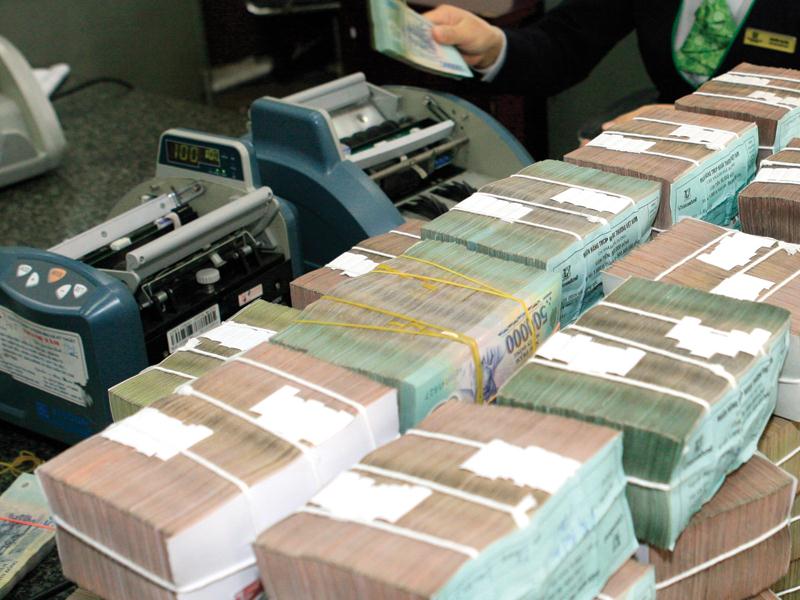 The government bond interest rate has dropped to a 10-year low, which is a worrying sign, according to deputy director of the State Bank’s Monetary Policy Department Nguyen Tu Anh, who spoke to Dau Tu. According to Anh, commercial banks are seeking medium- and long-term capital in the market at the interest rate of 6-7 percent per annum. They receive 3-4 percent per annum in interest rate when lending to the government. The interest rate decrease means a government bond price increase. Indonesia, which has the same sovereign credit rating as Vietnam, pays interest rate of 7 percent per annum for government bonds, which is double Vietnam’s. If counting the CDS (credit default swaps), the Vietnamese government bond interest rate is even lower than the US. The major buyers of government bonds are commercial banks, which means that low government bond interest rates are putting pressure on banks.
Banks generally like investing in short-term government bonds. However, government bond purchases at this time will take a loss. If the bond interest rate continues decreasing, banks will have several choices. First, bargain the bonds away. Second, raise the lending interest rate. Third, ease the deposit interest rate. The best solution for banks is to sell government bonds. A report of the Hanoi Stock Exchange confirmed that the value of government bond transactions in the last three months of the year increased sharply, especially repo ones. According to Le Xuan Nghia, an economist, the government bond interest rates have decreased because banks have abundant money. There are a number of reasons for this. Public investments have been stagnant. The capital mobilized in the years before through government bonds issuance is being kept at the treasury. This can be seen in the large amounts of treasury deposits at commercial banks, up to hundreds of trillions of dong. The equitization of state-owned enterprises has brought huge money to the state budget, and that money is also kept at commercial banks. The State Bank increased purchases of foreign currencies recently to strengthen forex reserves. The move has resulted in a huge amount of money pumped into circulation. Commercial banks have been told to lend no more than 80 percent of the total mobilized capital, which means that 20 percent of capital remains. The high volume of deposits has prompted banks to rush to buy government bonds. But the government bond supply is short because the government still has money that was mobilized in previous years. VNN |
↧
Article 2
BUSINESS IN BRIEF 20/4 Mercedes-Benz Viet Nam recalls 3,624 vehicles over faulty fuse
 Mercedes-Benz Viet Nam is recalling 3,624 vehicles that are at risk of catching fire due to a potentially faulty fuse. According to the German car maker, the list of recalled vehicles includes C200, C250, C300, E200, GLC 250 4MATIC and GLC 300 4MATIC models, manufactured between September 2015 and February 2017. The models will be checked and installed with an additional fuse in the electrical line to the starter at an estimated time of 30 minutes per car. The recall campaign is scheduled to begin on May 14, 2018, and end on September 9, 2020. Mercedes-Benz Viet Nam is also recalling another 384 vehicles (models E200, E250 and E300) manufactured from August 2016 to April 2017 to replace the seat belts on the left and right backseats. The duration of checking and repairing is estimated at one-and-a-half hours per vehicle. This recall campaign started on April 16, 2018, and will run till December 31, 2022. Top 500 firms with best growth and prosperity announced This is the eighth consecutive year that a list of the top 500 best growth (FAST500) firms in Vietnam has been released, with Masan Resource Corporation and Khang Dien House Trading and Investment JSC high on the list. The Vietnam Report Joint Stock Company (Vietnam Report), in coordination with VietNamnet Bridge, held a ceremony in Hanoi on April 18 to announce the FAST500 list in 2018 and the BP500 – the top 500 most prosperous firms. The list of firms was drawn-up based on independent research and assessment outcomes conducted by Vietnam Report. According to the FAST500 2018, Masan Resource Corporation, Khang Dien House Trading and Investment JSC, FIT Group, Transport and Industry Development Investment JSC and Vietjet Aviation JSC secured the top positions on the list. Meanwhile, Asia Foods Corporation, Quang Trung Industry JSC, Vinafeed Group, ADC Company, and Co May Lai Vung Company topped the list of the most prosperous firms - BP500. Companies honoured at the event have shown stable and effective business outcomes and high growth potential, while also showing innovation in business and a responsibility to society, contributing to the development of the country. At the event, Vietnam Report also announced a list of the 10 best firms in the areas of real estate - construction - and construction materials in 2018, with Vingroup, Khang Dien and Nova among the best firms. Nokia 7 plus and New Nokia 6 now available HMD Global, the home of Nokia phones and tablets in Vietnam, officially launched two new products in the Android smartphone portfolio - the New Nokia 6 and Nokia 7 plus. The two provide a high-quality software experience designed by Google. Users’ phones will always be up-to-date with the latest AI enhancements and the highest level of security. This is the third launch of Nokia products by HMD Global in Vietnam. “As we broaden our product portfolio, we keep our vision: providing great Nokia phones that meet the expectations of fans,” said Mr. James Rutherfoord, Vice President of Asia Pacific at HMD Global. “It is a moment of excitement and looking forward we will continue to grow successfully by expanding our product portfolio and bringing to consumers the Nokia phones they love and trust.” “A smartphone is a friend,” said Mr. Kyler Tan, CEO of HMD Global Vietnam. “Through these new devices, users will find our innovative approach to engineering and heritage in the field of imaging and pioneering in collaboration with ZEISS. Users will also recognize the best we have for them from the material to the particular finish in the product portfolio, bringing the durability and reliability expected from a Nokia phone. We believe the addition to this range of phones will enable consumers around the world to truly find their own Nokia phone.” On the same day, the Mobile World Investment JSC (MWG) announced a strategic partnership agreement with HMD Global, Google, Qualcomm, and Home Credit to bring the New Nokia 6 and Nokia 7 plus to Vietnamese consumers. The two products will be available in the 1,800 MWG stores nationwide with attractive incentives available only in-store. “We found our inspiration and mission to work with Nokia and its partners,” Mr. Nguyen Duc Tai, Chairman of the Board of Directors of MWG, said at the announcement. “For every Vietnamese, Nokia is a familiar name and recalls beautiful memories. As a retailer, we will strive to make our products more accessible to consumers and provide the best customer care.” With the original Android operating system, Nokia smartphones do not change unnecessary interfaces or have hidden running programs that can cause battery drain or slow down the device, which allows users to experience and enjoy the phone for longer. Each new phone has a number of pre-installed apps that limit storage capacity and always receive the latest enhancements to give users a superior experience every day. The new smartphones run on Android Oreo (Go edition), which was designed with faster performance, better security, more storage, and greater data management in mind. “At Google, we are thrilled to deepen our partnership with HMD across this important initiative that brings a reliable and consistent experience on Android to Vietnam, across a spectrum of price points,” said Mr. Dan Seet, Head of Android Partner Programs, APAC, at Google. The New Nokia 6 retails for VND5.99 million ($265) and the Nokia 7 plus VND8.99 million ($395). DKT introduces multi-channel shopping platform DKT Technology JSC on April 17 launched a multi-channel online shopping platform called Sapo X targeting 2.5 million stores and enterprises nationwide, said Tran Trong Tuyen, CEO of DKT Technology. Tuyen attributed the opening of the platform to fast change in the retail sector. Specifically, in addition to using equipment like smartphones and laptops to buy products, customers can shop via Facebook and Zalo and participate in e-commerce transactions. Therefore, sellers need to be present on as many channels as possible to access consumers and enhance sales. Sapo X, which is based on an open platform in Vietnam, helps store owners facilitate governance and omnichannel sales. Tuyen also mentioned Sapo X as a key platform capable of receiving and processing goods orders on different sale channels, enabling stores to reduce staff. Sapo X can meet sales demand ranging from ten to 10,000 orders daily, saving 30% of shipping charges and 70% of system-setting costs. Tuyen also suggested that the new platform helps traders save on much time operating, managing customers and orders, and controlling inventories due to risks from multi-channel sales. Connecting markets for watermelon consumption A meeting “Connecting markets for consuming watermelon and key farm produce in Quang Ngai” took place on April 17 in the central province of Quang Ngai with the participation of more than 50 Chinese traders as key importers of the product. The event, jointly organized by the Ministry of Industry and Trade and Quang Ngai government, also gathered representatives of provinces such as Quang Nam, Quang Ngai, Phu Yen, Binh Dinh, and Lao Cai, the news website chinhphu.vn reported. During the meeting, the participants discussed the pros and cons of watermelon production and consumption, as well as other farm produce. Tran Duy Dong, head of the domestic market agency under the ministry, said watermelon cultivation and consumption in Quang Ngai is facing difficulties due to small and scattered production scale. When foreign traders purchased a huge volume of watermelon, supply for the local market normally runs short, and then local farmers would quickly expand cultivation, which consequently leads to a glut on the local market. Such oversupply pushes prices down. At the meeting on April 17, provincial departments and Chinese parties signed a collaborative agreement on consumption of watermelon and other farm produce. Since the beginning of this month, China has requested the verification of the origin of Vietnamese fruits and vegetables, and therefore, the ministry has asked traders and cooperatives to adhere to the requirements of the importing country in producing safe farm produce. Can Tho city woos Japanese investors The Mekong Delta city of Can Tho is seeking Japanese investments in nine projects, focusing on high-tech agriculture and industry, centralized IT, logistics and construction, said Chairman of the municipal People’s Committee Vo Thanh Thong. At a working session with a delegation of the Japanese Embassy in Vietnam and Japanese partners on April 19, the official said the nine are among 46 projects with total investment capital of about 100 trillion VND (4.4 billion USD) calling for investors, to be announced at an investment promotion conference in Can Tho city slated for August 2018. The city is also looking for partners and donors for pre-feasibility study on a cable car project linking Can Tho International Airport with Cai Rang district, and an urban waterway project along Hau River, which runs from An Giang province to Hau Giang province through Can Tho city, he added. The Chairman took the occasion to ask the Japanese Consul General, Embassy and partners to join hands with the city to organise celebrations of the 45th anniversary of the Vietnam-Japan diplomatic ties, and the fourth Japanese culture and trade day in the city in the coming time. The municipal leader suggested establishing a research centre or office on Japan at the Can Tho University, which, he said, will work as a channel to provide Japanese partners with information on Mekong Delta localities, especially Can Tho, while supporting human resources development for investment projects. He also sought Japan’s official development assistance (ODA) for the construction of the 300-bed Can Tho Cardiovascular Hospital, which will need investment capital of some 1.5 trillion VND (66 million USD). Present at the working session, former State President Truong Tan Sang said the Vietnamese Government aims to turn Can Tho into a centre of the Mekong Delta, thus spurring the regional growth. Therefore, Vietnam hopes Japan can help the city build a master plan for the development of not only the city but also the Mekong Delta as a whole. He also appealed to the Japanese side to help the city with social sectors like hospitals, schools and scientific-technological facilities in order to ease the burden for Ho Chi Minh City. Japanese Ambassador to Vietnam Umeda Kunio said many Japanese firms had expressed willingness to engage in comprehensive cooperation with Mekong Delta localities during the April 18 conference in Can Tho that aimed to connect Japanese businesses and the 12 provinces and Can Tho city in the Delta. He asked Can Tho to provide official information about the upcoming investment promotion conference for the Japanese side. The ambassador hailed the Can Tho Chairman’s proposal on a Japan research centre, adding that Japan is willing to cooperate with Can Tho in this issue. He noted that Japan and the Can Tho University have partnered in agriculture, and Japan wants to increase Japanese language teaching and cultural exchange at the university. Regarding the Can Tho Cardiovascular Hospital, the ambassador said the Japan International Cooperation Agency will be assigned to work on this matter. Over 200 firms participate in HVACR VN 2018
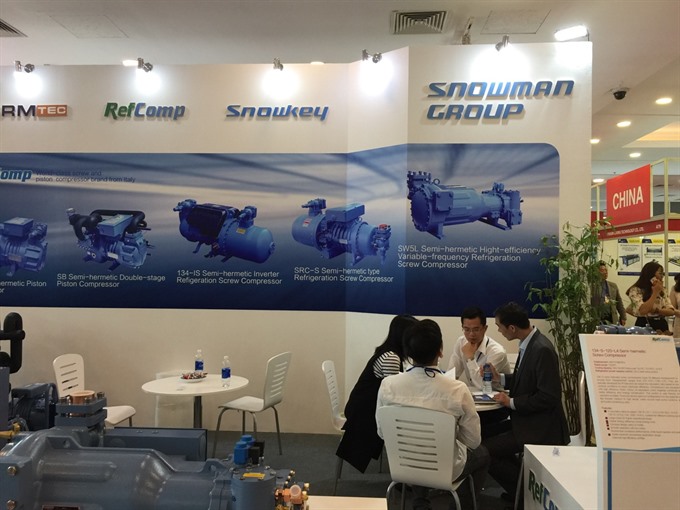 Over 200 domestic and foreign enterprises are taking part in the HVACR Việt Nam 2018, held in Hà Nội from April 18 to 20. More than 200 domestic and foreign enterprises are taking part in the International Exhibition on Heating, Ventilation, Air-Conditioning, Air Filtration and Purification and Refrigeration Systems (HVACR Việt Nam 2018). The exhibition, which kicked off on April 18, is being held in Hà Nội for the first time. The event has been organised in HCM City 11 times. The last edition was held in March 2017 and hosted more than 550 participating companies and brands and attracted 7,906 visitors. Jack Wei, general manager of Informa Global Exhibitions (Asia), one of the organisers of the exhibition, said among the participants this year are many famous international brands from China, India, Italy, South Korea, the United States, Malaysia, Singapore, Thailand and Turkey. At the event, they are introducing their latest equipment and technology, which will provide customers access to the convenience, safety and energy efficiency of the newest and best products in the market, Wei said. “We strive to inject fresh and exciting elements to each edition of HVACR Việt Nam so that both our exhibitors and visitors walk away empowered with new ideas, contacts and resources,” he added. The annual global event is considered the ideal platform for international manufacturers and suppliers to launch new products, reach out to buyers, appoint agents and distributors, promote brand awareness and establish business networks in Việt Nam’s booming economy. Throughout the three-day exhibition, a series of complimentary HVACR and Green Building seminars and technical talks will be held, hosted by HVACR Việt Nam organisers and its partners, namely the Việt Nam Green Building Council and Việt Nam Energy Efficiency Network. Park Byung-Hun, secretary general of the Korea Building Energy Management System Association that has set up a pavilion at this year’s exhibition, said: “Our association was established to contribute to the development of high efficiency and green buildings through the development of ‘building energy management technology’, which integrates construction technology, ICT (information and communications technology) and energy management technology, as well as systematic management of building energy facilities.” “HVACR Việt Nam 2018 is especially important to us, given the rising global attention on energy efficiency and the emphasis of this year’s exhibition on showcasing the related technologies,” he said. International beauty industry exhibition opens in HCM City
Visitors at the 2018 Cosmobeaute Vietnam that opened in HCM City on April 19. The Vietnam International Exhibition on Aesthetic, Beauty, Cosmetic, Hair, Nail and Spa, or Cosmobeauté Vietnam, opened in HCM City on Thursday with more than 200 exhibitors taking part. According to the organisers, 75 per cent of the exhibitors are from countries and territories such as Germany, Hong Kong, Italy, China, Japan, South Korea, Malaysia, Singapore, Spain, Taiwan, Thailand, and the US. The expo would enable the local beauty industry to source premium brands and enhance and extend its business opportunities, CP Saw, founder of Cosmobeauté, said. The exhibitors include manufacturers, exporters, distributors, agents, and suppliers of perfumery, cosmetic and personal hygiene products, natural health products, health foods and beverages, dietary supplements, professional care products, equipment and solutions for beauty salons, salon furnishing, spa and wellness facilities, packaging and processing equipment, private labels, and raw materials. There will be beauty workshops, seminars, live demonstrations, beauty shows and others with industry experts sharing know-how and experience and updating visitors on beauty trends. Organised by ECMI ITE Asia and the Minh Vi Exhibition and Advertisement Services Co at the Saigon Exhibition and Convention Centre in District 7, the expo which will go on until April 21 is expected to attract 13,500 visitors. Mining Viet Nam 2018 opens Mining Viet Nam 2018, an international mining and minerals recovery exhibition opened its doors on Wednesday at the International Centre for Exhibition in Ha Noi. The three-day expo attracted 137 enterprises from 18 countries and territories, including the UK, Czech Republic, Germany, Singapore, China and Australia. They are showcasing equipment, machinery and technologies used for mining in the 4,000 square metre site. Director of the Vinacomin Institute of Science and Technology Tran Tu Ba said that Vinacomin was willing to work with partners to bring technological advances used in mining to Viet Nam. Despite the global mining industry facing a recent slowdown, Mining Viet Nam 2018 continues to attract the participation of many domestic and international exhibitors. "This shows the optimism of the mining industry in Viet Nam, thanks to policies encouraging mineral exports and an increase in local demand,” said BT Tee, general director of UBM VES Company, the exhibition’s organiser said. During the event, three seminars will gather speakers to discuss breakthroughs and sustainability in mining, as well as advances in mining and underground works, and the use of modern technology in mining and management. They will also talk about the restoration of mineral resources, and environmental protection. Asia Miner, a well known Australian magazine specialising in mining and the exploitation of mineral resources, will continue its partnership with Viet Nam in the Regional Technical Conference Viet Nam 2018, with speakers from major foreign firms taking part. Participants will also discuss measures to improve mining output and safety standards in the field. The biennial event took place for the first time in 2012 and is considered one of the most trustworthy exhibitions in the mining industry in Viet Nam as well as in the wider Asia-Pacific region. It has become a bridge connecting domestic and foreign firms and diversifying advanced technologies and equipment. This year’s event is expected to draw more than 4,500 visitors. RoK investors hoped to be strategic partners in VN’s SOE equitisation As investors from the Republic of Korea (RoK) have financial strength, management experience and high technology, Vietnam wants them to actively take part in and become strategic partners in the equitisation and divestment of State capital from State-owned enterprises (SOEs). Finance Minister Dinh Tien Dung made the remark in an interview given to Vietnam News Agency on the sidelines of an investment promotion conference in the RoK on April 18. He said the Vietnamese Government recognises the role of foreign investors, including those from the RoK. The RoK investors’ participation in the equitisation and divestment will help improve the quality of economic restructuring in Vietnam. It is expected to promote the effectiveness of the governance and use of capital at SOEs in the country, he added. The minister said the fields that Vietnam wants to attract RoK investment in should be the ones both sides are strong at and can contribute to the two economies’ prosperity like heavy industry, oil refining and petrochemistry, high technology, electronic and consumer product manufacturing, and infrastructure and real estate development. Vietnam highly values RoK investors’ advantages in capital, technology and governance. It hopes that aside from direct investment, they will also step up indirect investment so as to materialise the statement of the two countries’ leaders during a visit to Vietnam by RoK President Moon Jae-in last March. The RoK is currently the biggest investor in Vietnam with 59 billion USD of direct investment and over 3 billion USD of indirect investment. Samsung projects in Thai Nguyen province, Bac Ninh province and Ho Chi Minh City, Kaengnam and Lotte buildings, and the Starlake residential area in Hanoi are considered examples of successful investment cooperation between the two countries. Meeting looks to increase Japanese presence in Mekong Delta A conference took place in Can Tho city on April 18 to connect Japanese partners with the Mekong Delta, where the presence of foreign businesses, including Japanese ones, is still modest compared to other regions of Vietnam. The event was among an array of activities marking 45 years of the two countries’ diplomatic ties. In the opening remarks, former President Truong Tan Sang said the conference aimed to promote investment cooperation between the Mekong Delta localities and Japanese partners. It was a new stride in Vietnam-Japan relations since the signing of a joint statement on the establishment of an extensive strategic partnership for peace and prosperity in Asia in 2014. Deputy Foreign Minister Bui Thanh Son said after years of making development efforts, the Mekong Delta, comprising 12 provinces and Can Tho city, has become a dynamic region full of development potential. The Vietnamese Government pins high hopes on this region, which is also attracting interest of many domestic and foreign investors. However, he said, the presence of foreign businesses, especially Japanese ones, in the Mekong Delta remains modest compared to other regions. Notably, most of Japanese investors have just concentrated their investment on Can Tho city. Meanwhile, unpredictable climate change in this region also poses risks to local economic and food security and social stability, he noted. He expressed his hope that through this conference, Japanese investors would understand more about the Mekong Delta in general and Can Tho city in particular so as to have long-term business orientations here. He also expected that they would stand side by side with the Vietnamese Government in preventing and addressing negative climate change impacts, helping to turn the Mekong Delta into a strong economic hub of the country. Introducing his city’s advantages, Chairman of the Can Tho People’s Committee Vo Thanh Thong emphasised that Can Tho boasts a favourable river port system linking with many regional localities, along with an international airport. It also has the most developed trade centres, education and healthcare services in the region. Those are the conditions helping the city attracting the most investment in the region over the past years. For his part, Japanese Ambassador to Vietnam Umeda Kunio said he will actively support the Mekong Delta in attracting Japanese investment. He will help them organise events to connect with Japanese businesses in line with the capacity and demand of each locality. The conference discussed cooperation in developing transport, health care, education-training and climate change adaptation infrastructure; locality-to-locality cooperation in culture, tourism and labour; and cooperation in agricultural investment. Sidelines activities included talks between the Mekong Delta localities and the Japanese Ambassador, and visits to industrial parks, projects needing investment, and Japanese companies in Can Tho. On this occasion, memoranda of understanding on cooperation were inked between the Foreign Ministry’s Department of Foreign Affairs of Localities and Vietnam Airlines and Jetstar, between the Bio-Technology Centre of An Giang province and Japan’s Hagihara company, between the An Giang Bio-Technology Centre and Japan’s Daimasa Engineering company, and between the Vietnam-Japan Friendship Association in Can Tho city and the Sakai-Vietnam Friendship Association. Vietnam expands seafood exports to China Promoting Vietnamese seafood exports to China was the main focus of a workshop held by the Vietnam Pangasius Association (VPA) and China’s Yuexi fisheries association in the Mekong Delta city of Can Tho on April 18. Vo Hung Dung, VPA Vice President, said Vietnam’s seafood export value to China rose from about 400 million USD in 2014 to 1.8 billion USD in 2017, helping China surpass the US to become the country’s biggest seafood importer. However, he pointed out the possibility of ending contracts ahead of schedule, thus putting Vietnamese businesses at risk. Therefore, it is necessary to be cautious while stepping up exports to this market, the official stressed. Cen Jian, a representative of the Yuexi fisheries association, suggested Vietnamese seafood firms ship their products via official channels to avoid the risk, protecting the interests of both exporters and importers. Ta Minh Phu, President of the Bac Lieu Seafood Association, raised concerns regarding China’s incentives and tax policies for Vietnamese aquatic products. In reply, the Chinese side said Vietnamese seafood businesses enjoy a preferential import tax rate of zero percent for the whole year, which is a great advantage for Vietnam compared with the rate of 2.5 percent imposed on Malaysia and Indonesia. Tran Thanh Phong, Deputy Secretary General of the VPA, said his association will implement five groups of solutions to promote exports to the Chinese market. The association aims to successfully materialise the Vietnam-China border trade agreement, set up trade links with Guangxi, Yunnan and Guangdong, utilise incentives fro the ASEAN-China Agreement, urge China to remove technical barriers in the sector and intensify trade promotion through exhibitions and fairs. On this occasion, the Chinese side released information about a seafood fair in Zhanjiang city from June 18-20, 2018, which is expected to draw about 200 businesses. Participating Vietnamese firms will be exempt from all costs and provided with market information, they said. Winners of Vietnam Property Awards honoured Around 54 winners of Vietnam National Property Awards were honoured at a ceremony held by the Vietnam Real Estate Association (VNREA) in Hanoi on April 14. The event was attended by Deputy Prime Minister Trinh Dinh Dung, alongside representatives of ministries, branches and central agencies and representatives of real estate companies. Prime Minister Nguyen Xuan Phuc and Politburo member, Secretary of the Party Central Committee (PCC) and head of the PCC's Communication and Education Commission, Vo Van Thuong, sent a bouquet of flowers to the event. Addressing the event, on behalf of the Government and the Prime Minister, Deputy PM Trinh Dinh Dung congratulated the winners, while highly appreciating the plan to hold the Vietnam National Property Awards. Meanwhile, he also asked the Ministry of Construction and the related ministries and branches to review and perfect the policies and legal framework on housing, land and planning, as well as tax and financial policies, real estate business activities in the direction of transparency and simplifying administrative procedures, and creating a favorable business environment for people and businesses. The Vietnam National Property Awards aims to honour outstanding individuals, organisations and projects that have contributed to the rapid, sustainable and transparent development of the realty market amidst industrialisation, modernisation and integration, thereby encouraging domestic property firms to improve their competitiveness and trademarks to meet international practices. Participants competed in eight categories, including prestigious real estate developer, largest urban area, best resort development, best office building for rent and shopping malls, best residential area, best green building, best real estate transaction floor and best social housing project. Vietjet among Top 10 Vietnam Excellent Brands in 2017 Budget carrier Vietjet Air was honoured as among the top ten strong brands with prestigious development in 2017 at the Golden Dragon Awards & Vietnamese Excellent Brands Festival 2017 – 2018, organised by the Vietnam Economic Times in Hanoi on April 14. The other top-ten businesses included Sun Group, MobiFone, Hung Loc Phat Real Estate Service JSC, TBS Group, Benthanh Group, Binh Dien Fertiliser JSC, Vissan JSC, Bach Dang Construction Corporation, and Southern Airports Services JSC. Vietjet has been voted as one of Vietnam’s excellent brands for years due to its unceasing efforts to grow and contribute to the community’s development. The development of the largest private airline not only helps to provide flight opportunities to millions of passengers, but also promotes Vietnamese brands to every Vietjet destination. Vietjet is the first airline in Vietnam to operate under a new-generation aviation model, offering low costs and providing a wide range of services for customers to choose from. Currently, Vietjet is operating 55 A320 and A321 aircrafts, carrying out more than 385 flights a day and has transported more than 55 million passengers, with 82 routes covering all destinations in Vietnam and international routes to Hong Kong (China), Singapore, the Republic of Korea, Taiwan, China, Thailand, Indonesia, Myanmar, Malaysia, and Cambodia. Ford dealership opens in Thai Nguyen Vietnam inaugurated an authorized dealership in the northern province of Thai Nguyen on April 11, taking to 37 the number of its dealerships in the country. Thai Nguyen Ford covers 10,000 square meters on Cach Mang Thang Tam Street in Thai Nguyen City in the province of the same name. The showroom has a total area of 2,600 square meters and the workshop 5,000 square meters. Thai Nguyen Ford is expected to service 100 vehicles a day. Down in the south, Dong Nai Ford put a new facility in Binh Long Ward in Bien Hoa City into operation on April 9. The new facility costs VND135 billion. Its workshop covering 4,500 square meters can provide maintenance service for 70-100 autos a day. Isuzu Vietnam launches first Euro 4 standard trucks The trucks introduced by Isuzu Vietnam on April 12 meet the Euro 4 emission standards. The industry has gradually switched from using Euro 2 engines to Euro 4 ones which are more environmentally friendly. Isuzu’s Blue Power technology is used for all Forward and QRK trucks. Only in Southeast Asia, the company’s new trucks are equipped with Isuzu Blue Power engines to improve performance, reduce noise and save fuel. Euro 4 engines with compatible fuel helps reduce 97% of coal dust and 71% of NO2, and hydrocarbon emissions. Vissan aims high for pre-tax profit Riding on the better-than-expected performance last year, Vissan, a leader in meat processing in the country, has set a target of making VND179 billion in pre-tax profit. The HCMC-based firm attained VND165 billion pre-tax profit last year, way above the VND156 billion target. Nguyen Ngoc An, general director of Vissan, said at the firm’s general meeting on April 11 that Vissan would be able to make VND4.6 trillion in revenue, up 18% year-on-year, and VND179 billion in pre-tax profit, up 8% against last year. The company will expand outlets, convenience stores and other sales channels. An said Vissan will have five more stores selling fresh products, develop mobile sale platforms, restore sales at traditional wet markets and gain a bigger market share for processed food in the countryside. The company plans to set up a livestock farm in Binh Duong Province to boost supply. A report released at the general meeting showed that in 2017 Vissan’s total sales revenue amounted to some VND3.9 trillion, making up just 86% of the plan. Its post-tax profit was about VND130 billion, up 143% against 2016. The dividend was 7% in 2017, equivalent to over VND56.6 billion. Enterprises decry high seafood origin certification fee Local enterprises have decried the VND700,000 fee charged by fishing port operators for certifying the origin of each catch of aquatic products, demanding that the fee be slashed to VND200,000, Nguoi Lao Dong newspaper reports. The Vietnam Association of Seafood Exporters and Producers (VASEP) has written to the Ministry of Agriculture objecting to the fee. VASEP said the certification fee, imposed in accordance with Circular 230/2016 of the Ministry of Finance, goes against the principle that fee collection is meant to cover costs because the cost of certifying the origin is small. Vietnam’s seafood catch is required to have the origin certified after the European Commission issued a yellow card against illegal, unreported and unregulated fishing. VASEP said the Government has sought to lower costs for enterprises, so the fee should be revised down to VND200,000 a batch only. Besides, port operators should fully perform their mandate to issue origin certificates as required, said VASEP. In fact, several port operators have failed to carry out that mandate as they are short of personnel as well as essential equipment like scale, computer, or photocopier, which renders enterprises helpless in the process of completing legal procedures for seafood export. A lot of Vietnam seafood shipments to the European Union have been delayed due to the lack of required documents. Consequently, many enterprises have had to compensate or have their contracts cancelled because of delays. Banks cut deposit rates Many banks have slashed deposit interest rates by 20-40 basis points given their ample liquidity, Tien Phong newspaper reports. Vietnam Prosperity Commercial Bank (VPBank) has lowered rates by 20 basis points for deposits of less than six months, 30 basis points for six- and seven-month tenors, and 40 basis points for savings of between eight and 11 months. This is the third deposit rate cut of VPBank in two months. Vietnam International Bank (VIB) also adjusted down its rates last month. The rate for savings of one to three months is now 5.1%, down 30-50 basis points against January, while six-month savings get a rate of 6-6.3% depending on the size of deposit, a decline of 20-40 basis points. At Military Bank (MB), the rate for six-month deposits is now 5.5%, down from 5.7% in early February. Meanwhile, the rate for the 12-month term is kept unchanged at 7.2%. The deposit rates are even lower at commercial banks with State holdings. The Vietnam Bank for Industry and Trade (VietinBank) has reduced the rate ceiling for six- to eight-month savings by 50 basis points to 4.8%. However, the rates for most long-term tenors from 12 months to less than 36 months are unchanged at 6.8-6.9%. The Bank for Investment and Development of Vietnam (BIDV) also revised down its rates twice last month. In the first reduction, the rate for one- to two-month savings was down by 20 basis points. In the second adjustment last month, BIDV cut the rate for deposits of 364 days and 13 months by 10 basis points. The bank’s current rates for savings of one to two months and longer than 12 months are 4.1% and 6.8-6.9% respectively. In general, banks tend to reduce their rates for short-term deposits by 20-40 basis points. The rates are 10-30 points higher than late last year. It is noteworthy that the difference between the rates at joint stock banks and State-owned banks is as high as 50-90 points for tenors of less than 12 months. According to the National Financial Supervisory Commission, the loan-to-deposit ratio last month was 88.2%, up from 87.8% late last year. Liquidity in the banking system is ample as the State Bank of Vietnam has bought huge amounts of foreign currencies and the disbursement of capital raised from Government bond sales is slow. Capital mobilized from economic organizations and individuals in the first quarter of the year rose 3% over the end of last year and was higher than the average last year (2.6%). In addition, credit growth in the first three months of 2018 was reported at 3.5% against late last year while the rate was 4.3% in the same period last year. The interbank market also saw a plunge of 0.47-1.2 of a percentage point in deposit rates for overnight, one-week and one-month tenors to 0.83%, 0.98% and 1.73% respectively. Three economic and industrial zones get new financial boost The Government has set aside a near US$1 billion budget in the 2016-2020 period to develop infrastructure for economic and industrial zones, news website Lao dong reports. Under the Prime Minister’s Decision 351/QD-TTg, infrastructure will be developed for coastal economic, border economic, industrial, high-tech and high-tech agriculture zones to facilitate investment and foster technology development and application at a total cost of almost VND21 trillion in 2016-2020. By 2020, 200-250 kilometers of road, water drainage and wastewater treatment systems with a daily capacity of 13,000-14,000 cubic meters, technical and social infrastructure of resettlement areas covering 150-200 hectares will be built. The PM assigned the Ministry of Planning and Investment to work with the Ministry of Finance to draw up a plan for allocating capital to the projects under the decision. HCMC launches Innovative Startups in Tourism Saigon Innovation Hub has announced a contest for innovative startup projects in the tourism sector with an aim to have scores of feasible projects to get financial support annually for commercialization. According to the organizer, the contest is to be made an annual event to look for startup projects with sound solutions, feasible products and high technological contents aligned to the city’s tourism development. The HCMC Department of Science and Technology and the Department of Tourism will jointly organize the HCMC Innovative Startups in Tourism (HIST) in 2018. Those projects participating in the Innovative Startups in Tourism will have a chance to get funding from the city’s program for supporting startups projects called SpeedUp. Startup ideas about travel, accommodation, tourist transport, and payment for the sector among others will be given priority in the program. The projects will be evaluated based on factors such as novelty, innovation, technology application, economic efficiency, and social impact. The organizer expects to have some 40 projects presented to judges, and then 20 projects will go to mentoring and training rounds. Apart from awards for projects in the final round, the organizer will take the five best projects into consideration to fund up to VND2 billion from the SpeedUp program of the HCMC Department of Science and Technology. The final round will take place in October 2018 on the occasion of the HCMC Innovative Startups in Tourism Week. Customs officers implicated in fuel smuggling case in Binh Thuan Smuggling activities of Duong Dong Hoa Phu Co. in the south-central province of Binh Thuan were helped by officers at the provincial customs department, according to a local newspaper. A Tuoi Tre Online report said the Supreme People’s Procuracy has finished an indictment alleging that 12 were involved in the fuel smuggling case in Binh Thuan. The volume of smuggled fuels amounted to hundreds of thousands of tons and was worth over VND2 trillion. The case has been transferred to the People’s Court of Binh Thuan Province for trial. Dinh Huu Thuy, who was in charge of inspecting import shipments of Duong Dong Hoa Phu Co., has been charged with taking bribes and Le Van Vinh, Thuy’s colleague, with abusing position and power while on duty, said the report. Thuy admitted receiving VND12 million from Nguyen Tuan Anh, an employee of Duong Dong Hoa Phu Co., in each import shipment inspection. Thuy kept VND3 million for himself, handed over VND3 million to Vinh and the remainder to a team at the department. Thuy took almost VND150 million in total from Anh, according to the report. Investigators at the Ministry of Public Security found that Vo Van Toan, director of the customs department, Ta Hung Dung, deputy director of the department, and Luu Trong Vu, head of the team that got money from Thuy, failed to supervise and monitor their staff’s work. An interdisciplinary team headed by the investigative force of the Ministry of Public Security inspected BTS Christina tanker, owned by BTS Tankers in Singapore, on January 29, 2016 and found A92 gasoline was being pumped from the ship to the storage tank of Duong Dong Hoa Phu Co. in Tuy Phong District. Inspection results showed the company formally declared import of over 1,800 tons of gasoline. But at the time of inspection, BTS Christina was found to be carrying 9,300 tons and more than 3,200 tons had already been pumped from the vessel. The inspection team concluded that Duong Dong Hoa Phu Co. had smuggled over 7,200 tons of A92 petrol, worth VND155 billion. Between October 2015 and January 18, 2016, Duong Dong Hoa Phu Co. was found to smuggle in some 100,000 tons of fuel worth over VND2 trillion. Of these, the company sold more than 120 million liters of fuel, generating revenue of over VND1.3 trillion. Nguyen Duc Manh, chairman and general director of the company, was identified as the one who signed fuel import documents. Philippine national Romels Pagente Aleria, captain of BTS Christina, has also been prosecuted for allegedly illegally transporting goods across borders, said the news report. The report quoted the indictment as saying that Romels Pagente Aleria transported more than 7,200 tons of A92 petrol worth nearly VND155 billion, which was different from what was declared in import documents. Vietnam’s sticky rice price takes sudden nosedive The sticky rice price in Long An Province has suddenly dropped to VND9,600 per kilo from VND11,000 around 10 days ago due to a sharp fall in Chinese purchases, delivering a blow to traders and exporters, news website Vietnamplus reports. Dang Van Thanh, CEO of Viet Thanh Limited Co., said 80-90% of sticky rice output has been exported to China via border trade. But in the last two weeks, all orders by Chinese importers have been suspended, resulting in a commercial sticky rice price slump, Thanh added. Traders had earlier placed deposits of VND4-5 million per hectare of sticky rice to guarantee purchase of the imminent crop from farmers at VND6,100 per kilo, and are now facing huge losses as the market price tumbled to only VND5,300 per kilo when harvest comes. In recent years, the demand for sticky rice has been running high, propping up prices and leading farmers in Long An Province and elsewhere in the Mekong Delta to expand cultivation of this commodity. According to statistics of Long An’s Department of Agriculture and Rural Development, in the winter-spring crop, there was 85,000 hectares of sticky rice with average output of eight tons per hectare. Chinese importers suddenly stopped buying it, hitting Vietnamese exporters and traders hard, while farmers saw their harvested crop piling up. If traders choose to buy all output as agreed, they would lose VND800 per kilo. If they choose to abandon their deposits of VND4-5 million per hectare, their losses would average out at VND500 million to VND1 billion given the large area under contract. Nguyen Ngoc Long, owner of Ngoc Long enterprise, said given the volatile sticky rice price, Vietnamese exporters have suspended buying sticky rice from traders and farmers while waiting for the price to rebound. Long proposed the Government and relevant agencies to lend a helping hand in finding new markets. RON 95 petrol still has no base price The Ministry of Industry and Trade has yet to announce the base price of RON 95 gasoline as stipulated in Government Decree 83 on transparency of fuel pricing and as required by Deputy Prime Minister Vuong Dinh Hue. In the latest adjustment of fuel prices late last week, the ministry mentioned the instruction by Deputy PM Hue on announcement of the RON 95 base price in line with the law and market rules. Fuel experts earlier proposed the ministry make known the base prices of all fuels after RON 92 gasoline was banned from the market early this year. However, the ministry just put the average price of RON 95 petrol on global markets in the first quarter of the year at nearly US$80 per barrel, up US$3.76 or 4.94% year-on-year. The ministry also encouraged fuel traders to raise the selling price of RON 95 by a maximum of VND526 per liter from the current price. Vietnam National Petroleum Group (Petrolimex), the country’s biggest fuel trader, then increased the RON 95 price by VND520 per liter last Saturday. The ministry can use global prices, taxes and fees as a basis to calculate the base price of RON 95. Nguyen Tien Thoa, chairman of the Vietnam Valuation Association, said the ministry’s protracted delay to publicize the RON 95 base price runs counter to the Government’s directive and affects the interests of local consumers. Why the ministry has persistently refrained from making known the RON 95 base price remains a mystery. Bao Viet Holdings' 2017 net profit up 37% Bao Viet Holdings recorded consolidated net profit of VND32.7 trillion ($1.5 billion) in 2017, representing 113.4 per cent of its annual plan and up 37.6 per cent, according to its latest financial report. It yet again holds the leading position in Vietnam’s insurance market. Total assets as at December 31, 2017 were VND91.4 trillion ($4 billion), up 25.2 per cent, while owners’ equity was VND14.4 trillion ($631.7 million), up 5.7 per cent against the end of 2016. After-tax profit on charter capital stood at 15.1 per cent. Its stock (BVH) was one of the most stable in the VN30-Index. In the opening months of this year it increased sharply, closing at VND107,000 ($4.70) on April 9, for capitalization of over $3 billion. With stable business results, large capitalization, and high trading volumes, BVH has become a popular destination for cash flows from long-term investors and international investment funds. Life insurance grew strongly, with total revenue at more than VND22 trillion ($1 billion). This was the second consecutive year Bao Viet Life has led the market, holding the Number 1 position in terms of market share of new revenue and total revenue. Bao Viet Life was also named Best Life Insurance Company in Vietnam by the prestigious World Finance magazine. The non-life insurance sector surpassed its revenue target, reaching nearly VND10 trillion ($438,730). Some businesses grew handsomely and contributed significantly to new insurance revenue, such as motor vehicle insurance (up 29.8 per cent), voluntary health insurance, and fire insurance and special risk insurance (up 24.6 per cent). The securities sector saw remarkable success in brokerage revenue. The Baoviet Securities Company (BVSC)’s brokerage market share was approximately 5 per cent, up nearly 40 per cent compared to 2016 and putting it in the Top 5 companies with the largest market share on the Ho Chi Minh Stock Exchange (HSX) for two consecutive quarters. Lufthansa Technik AG looking for opportunities in aircraft maintenance Numerous German firms have visited and expressed their desire to co-operate and invest in transport infrastructure in Vietnam. In particular, Germany’s Lufthansa Technik AG proposed to invest German Deputy Ambassador to Vietnam Wolfgang Manig shared at a meeting with Deputy Minister of Transport Le Dinh Tho recently that so many German firms want to invest in the Vietnamese transport sector, such as in seaports, railway modernisation, automobile, and mechanics. In addition to transport in the aviation sector, aviation mechanics is also a potential area. Thereby, Lufthansa Technik AG and Vietnam Airlines Engineering Company (VAECO) are discussing co-operation opportunities in aircraft maintenance and they need the approval of the Ministry of Transport (MoT) for this plan. The representative of Lufthansa Technik AG said that they plan to develop an internal maintenance facility for narrow-body aircrafts then evolve it into a maintenance and overhaul facility not only for Vietnamese but also regional customers. Lufthansa Technik AG (Lufthansa Engineering) is one of the world’s leading providers of aircraft maintenance, repair, and overhaul (MRO) services for civil aircrafts as well as its engines and components. It is a subsidiary of Lufthansa Group. Tho confirmed the two-digit average growth (around 15 per cent in the last ten years) of Vietnam’s civil aviation. This sector holds great potential and MoT is working to approve and create favourable conditions for VAECO and Lufthansa Technik to seek co-operation opportunities. Earlier, a delegation of foreign enterprises (including Greenland Holding Group, Vision Transportation Group, and VIPD Group) has come to look for co-operation opportunities in Vietnam’s transport infrastructure. The leader of MoT shared information of key transport projects. According to the plan for the road sector, 2,000 kilometres of the North-South Expressway will be put into use by 2020. 654km of this is developed under the public-private partnership (PPP) format. Vietnam is also formulating plans for the North-South high-speed railway to submit to the National Assembly in 2019. The Hanoi-Vinh and Saigon-Nha Trang sections will be developed first. Several international airport projects such as Noi Bai, Tan Son Nhat, Long Thanh, Danang, Can Tho, and Cam Ranh are being developed, while the expansion project of Tan Son Nhat International Airport has just been approved. Vietnam will build a new 20-hectare terminal with the capacity of 20 million passengers at the southern end of the airport, next to the existing terminals. It is estimated to cost a total of VND18 trillion ($0.8 billion). The area at the northern end of the airport would be used to build supporting structures, such as more cargo terminals and plane maintenance, logistics, and food processing facilities. These are good chances for foreign investors to co-operate and invest in this sector. Long Thanh International Airport has officially selected the lotus design. This airport will cover 5,000ha with an investment of $16.03 billion to raise the capacity to 100 million passengers and 5 million tonnes of cargo annually. Garment sector needs manpower development strategies: workshop To develop and enter global supply chains, the textile-garment industry needs to have strategies for developing high-quality human resources right from now, insiders said at a recent workshop in Ho Chi Minh City. Pham Xuan Hong, Chairman of the HCM City Association of Garment, Textile, Embroidery and Knitting (AGTEK), said at the event on April 14 that textile-garment is not only a spearhead export industry of Vietnam but also one of the sectors generating the biggest numbers of jobs, about 2.5 million. However, most of employees in the sector are manual workers in charge of simple steps while the steps requiring technical skills like dyeing or designing are facing a shortage of skilled workers. Hong said the shortage of high-quality manpower is also one of the reasons why local production of apparel materials remains undeveloped and Vietnam has to depend on imported materials. Meanwhile, the steps generating high added value like designing products and building brands are still limited. Although Vietnam is one of the five biggest apparel exporters in the world, global consumers haven’t known any Vietnamese fashion brands, he said. Dr Pham Xuan Thu from the HCM City College of Foreign Economic Relations said only about 30 percent of over 6,000 textile-garment businesses in Vietnam operate in textiles, including weaving, dyeing, printing and finishing fabric. Most the remaining firms make products ordered by foreign fashion brands. Only few of them are able to create their own products, from manufacturing fabric, designing to making apparel. Many companies still have to hire foreign experts and technicians at high costs to be responsible for dyeing, completing fabric and designing products, thus augmenting production costs and reducing their products’ competitiveness compared to foreign rivals, he added. Amidst growing integration and competition, to retain development and engage in global textile-garment value chains, the country needs to invest in training and improving manpower quality in an appropriate manner, participants in the workshop said. Dr Thu said the textile-garment sector has expanded to a certain size and now it’s time for it to make changes in quality, which means switching to the stage creating more added value. To do that, the sector has to restructure both production and manpower, he noted, adding that only when labour quality increases can businesses make use of material sources well, raise labour productivity and improve management capacity to boost their competitiveness. He suggested them invest more in manpower training, recruit and give intensive training to committed employees, and offer appropriate salary and bonus to encourage workers to make self-improvement. Another problem facing textile-garment companies is that their employees tend to switch to other firms to look for better opportunities after getting training and experience. Therefore, to keep employees, aside from appropriate salary, businesses should also create conditions for workers to show their capacity, create a friendly work environment and pay attention to workers’ spiritual needs, Thu said. At the workshop, AGTEK Chairman Hong also called for more active participation of State management agencies and training schools to boost training in the textile-garment industry. National conference seeks ways to reduce logistics costs Ways to reduce logistics costs and improve transport connectivity were the main topics of a national conference held in Hanoi on April 16 under the chair of Prime Minister Nguyen Xuan Phuc. A World Bank report showed that the expenses for logistics services accounted for 20.9 percent of Vietnam’s gross domestic product (GDP), of which transportation costs amount to 59 percent. According to the Ministry of Transport, the shipping costs of a 40 feet container from Hanoi to Ho Chi Minh City (excluding loading and unloading costs) is estimated at 40 million VND (1,762 USD), 9.7 times higher than that of sea routes and 2.5 times higher than that of railways. The high costs of road transportation is due to unhealthy competition as transactions are conducted mainly through intermediaries and transport businesses have failed to optimise their operations, Deputy Minister of Transport Nguyen Van Cong explained, adding that the costs of oil and petrol make up around 30-35 percent while the toll fees account for about 10-15 percent. Meanwhile, the transportation via railways, inland waterways and sea routes has yet been upgraded with long transport time and expensive loading and unloading services, he said, adding that the connectivity between transport businesses is limited and the information sbout the market demand is insufficient. To reduce logistics costs, the Ministry of Transport said it is necessary to invest in building a national expressway network to ensure effective connectivity to industrial parks, key economic centres, border gates, seaports, railway stations, and inland water ports. The railway sector needs to build goods transportation stations and upgrade loading and unloading facilities and warehouses to provide common services for all transport enterprises. Additionally, it is recommended to develop container transportation via inland waterways. The transport ministry suggested forging transport connectivity between seaports, roads, railways and inland waterways. Meanwhile, the aviation sector needs to develop freight services by establishing a cargo route network, encouraging investors to build regional cargo airports, and providing incentives for airlines to open routes to the cargo airports. VNN |
↧
Article 1
In Vietnam, a mega casino rises with the help of a Macau junket companyChinese tourists to Vietnam are expected to be the main players here while local Vietnamese are forbidden from casino gambling
 A model of the resort project by Suncity with nearby constructions is shown at Hoiana, Vietnam March 26, 2018. Picture taken March 26, 2018. Photo: Reuters Along a three-kilometer (2-mile) stretch of coastline in central Vietnam, construction cranes are digging up mounds of sand and rubble where the country’s biggest casino is set to open next year. When completed, the $4 billion Hoiana project will extend across almost 1,000 hectares, and also include shops, restaurants, golf courses and water parks. Driving the project is Suncity Group Holdings Ltd, which has made billions luring high-rollers – mainly from China – to the baccarat tables in the Chinese territory of Macau. Vietnam is betting big on developing a gambling industry, targeting the Chinese tourists who have been flocking to the country in recent years. In addition to Hoiana, two other casinos, one in Van Don in the northern province of Quang Ninh, and one on Phu Quoc island in the south, are also under construction. The two projects will be part of a pilot program that would allow Vietnamese citizens to gamble at casinos for the first time. Hoiana will be the first casino owned by Suncity, which will have a one-third stake in the project. VinaCapital, a Vietnamese investment management and real estate firm, and the Hong Kong-based VMS Investment Group will also have similar-sized stakes. “The government really wishes to bring tourism here,” said Henry Tam, project director of Hoi An South Development, the local company which is building Hoiana. He added that development of the area would also include a school and sports stadium for local residents. “This is a 15-20 year project,” he said. “The area is four times the size of Macau’s Cotai strip.” The Hoiana project comes with challenges. Local Vietnamese will not be allowed to gamble at the casino and operations are subject to Vietnam’s uncertain regulatory environment. Competition around Asia is also heating up, with Macau, the world’s largest gambling center, building more resorts, and South Korea and the Philippines expanding their casino footprints. Other countries like Singapore also compete in the sector.
Ho Tram, a multi-billion dollar casino project located a two-hour drive from Ho Chi Minh City, had construction delays and financing problems before it opened in 2013. The casino - which is owned by Asian Coast Development, headed by the hedge fund manager Philip Falcone - has struggled to attract foreign gamblers to its remote location. There are fewer than 10 casinos in Vietnam, mostly smaller ones outside major cities. At present, only foreign passport holders can enter and gamble in them. Suncity executives are optimistic for Hoiana, citing strong government backing, local support through VinaCapital and large-scale infrastructure works like the four-lane highway that will connect it to Danang’s international airport 40 kilometers away. And they are pinning their hopes on Chinese tourists. In 2017, Vietnam welcomed 4 million Chinese visitors, up 49 percent from the previous year. The first phase of the project, which includes a 140-table casino and a golf course, is due to open in 2019. The second phase, which will add a lagoon, water park, second golf course, entertainment village and four more beach resorts, is slated to open by 2023. Anthony Chiu, Suncity’s chief financial officer, said the cost of the first phase was $650 million, of which VinaCapital, Suncity and VMS have put in around $70 million each, with the rest coming from bank financing. Companies associated with Chow Tai Fook Enterprises, headed by the Hong Kong billionaire Henry Cheng, are building 100 villas and a 1,176-room hotel as part of the first phase. In addition to Hoiana, Suncity has also signed a management service agreement for the Van Don project in the north. Van Don is scheduled to open in 2019 according to Suncity but details are scarce on the nature of the development. Foreign investors are required to invest over $2 billion in order to qualify for casino licenses. Las Vegas operators including Las Vegas Sands have been interested in setting up in Vietnam for several years. But Sands has said it would only invest in a casino if locals were allowed to gamble there. Casino expansion For Suncity, the stakes are high in Hoiana. Booming gambling revenues in Macau have created enormous wealth for junket operators like Suncity, who bring in players from mainland China and collect their debts. But as tighter regulatory controls and a lack of space crimps further development in Macau, junkets have been trying to expand overseas. Their role remains critical for Asian casinos eager to attract Chinese players, as gambling debts are not legally enforceable in China. Suncity is responsible for all the casino operations in Hoiana, including bringing in VIP players. Macau’s government will also soon be deciding on whether to allow new contenders to set up casinos in the glittering enclave once the six existing licenses start to expire from 2020. Suncity’s 34 percent stake in Hoiana will help position it as a contender for a casino license in Macau, said Grant Govertsen, an analyst at Union Gaming in Macau. Suncity’s executive director, Andrew Lo, said Hoiana also gave the company an opportunity to be in control of an operation rather than just a service provider. “I think it’s a very good investment,” he said. “Our marketing strategy is that we will become the entertainment hub of the Danang and Hoi An area.” By Reuters/Tuoitrenews |
↧
More Pages to Explore .....
